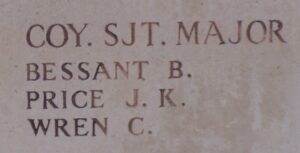Haverfordwest is the County Town of Pembrokeshire, and serves as the main Market Town for the County. Sitting on the tidal limited of the Western Cleddau, Haverfordwest has an ancient History, with its Norman Castle dating from the 1100’s. The majority of the town, comprising the old parishes of St Mary, St Martin and St Thomas, lies on the west bank of the river. On the left bank are the suburbs of Prendergast and Cartlett. The Town is the site of the Pembroke County War Memorial, but also has a War Memorial to the men of Haverfordwest Town, which is sited outside the Chapel of Withybush Hospital. The Memorial is unusual as it is made of glazed ceramic tiles. There are just as many men from the town of Haverfordwest who are not commemorated on this memorial as those who are, so their names have been added to this page, and are marked as such. Many thanks to Paul Childs for supplying the photograph of the Memorial used below.
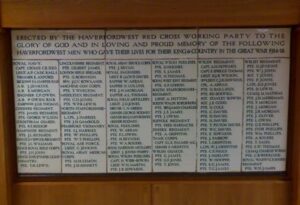
The Great War, 1914-1918
William Victor Adams, Corporal, 79810, Royal Field Artillery. William was born at Prendergast, Haverfordwest. He was a shunter with the GWR prior to the war, and had enlisted at Haverfordwest into the Royal Field Artillery on 14 August 1914. On 18 January 1915 William married his pregnant girlfriend, Gertrude Nellie Wilson, at St. Thomas Church, Haverfordwest, and she set up home at 70, Bush Street, Pembroke Dock, where their daughter, Phyllis Winifred, was born three months later. (She was later Gertrude Ball, of 18, Margaret Street, Ammanford). William was posted to ‘B’ Battery, 88th Brigade, RFA, attached to the 19th (Western) Division. The Division crossed to France during July 1915, moving to positions near Loos. The Division fought during the opening attack of the Battle of Loos, and then moved to the Somme, where they took part in the second wave of the attack on Ovillers-La Boiselle on 1 July 1916, capturing the village at heavy cost, and fought through the Somme Battles, and it was during the Battle of Pozieres that William was killed in action, on 28 July 1916. He was 23 years old, and is buried at Caterpillar Valley Cemetery, Longueval. William is not commemorated on the Withybush Memorial.
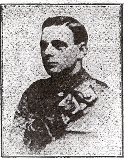
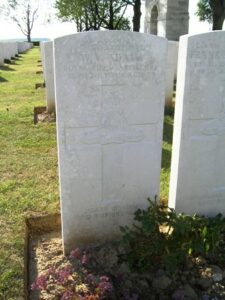
Harry Montague Allen, Private, 20965, Welsh Regiment. Harry was born in Prendergast, Haverfordwest in 1896, the eldest son of Thomas and Edith Allen. Thomas was a Plumber with Great Western Railway, and was transferred to their Depot at Whitland, where the family made their home at 3, Glendale Terrace. Harry worked as a Carpenter at the Llanelli Depot of the GWR, and enlisted there into the 15th Battalion, Welsh Regiment, which was the Carmarthen Pals Battalion. The battalion trained at Rhyl and Winchester, before moving to France during December 1915, attached to 114 Brigade, 38th (Welsh) Division, and over the winter and spring of 1916, held nearly every section of the British line from Givenchy on the La Bassée Canal to Laventie, about six miles South of Armentières. At the end of May 1916, the Battalion moved South with the remainder of the 38th (Welsh) Division to the Somme area, in readiness for the First Battle of The Somme, which commenced on 1 July 1916. The 38th Division were tasked with the taking of the infamous Mametz Wood. The first attack on Mametz Wood was on 7 July, when the division lost heavily in ‘Death Valley’ during the advance on the ‘Hammer Head’. The next attack went in three days later, finally clearing the wood after two days of hand to hand fighting, but at the cost of over 5,000 casualties in the 38th (Welsh) Division. It was during the first attacks on the wood that Harry was mortally wounded. He was shot in the chest by a German sniper, and brought back by rail to the 38th Casualty Clearing Station at Heilly, in the Somme valley. Harry died of his wounds on 11 July 1916, and was buried at Heilly Station Cemetery, France. Harry is not commemorated on the Withybush Memorial.
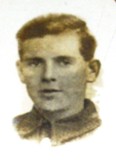
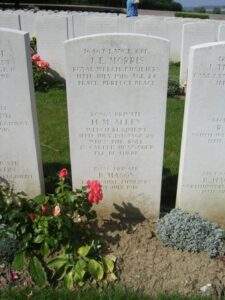
William Henry Allen, Private, 20100, Welsh Regiment. William was the son of James and Frances Hannah Allen, of Doulting, Somerset. He resided at Haverfordwest prior to the war, and enlisted there into the 15th Battalion, Welsh Regiment, known as the Carmarthen Pals battalion, attached to 114 Brigade, 38th (Welsh) Division. The Division had landed in France during December 1915 and had spent their first winter in the trenches near Armentieres. In June they marched south to the Somme, where they were tasked with the capture of Mametz Wood. The attack on the wood began on 7 July 1916, but met with fierce resistance, and was called off until a fresh attempt was made three days later. William was killed during an assault on the Wood on 11 July 1916, aged 20. He has no known grave, and is commemorated on the Thiepval Memorial, France. William is not commemorated on the Withybush Memorial.
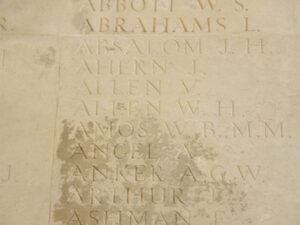
Ernest George Stanley Anderson, Private, 64105, Machine Gun Corps. Ernest was born at Haverfordwest, and resided at 24, Grove Place, St. Thomas Green, Haverfordwest with his Grandmother. He was the Nephew of Mrs. B. E. Owen, of 67, Brynhyfryd Road, Briton Ferry, Glamorgan. He enlisted at Haverfordwest on 10 December 1915 into the Welsh Regiment, with the Regimental Number 6212. On 11 February 1917 he arrived in France, and joined the 32nd Company, Machine Gun Corps. During March 1918 Ernest was transferred to the 11th Battalion, Machine Gun Corps, which was attached to the 11th (Northern) Division. The Division didn’t see any major fighting for some months after the Passchendaele Offensive had been closed down, until fighting in August 1918 at the Battle of the Scarpe, during the Second Battles of Arras. The Allies were now in the ascendency, and began the great push that was to force the Germans into losing the war, and the Division fought at the Battle of Drocourt-Queant, the Battle of the Canal du Nord, then at the Battle of Cambrai at the beginning of October. From here they took part in the Pursuit to the Selle, and it is around this stage of the offensive that Ernest was killed on 4 October 1918. He was 24 years old, and is buried at Chapel Corner Cemetery, Sauchy-Lestree, France. Ernest is not commemorated on the Withybush Memorial.
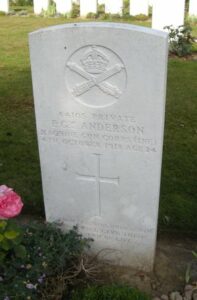
Alfred Arran, Private, 2001, Welsh Regiment. Alfred was the son of John and Mary Arran, of 41, Quay St., Haverfordwest, and the husband of Sarah Arran, of 5, Maeryerngran Cottages, Priory Street, Carmarthen. He enlisted at Haverfordwest into the 8th Battalion, Welsh Regiment, which was attached to 40 Brigade, 13th (Western) Division. Towards the end of February the entire Division concentrated at Blackdown in Hampshire. On 7 June 1915, orders were received to prepare to move to the Mediterranean. On 13 June 1915 the first transports carrying the Division left port, and moved to Alexandria. By 4 July, all units had moved to Mudros, preparatory for landing on Gallipoli. Between 6 and 16 July 1915 the Divisional infantry landed on Cape Helles and relieved the 29th Division. They left and returned to Mudros at the end of the month, and the entire Division landed at ANZAC Cove between 3 and 5 August 1915, taking part in the Battle of Sari Bair. Alfred was killed in action here on 8 August 1915. He was 36 years old. Alfred has no known grave, and so is commemorated on the Helles Memorial, Gallipoli.
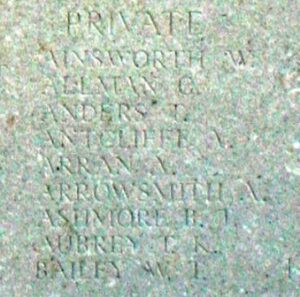
William Arran, Private, 78532, Royal Fusiliers. William was the Stepson of Mrs. Thomas, of 9, Holloway Street, Haverfordwest. William enlisted at Haverfordwest into the Army Service Corps, and had the Regimental Number T2/017640. William later transferred into the 1st Battalion, Royal Fusiliers, which was attached to 17 Brigade, 6th Division. The Division had been on the Western Front since 1914, and had fought through most of the major Battles. In the spring of 1918 the Division was one of those hit by the German Offensive on the Somme, which had been launched on 21 March, and the Division took part in the Battle of St Quentin. They were moved from the line, and went to Flanders to rest, but the following month the Germans launched another offensive on the Lys, and the Division fought during the Battle of Bailleul, the First Battle of Kemmel, and the Second Battle of Kemmel. During August 1918 the Allies had recovered sufficiently to be able to launch their own attacks on the Germans, and after a brilliant victory at Villers Brettoneux on 8 August 1918, attacks were launched at Albert. The 6th Division took part in the Advance in Flanders, before moving south, where they took part in the advance on the Hindenburg Line, during the Battle of Epehy, and then at the Battle of the St Quentin Canal. Once the Line had been breached, the Division took part in the Battle of Beaurevoir and the Battle of Cambrai, before the final Pursuit to the Selle and the Battle of the Selle, where they saw the end of the war out. William was killed in action less than a week before the end of the war, on 5 November 1918. He was 23 years old, and is buried at Cross Roads Cemetery, Fontaine-au-Bois, France.
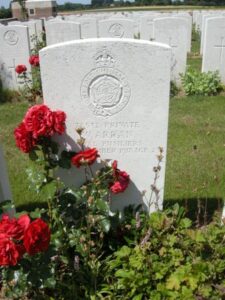
Ernest Axford, Trimmer, 302TS, Royal Naval Reserve. Ernest was born on 16 July 1896 at Milford Haven, and was the Adopted son of Simon and Elizabeth Davies, of 15, Perrotts Terrace, Barn Street, Haverfordwest. He served with the Royal Naval Reserve, aboard H.M. Trawler Kirkland. She was requisitioned during August 1914, for service as a mine sweeper. Ernest was drowned when the Kirkland struck a mine off Fugla Skerry, Papastour, Shetlands, on 20 August 1917. He was 21 years old, and is commemorated on the Plymouth Naval Memorial, Devon. Many thanks to Shirley Thomas for the photograph.
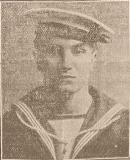
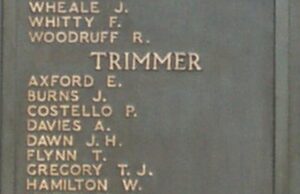
George Alfred Baillieux, Private, 389, Welsh Regiment. George was the son of Lambert Francis and Eliza Anne Baillieux, of 3, St. Mary’s Street, Haverfordwest. He enlisted at Haverfordwest into the 1/4th Battalion, Welsh Regiment. The Battalion was formed in Carmarthen in August 1914 and joined 159 Brigade, 53rd (Welsh) Division. The Division moved to the Mediterranean, sailing from Devonport in July 1915, arriving at Mudros by 5 August 1915. From here they moved to Gallipoli, landing on 8 August 1915. Here they immediately faced the chaotic leadership that was to lead to the ultimate failure of the campaign, and spent the next few days in isolated pockets, fighting against a Turkish counter-attack. The Division remained here throughout the coming months, and suffered severe losses here. George was taken ill on Gallipoli, and evacuated by Hospital Ship to the Military Hospital at Lemnos, where he sadly died on 29 September 1915. He was just 18 years old, and is buried at Portianos Military Cemetery, Lemnos, Greece.
D’Arcy Valentine Bendall, Lance Corporal, 57239, Welsh Regiment. D’Arcy was born at Haverfordwest in 1888, the son of Francis James Bendall, and Alice Lavinia Bendall. By 1901 the family was residing at Derby, where his father ran his own Solicitors business. D’Arcy worked at Swansea as a Clerk prior to the war, and resided at Lea Cottage Thistleboon, Mumbles. He enlisted at Cardiff on 24 October 1914 into the 7th (Cyclist) Battalion, Welsh Regiment, and on 26 July 1917 was posted to France, joining the 13th Battalion, Welsh Regiment, which was at Ypres attached to 114 Brigade, 38th (Welsh) Division. The Division had landed in France during December 1915 and had spent its first winter in the trenches near Armentieres. In July 1916 it had famously captured Mametz Wood. The Division suffered terrible casualties at Mametz, and was taken out of the line, and moved to Ypres to rebuild. Here they fought at the Battle of Pilckem Ridge, where D’Arcy was killed on 30 July 1917. He is buried at Bard Cottage Cemetery, Belgium. D’Arcy is not commemorated locally.
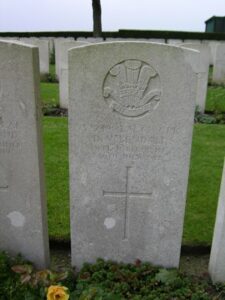
James Allen Bevan, Driver, T4/254138, Army Service Corps. James was the son of James and M. Bevan, of 1, Ebenezer Row, Haverfordwest. He served with the Army Service Corps, and was posted to Salonika, where he served as a Driver with the 857th Horse Transport Company. James died at Salonika on 24 November 1918, aged 23, and is buried at Mikra British Cemetery, Kalamaria.
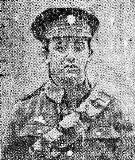
Robert Frederick Bishop, Private, 17141, Coldstream Guards. Robert was the son of John Henry and Emma Bishop, of Haverfordwest. He enlisted there into the 1st Battalion, Coldstream Guards, which was stationed at Aldershot at the outbreak of war, attached to the 1st (Guards) Brigade, 1st Division. In August 1914 the Battalion moved to France, and saw their first action at the Battle of Mons, and the retreat to the Marne, where the Germans were stopped. They then fought at the Aisne, and at Chivy, before being moved North to Ypres. Here they fought at the First Battle of Ypres, where they again stopped the German Offensive, before wintering in Flanders. The following year saw them in action again at the Battle of Aubers, before moving South to Loos, where they joined the 2nd Guards Brigade, Guards Division, on 25 August 1915. This Division has the distinction of being formed in France in August 1915, of the various Guards units that had been with other Divisions. It remained on the Western Front throughout the war and saw its first major action during the Battle of Loos on 25 September 1915, remaining in the area during the coming months, where they also fought in the subsequent Action of Hohenzollern Redoubt. In July 1916 the Division moved to the Somme, where they fought at the Battle of Flers-Courcelette, and then at the Battle of Morval, capturing Lesboeufs Village. Robert was killed in action here on 29 September 1916. He was 26 years old, and is buried at Guard’s Cemetery, Lesboeufs, France.
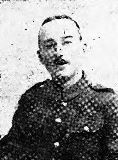
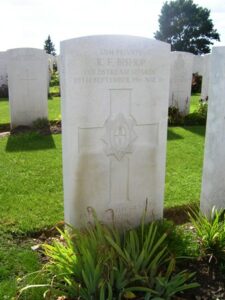
Nathaniel Abraham Boswell, Private, 58617, Welsh Regiment. Nathaniel was born at Swansea, the son of William and Mary Jane Boswell. The family later moved to 34, Quay Street, Haverfordwest. He enlisted at Haverfordwest on 20 October 1915 into the Cheshire Regiment, with the Regimental Number 4009. On 12 February 1917 Nathaniel was posted to the Welsh Regiment, and sent to the Base Depot at Kirkee, India. On 26 May 1917 he was posted to the 8th Battalion, Welsh Regiment, which was attached to 40 Brigade, 13th (Western) Division. The Division had fought at Gallipoli, before moving into Mesopotamia, as part of the forces which attempted the relief of Kut. The Division then fought at the Battle of Kut al Amara, and remained in Mesopotamia for the remainder of the war. Nathaniel died of heatstroke in Mesopotamia on 20 July 1917. He was 22 years old and is buried at Baghdad (North Gate) War Cemetery, Iraq. Nathaniel is not commemorated on the Withybush Memorial.
Richard Boswell, Private, 36328, Welsh Regiment. Richard was born in Wolverhampton in 1875, and was the husband of Charlotte Boswell, of 7, Lilleshall Street, Newport, Monmouth. He served with the 2nd Battalion, Welsh Regiment, which was attached to 3 Brigade, 1st Division. The Division had been one of the first to arrive in France, fighting at the Battle of Mons, and taking part in the retreat to the Marne, where the Germans were stopped. They then fought at the Aisne, and at Chivy, before being moved North to Ypres. Here they fought at the First Battle of Ypres, where they again stopped the German Offensive, before wintering in Flanders. The following year saw them in action again at the Battle of Aubers. They remained in the area over the winter, and it was here that Richard was killed on 3 January 1916. He was 40 years old, and has no known grave, and so is commemorated on the Loos Memorial, France. Richard may have been stationed locally with the 2nd Welsh prior to the war.
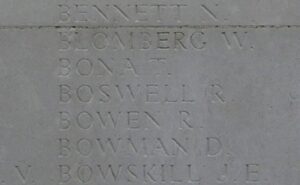
Stanley Thomas Bowen, Sergeant, 11, Welsh Regiment. Stanley was the only son of Alfred and Hannah Bowen, of Prendergast, Haverfordwest. He married in 1905, and resided at 70, Prendergast, Haverfordwest with his wife Gertrude M. Bowen (nee Clarke), and their two daughters. Stanley enlisted at Haverfordwest into the 1/4th Battalion, Welsh Regiment, which was attached to 159 Brigade, 53rd (Welsh) Division. The Division moved to the Mediterranean, sailing from Devonport in July 1915 arriving at Mudros by 5 August 1915. From here they moved to Gallipoli, landing on 8 August 1915. Here they immediately faced the chaotic leadership that was to lead to the ultimate failure of the campaign, and spent the next few days in isolated pockets, fighting against a Turkish counter-attack. Stanley was killed in action here on 10 August 1915, aged 29. He has no known grave, and so is commemorated on the Helles Memorial, Gallipoli. Gertrude later remarried, and emigrated to Erindale, Ontario, Canada.
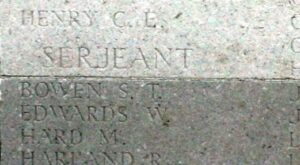
Cyril Francis Wogan Bowen-Rowlands, Private, 765642, London Regiment. Cyril was born in Haverfordwest in 1880, the son of William Bowen-Rowlands, MP, QC, and Adeline Rowlands. Prior to the war the family resided at London. Cyril had fought during the Boer War, becoming a successful businessman in Hong Kong in the ensuing years, but remaining a Territorial soldier, and married Carmen Smith in Hong Kong on 19 June 1909. After the outbreak of war, Cyril returned to Britain to enlist. On 2 March 1917 he re-enlisted at London into the 1/28th Battalion (Artists Rifles), London Regiment. The battalion formed for war on 4 August 1914, at Duke’s Road, Euston Road, London, as Army Troops attached to the 2nd London Division. In August the Artists moved to the St. Albans area, and in October 1914 left 2nd London Division and landed in France on 28 October 1914, becoming an Officers Training Corps at Bailleul. On 28 June 1917 the Artists Rifles joined 190 Brigade, 63rd (Royal Naval) Division. The Artists joined the Division at Ypres, where they prepared for the attack on Passchendaele Ridge, and Cyril joined the battalion here on 13 September 1917. Cyril was killed in action during the Artists assault on Passchendaele Ridge on 30 October 1917. He was among 350 casualties suffered by the battalion that day. Cyril has no known grave, and is commemorated on the Tyne Cot Memorial, Belgium. He is not commemorated on the Withybush Memorial.
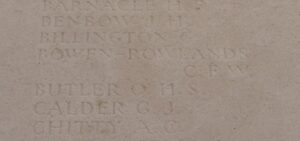
Albert William Burrows, Private, 34198, South Lancashire Regiment. Albert was the son of Mrs. Mary Elizabeth Ann Frost, of Seaview Terrace, Cornhill, Highbridge, Somerset. He worked as a Traction Engine driver prior to enlisting at Haverfordwest into the Welsh Regiment on 1 September 1914, and was posted to the 9th Battalion, Welsh Regiment, which was attached to 58 Brigade, 19th Division, landing in France with the division during July 1915. He was invalided home with appendicitis for a while, before returning to France on 20 July 1916, initially joining the 16th Welsh before being transferred to the 8th Battalion, South Lancashire Regiment, which was attached to 75 Brigade, 25th Division. The division was in the line near Ploegsteert, and remained there until taking part in the Battle of Messines in June 1917. Albert was wounded here, and died of his wounds at the 1st Australian Casualty Clearing Station on 14 June 1917, aged 22. He is buried in Bailleul Communal Cemetery Extension, France. Albert is not commemorated locally.
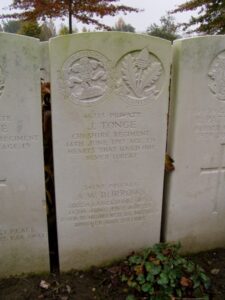
Ernest Samuel Candlin, L/Corporal, 10105, Kings Shropshire Light Infantry. Ernest was born at Horsehay, Dawley, Shropshire, the son of Robert and Ellen Candlin. Ernest resided at Haverfordwest prior to the war. He married Gwendoline Main in 1916, and the couple had a son, Ernest Arthur Candlin, who later resided at 26, Front Street, Pembroke Dock. Ernest enlisted at Wellington, Shropshire into the King’s Shropshire Light Infantry, and served with their 1st Battalion, attached to 16 Brigade, 6th Division. On 10 September 1914 the Division landed at St Nazaire and proceeded to the Western Front, and arrived in time to reinforce the hard-pressed BEF on the Aisne, before the whole army was moved north into Flanders. Here they took part in the Action of Hooge during June 1915, and in 1916 moved to the Somme, where the Division fought at Flers-Courcelette, and at Morval. Ernest was killed at Morval on 25 September 1916. He was 32 years old, and is commemorated on the Thiepval Memorial, France. Ernest is not commemorated on the Withybush Memorial.
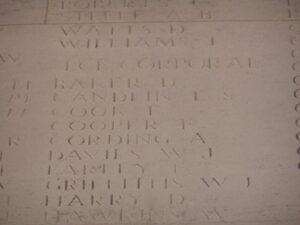
Benjamin James Charles, Private, 86460, Kings Liverpool Regiment. Benjamin was the son of John and Elizabeth Charles, of 79, Dew Street, Haverfordwest. He had enlisted at Haverfordwest into the South Wales Borderers, but had later transferred into the 6th Battalion, Kings Liverpool Regiment, which was attached to 165 Brigade, 55th (West Lancashire) Division. The division relieved the 42nd (East Lancashire) Division in the front line at Givenchy and Festubert on 15 February 1918, and faced numerous strong enemy raids in March. April was at first much quieter, but it was a lull before the storm, as the Germans launched another offensive here, with the Division taking part in the Battle of Estaires, successfully fighting at the First Defence of Givenchy, the single most famous action that the Division fought. Benjamin was wounded during the Battle of Estaires, and died on 29 April 1918 as a result. He was just 18 years old, and is buried at Pernes British Cemetery, France.
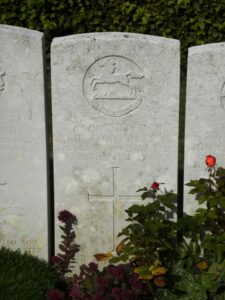
James Ernest Codd, Sergeant, 2297, Welsh Regiment. James was born at Haverfordwest in 1871, the son of William Evans Codd and Martha Codd. He married Mary Ann Lewis at Haverfordwest on 12 August 1896, and the couple resided at 9, North Gate Terrace, Haverfordwest, where James worked as a Yeast Merchant. Between 12 March 1899 until 31 March 1908, James also served with the 1st Volunteer Battalion, Welsh Regiment, and on 13 April 1908 enlisted at Haverfordwest into the newly formed 4th Battalion, Welsh Regiment, the local Territorial unit. James attended the annual camp several times over the coming years, and at the outbreak of the Great War was embodied for service with ‘A’ Company, 4th Welsh at Haverfordwest. James was by now a Sergeant, and remained on Home Service with the 2/4th Welsh, assisting with the training of new recruits for the front line 1/4th Welsh. James was discharged from the army as medically unfit on 30 September 1916 after becoming ill with bronchial asthma and a hernia. He died on 27 January 1917 at Haverfordwest, aged 45, and is possibly buried at St. Martins Churchyard, Haverfordwest.
George Cole, Private, 44192, Welsh Regiment. George was the son of William and Hannah Cole, of 9, Bethany Row, Narberth Road, Haverfordwest. He enlisted at Haverfordwest into the 17th Battalion, Welsh Regiment, which was attached to 119 Brigade, 40th (Bantam) Division. This Division was formed between September and December 1915, composed of bantam units and others which had a mixture of regulation-height and shorter men. Weeding out of very under-sized or unfit men delayed the training programme, and it was not until late Spring 1916 that the Division was ready to proceed on active service. The Division moved to France during June 1916, and moved to the front near Loos. Late in 1916 they moved south to the Somme, and fought at the Battle of the Ancre, and remained in the area over the winter. In March 1917 the Germans withdrew to their shortened line, called the Hindenburg Line, and the 40th Division was one of the Divisions that followed the withdrawal. George was wounded here, and died of wounds on 25 April 1917, aged 23. He is buried at Fins New British Cemetery, Sorel-Le-Grand, France.
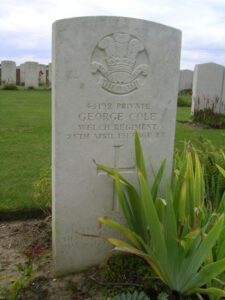
Harold Edmund Collins, Sapper, 15477, Royal Engineers. Harold was the son of James and Mary Collins, of Northgate, Haverfordwest, and the husband of Bessie Collins, of Welcheston Lodge, Woolhope, Hereford. He had enlisted at Swansea into the Royal Engineers, and was posted to their 5th Field Company. The Company was sent to the Western Front with the BEF at the outbreak of war, and took part in the fighting at Mons, and in the epic retreat south to the Marne. The Germans were stopped at the Marne, and the BEF followed their retreat back north to the Aisne, where they met in Battle. Harold was wounded here, and died of wounds on 9 October 1914. He was 30 years old, and is buried at Soupir Churchyard, France.
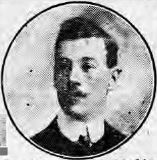
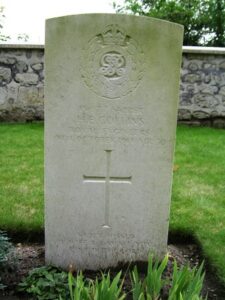
Austin Pugh Cook, Lieutenant, Royal Marine Light Infantry. Austin was the son of Charles Pugh and Mary Ann Cook, of 21, Bridge Street, Haverfordwest. He had been commissioned into the Royal Marine Light Infantry, and served with the 2nd Royal Marine Battalion, Royal Naval Division. The Naval Brigades were originally sent to Antwerp and Dunkirk in September and October 1914 to guard against invasion by the Germans. However, Antwerp fell to the Germans soon after, and so many of the RND units were withdrawn to England. After a lengthy period of refit and training the Division moved to Egypt preparatory to the Gallipoli campaign. Landing on 25 April 1915 the Division fought throughout the Campaign on Gallipoli. They were transferred from the authority of the Admiralty to the War Office on 29 April 1916, and was re-designated the 63rd (Royal Naval) Division on 19 July 1916. The Division moved to France, arriving at Marseilles between 12 and 23 May 1916 and moved to positions on the Somme, where it took part in the Battle of the Ancre, and the resulting Operations on the Ancre. In April 1917 the Division was at Arras, and fought at the Second Battle of the Scarpe, where they captured Gavrelle. They then fought at the Battle of Arleux. Austin was killed in action near Gavrelle on 26 July 1917. He was 23 years old, and is buried at Naval Trench Cemetery, Gavrelle, France.
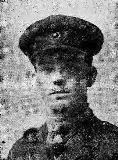
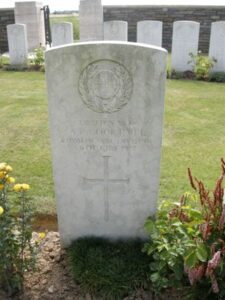
James Cousins, Bombardier, 41925, Royal Field Artillery. James was the son of William and Sarah Cousins. His father had died prior to the war, and his mother Sarah remarried, moving to 8, Upper Market Street, Haverfordwest. James had worked with his uncle at Clareston Farm, Freystrop prior to the war, and was 27 years old when he enlisted in October 1914 into the Royal Field Artillery. James served in France for the duration of the war, but in July 1918 he was seriously gassed and wounded in the leg, and discharged from the army. He returned home, and died at Clareston Farm, Freystrop, on 21 November 1918, aged 27. James was buried with full military honours at Haverfordwest (Freystrop) Cemetery. James is not commemorated on the Withybush Memorial.
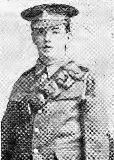
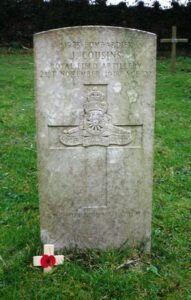
Francis Newton Allen Cromie, CB, DSO, Captain, Royal Navy. Francis was the son of Captain Charles Francis Cromie, of Cincinatti, Ohio. Charles served with the Hampshire Regiment, and was the Consul General, at Dakar. Francis was the husband of Josephine Cromie, of 9, Old Park Rd., Clapham Common, London. His maternal Grandparents lived in Haverfordwest, and were Thomas Ince Webb-Bowen, and Catherine Luther Anne Bowen (nee Allen). Francis had taken part in suppressing the Boxer Uprising in Peking, and then joined the Royal Navy Submarine Service in 1903. In 1915 he navigated the submarine HMS E19 through Oresund into the Baltic Sea, to prey on iron ore transports from Sweden to Imperial Germany. Francis was the commander of the British submarine flotilla in the Baltic during World War I, and in May 1917 he was appointed the Naval Attaché in Petrograd (Saint Petersburg) 1917 was the year of the Russian Revolution, and Francis was captured by the Revolutionists. On 31 August 1918 Francis was shot dead in front of the British Embassy in Petrograd. He was 36 years old, and is commemorated on the Archangel Memorial in Saint Petersburg. Francis had been highly decorated throughout his Naval Career. He was a Chevalier, Legion of Honour; Order of St. Vladimir with Swords (Russia); Cross of St. George (Russia). Awarded Royal Humane Society’s Medal (1906). He was also Mentioned in Despatches during the Boxer Rebellion.

C. Davies, Private, Welsh Regiment. This man cannot presently be identified.
David Davies, Private, 8828, Welsh Regiment. David was born at Haverfordwest, and enlisted there into the 2nd Battalion, Welsh Regiment. The Battalion was attached to 3 Brigade, 1st Division, which had been one of the first to arrive in France, fighting at the Battle of Mons, and taking part in the retreat to the Marne, where the Germans were stopped. They then fought at the Aisne, and at Chivy, before being moved North to Ypres. David was wounded during this time, and was evacuated to the Base Hospital at Boulogne for treatment, but he sadly died of wounds there on 27 October 1914. He is buried at Boulogne Eastern Cemetery, France.
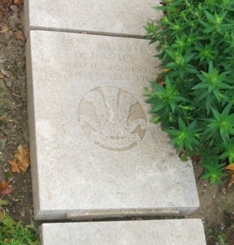
Henry Davies, Private, 26934, Welsh Regiment. Henry was born at St. Martins, Haverfordwest, and enlisted there into the 1st Battalion, Welsh Regiment. The Battalion was in India at the outbreak of war, and was recalled to Britain, where it joined 84 Brigade, 28th Division. The Division formed in England between December 1914 and January 1915 from regular units returning from India, Singapore and Egypt. During January 1915 it moved to France, landing at Le Havre and moved to the Western Front, where it saw its first major action during the Second Battle of Ypres. The Division took part in the Battle of Loos on 25 September 1915, and remained in the sector for the coming weeks. Henry was killed in action just before the Division was pulled from the line to embark for Salonika, on 2 October 1915. He has no known grave, and so is commemorated on the Loos Memorial, France.
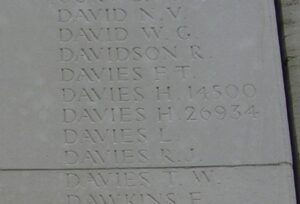
Reginald Leslie Davies, Sapper, 157938, Royal Engineers. Reginald was born at Haverfordwest in 1891, the son of Thomas Herbert Davies and Elizabeth Anne Davies. By 1901 the family had moved to 10, Ynysderw Road, Pontardawe. Reginald enlisted at Cardiff into the Royal Engineers, and served with the 180th Tunnelling Company. The Tunnelling Companies had been formed in response to German tunnelling during 1915. They were used to dig mines beneath German positions, to dig dugouts and shelters for troops, and for other similar work. Reginald was killed while his Company was at Arras on 10 August 1916, probably whilst digging the tunnels and mines ready for the forthcoming Arras Offensive the following year. He was 25 years old and has no known grave, and so is commemorated on the Arras Memorial, France. Reginald is not commemorated on the Withybush Memorial.
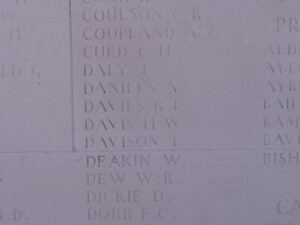
Robert Lloyd Davies, Lieutenant, Royal Engineers. Robert was the eldest son of J.M. Lloyd Davies and Maud Davies of ‘Glanafon’, Haverfordwest. He was commissioned into the Royal Engineers, and served with the 129th Field Company, attached to the 24th Division. They moved to France during August, 1915 and marched to positions near Loos, where they took up reserve positions for the main Battle of Loos. The Division were sent into battle on 26 September 1915 at Loos and suffered terrible casualties due to not being properly trained for battle, and were pulled from the line until the following year. In 1916 they took part in the Battle of the Somme, and fought at Delville Wood and Guillemont, before moving north of Arras in early 1917. In April and May 1917 they fought at the Battle of Vimy, alongside the Canadian Corps. Robert was killed in action here on 12 April 1917. He was 29 years old, and is buried at Aix-Noulette Communal Cemetery Extension, France.
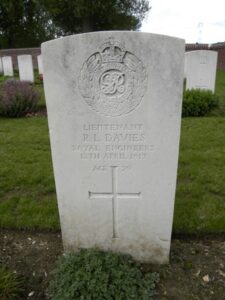
Thomas Picton Davies, Private, 30919, Welsh Regiment. Thomas was the son of the late James and Maria Davies, of 47, Old Bridge, Haverfordwest. He lived at Swansea prior to the war, and enlisted at Pembroke into the 9th Battalion, Welsh Regiment, attached to 58 Brigade, 19th (Western) Division. The Division assembled around Bulford during September 1914. Divisional training was completed near Tidworth, from March 1915, and the Division crossed to France during July 1915, moving to positions near Loos. The Division fought during the opening attack of the Battle of Loos, and then moved to the Somme, where they took part in the second wave of the attack on Ovillers-La Boiselle on 1 July 1916, capturing the village at heavy cost, which is where Thomas was killed on 3 July 1916. He was 38 years old, and has no known grave, and so is commemorated on the Thiepval Memorial, France.
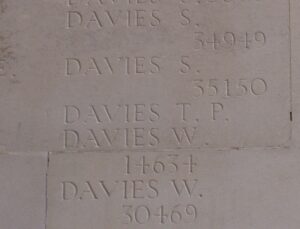
William Davies, Driver, W/5254, Royal Field Artillery. William was born at Haverfordwest, and enlisted there into the Royal Field Artillery. He served with “C” Battery, 122nd Brigade, which was attached to the 38th (Welsh) Division. The Division had landed in France during December 1915 and had spent their first winter in the trenches near Armentieres. In June they marched south to the Somme, where they famously captured Mametz Wood. The Division suffered terrible casualties at Mametz, and were taken out of the line, and moved to Ypres to rebuild. Here they fought at the Battle of Pilckem Ridge, and the Battle of Langemarck. William was wounded at sometime during these Battles, and died of his wounds at a Casualty Clearing Station on 31 August 1917. He is buried at Dozinghem Military Cemetery, Belgium. William is not commemorated on the Withybush Memorial.
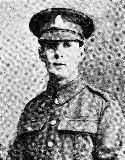
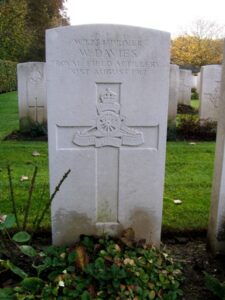
William Davies, Private, 56621, Royal Welsh Fusiliers. William was born at West Ham, London. Prior to the War he was engaged as a Farm-Hand at Haverfordwest, and enlisted there into the army. William was posted to the 1st Battalion, Royal Welsh Fusiliers, which had been in France since 6 October 1914 attached to 22 Brigade, 7th Division. The Division had fought at First Ypres, and in March 1915 fought at the Battle of Neuve Chapelle. During May they fought at Aubers Ridge, and at Festubert, before taking part in the Battle of Loos in September. In the summer of 1916, the Division was on the Somme, and took part in the Battle of Albert, where they captured Mametz, one of the few successes of 1 July 1916. They then fought at Bazentin, and the Attacks on High Wood. The Division then fought at Delville Wood, and Guillemont, before spending the winter on the Ancre. In March 1917 they followed up the German Retreat to the Hindenburg Line, and fought at Bullecourt. Later in the year the Division moved to Ypres, and fought at Polygon Wood, Broodseinde, Poelcapelle and the Second Battle of Passchendaele. William was wounded at Polygon Wood. He was evacuated to the Casualty Clearing Station at Remy Sidings for treatment, but died of wounds there on 3 October 1917. He was just 21 years old, and is buried at Lijssenthoek Military Cemetery, Belgium. William is not commemorated on the Withybush Memorial.
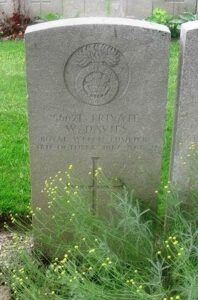
William Davies, Private, 220, Welsh Regiment. William was born at Haverfordwest and enlisted there into the 1/4th Battalion, Welsh Regiment. The Battalion had been formed at Carmarthen during August 1914 and became attached to 159 Brigade, 53rd (Welsh) Division. The Division moved to the Mediterranean, sailing from Devonport in July 1915, arriving at Mudros by 5 August 1915. From here they moved to Gallipoli, landing on 9 August 1915. Here they immediately faced the chaotic leadership that was to lead to the ultimate failure of the campaign, and spent the next few days in isolated pockets, fighting against a Turkish counter-attack during the Battle of Sari Bair, and then at the Attack on Scimitar Hill. William was wounded during the first few weeks at Gallipoli and evacuated for treatment at Mudros Island. He died there on 28 September 1915, and is buried at East Mudros Military Cemetery, Gallipoli. William is not commemorated on the Withybush Memorial.
William Charles Ronald Davies, Private, 200098, Welsh Regiment. William was the son of William and Ethel Davies, of 2, Cambrian Place, Haverfordwest. He enlisted there into the 1/5th Battalion, Welsh Regiment, which was attached to 159 Brigade, 53rd (Welsh) Division. The 53rd Division moved to the Mediterranean, sailing from Devonport in July 1915 arriving at Mudros by 5 August 1915. From here they moved to Gallipoli, landing on 8 August 1915. Here they immediately faced the chaotic leadership that was to lead to the ultimate failure of the campaign, and spent the next few days in isolated pockets, fighting against a Turkish counter-attack. The Division remained here throughout the coming months, and suffered severe losses in manpower strength during the great November 1915 blizzard on Gallipoli, when its total strength was reduced to less than that of a full-strength Brigade. On 11 December 1915 the Division was evacuated to Mudros, and by 23 December 1915 were moved to Egypt. They remained on the Suez Canal Defences for the next twelve months, and in early 1917 moved into Palestine, where they remained for the duration of the war, fighting at the Battles of Gaza, and successfully capturing Jerusalem. William was killed in action during the Third Battle of Gaza, on 3 November 1917. He was just 21 years old, and is buried at Beersheba War Cemetery, Egypt.
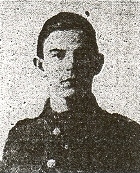
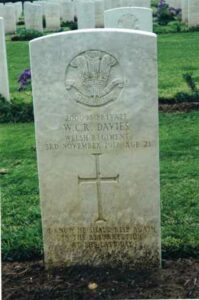
Charles John Randle Dawkins, Second Lieutenant, Welsh Regiment. Charles was the Only son of Thomas and Clara Randle Dawkins, of Redhill, Haverfordwest. He was educated at Haverfordwest Grammar School and at Clifton College, and was a B.A. and LL.B. of Cambridge, having taken a First in Law and a second in the Historical Tripos. Charles was commissioned into the Welsh Regiment at the outbreak of war, and was posted to the 9th Battalion, which was attached to 58 Brigade, 19th (Western) Division. The Division assembled around Bulford during September 1914. Divisional training was completed near Tidworth, from March 1915, and the Division crossed to France during July 1915, moving to positions near Loos. The Division fought during the opening attack of the Battle of Loos, which is where Charles was killed in action, during the initial attack of 25 September 1915. He was 24 years old, and is buried at Brown’s Road Military Cemetery, Festubert, France.
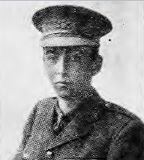
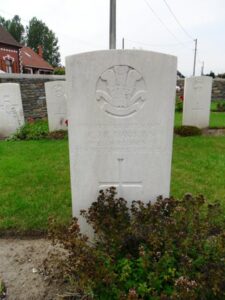
Charles Francis Devon, Sergeant, 1379, Welsh Regiment. Charles was the son of Charles Frederick and Elizabeth Devon, of 68, Edgeware Street, Edge Hill, Liverpool. He worked at Haverfordwest prior to the war and had enlisted there into the 2nd Battalion, Welsh Regiment. The battalion crossed to France in August 1914 attached to 3 Brigade, 1st Division, and took part in the retreat from Mons to the Marne. They then fought at the Aisne, and at Chivy, before being moved north to Ypres. Here they fought at the First Battle of Ypres, where they again stopped the German Offensive, before wintering in Flanders. The following year saw them in action again at the Battle of Aubers, before moving South to Loos, where they fought during the Battle of Loos, and the action at the Hohenzollern redoubt. Again they were required for a major offensive, moving south to the Somme, where they fought during the opening of the Somme Offensive. Charles was wounded on the Somme, and died on 16 July 1916, aged 21. He is buried in St. Sever Cemetery, Rouen, France. Charles is not commemorated locally.
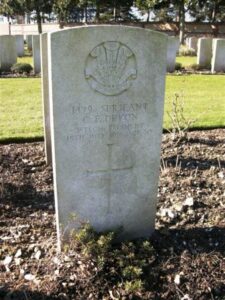
Gerald Alexander Dutton, Second Lieutenant, South Staffordshire Regiment. Gerald was the second son of Samuel and Alice Dutton, of Montrose, Merlin’s Hill, Haverfordwest. He was educated at Haverfordwest Grammar School, before being commissioned into the South Staffordshire Regiment. He was posted to the 4th Battalion, which was a Home Service unit, stationed at Jersey until 1916. Sadly Gerald was accidentally killed by a bomb explosion during training on Jersey, on 5 May 1916, aged just 18. He is buried at St. Peter Churchyard, Jersey.
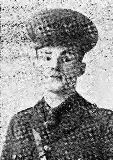
Seaward Richard Edmond, Sapper, 606, Royal Engineers. Seaward was born on 6 July 1865, the son of Seaward Richard and Mary Edmond, of Priory Cottage, Haverfordwest. He resided with his wife Esther Jane Edmond, and their eleven children at 11, Kingsland Road, Victoria Park, Canton, Cardiff prior to the war. Seaward had been a long serving soldier even before the outbreak of war, as he held the Long Service and Good Conduct Medal. He enlisted at Cardiff into the Royal Engineers, and was posted to No. 1 Glamorgan Works Company. Seaward died in France on 25 January 1915, just five months into the war. He was 51 years old and is buried at Longuenesse (St. Omer) Souvenir Cemetery, France. Seaward is not commemorated on the Withybush Memorial. His son Alfred Thomas Edmond, who had been born and raised in Cardiff, was killed on 29 January 1915, whilst serving with the 1st South Wales Borderers, and is commemorated on the Le Touret Memorial, France.
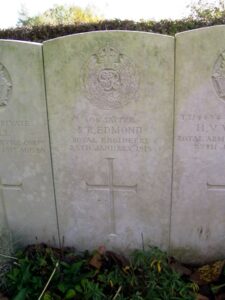
Andrew Edwards, Private, 6263, Australian Infantry. Andrew was the son of John Edwards, of Old Oven Farm, Haverfordwest. He had emigrated to Australia prior to the war, where he enlisted at Ballarat, Victoria on 2 August 1916 into the 8th Battalion, Australian Infantry. He embarked at Melbourne on 11 September 1916, bound for England and arrived at Plymouth on 26 October aboard the SS Euripides. On 17 December Andrew moved to France, where he joined his Battalion, which was attached to the 2nd Australian Brigade, 1st Australian Division. The Division had not long come out of the Battle of the Somme, where they had suffered terrible casualties during the Battle of Pozieres and at Mouquet Farm. They wintered on the Somme, and Andrew took ill here, being hospitalised for a short while from 8 February 1917. He rejoined his Battalion a month later, when they were in the process of following up the German withdrawal to the Hindenburg Line. Andrew was injured here, and hospitalised again, rejoining the Battalion in the middle of May. The Division then fought at the Battle of Bullecourt that month, and at the end of July moved north to Ypres. Here they fought in the Third Battle of Ypres. Andrew was admitted to the 6th Australian Field Ambulance at Ypres, on 20 September 1917 during the Battle of the Menin Road. He was evacuated to the Casualty Clearing Station at Remy Sidings, where he died of wounds on 21 September 1917. He was 33 years old and is buried at Lijssenthoek Military Cemetery, Belgium. Andrew is not commemorated on the Withybush Memorial.
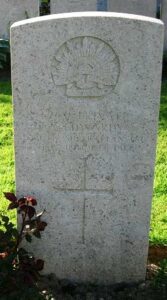
Edgar Gordon Edwards, Private, 5352, Welsh Regiment. Edgar was the son of William and Martha Edwards, of 101, Albert Town, Haverfordwest. He enlisted at Carmarthen into the 1/4th Battalion, Welsh Regiment, which was attached to 159 Brigade, 53rd (Welsh) Division. The 53rd Division moved to the Mediterranean, sailing from Devonport in July 1915 arriving at Mudros by 5 August 1915. From here they moved to Gallipoli, landing on 8 August 1915. Here they immediately faced the chaotic leadership that was to lead to the ultimate failure of the campaign, and spent the next few days in isolated pockets, fighting against a Turkish counter-attack. Edgar was killed soon after landing, on 10 August 1915, aged 27, during the Battle of Sari Bair (Attack on Scimitar Hill). He has no known grave, and so is commemorated on the Helles Memorial, Gallipoli.
James Edwards, Sergeant, 8276, Welsh Regiment. James was the son of Charles H. and Elizabeth Edwards, of 43, Merlin’s Hill, Haverfordwest. He was a reservist who was recalled to the colours at the outbreak of war, joining the 2nd Battalion, Welsh regiment, which was attached to 3 Brigade, 1st Division. The Division had been one of the first to arrive in France, fighting at the Battle of Mons, and taking part in the retreat to the Marne, where the Germans were stopped. They then fought at the Battle of the Aisne, and at Chivy Ridge, which is where James was killed in action on 14 September 1914, aged 29. He has no known grave, and is commemorated on the La Ferte-Sous-Joarre Memorial, France. James is not commemorated on the Withybush Memorial.
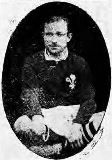
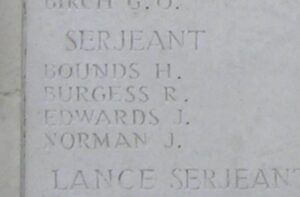
John Robinson Edwards, Private, 23080, Royal Welsh Fusiliers. John was born at Hubberston in 1885, the son of Martha Edwards. The family later resided at 42, Milford Road, Haverfordwest. John enlisted at Haverfordwest into the 9th Battalion, Royal Welsh Fusiliers. The Battalion was attached to 58 Brigade, 19th (Western) Division. The Division assembled around Bulford during September 1914. Divisional training was completed near Tidworth, from March 1915, and the Division crossed to France during July 1915, and moved to positions near Loos. The Division fought during the opening attack of the Battle of Loos, which is where John was killed in action, on 25 September 1915, aged 30. He has no known grave, and is commemorated on the Loos Memorial, France.
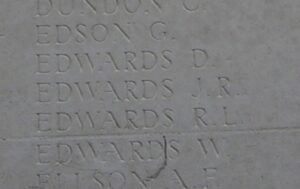
Montague Devonald Edwards, Private, 4522, Hampshire Regiment. Montague was born at Mill Bank, Haverfordwest in 1890, the son of Sergeant Major William Devonald Edwards and Constance Bertha Edwards. His father had served during the Boer War with the Pembroke Imperial Yeomanry, and had served again during the Great War at the Remount Depot at Carmarthen Barracks, where he was responsible for the training of recruits, before serving for two years in France. Montague had left Haverfordwest prior to the war, and resided at Little Biddington, Kent, where he worked for the South Devon Hunt Kennels. Montague enlisted at Exeter into the 13th Battalion, Hampshire Regiment, which was attached to the 8th Reserve Brigade, based in Britain. Montague died of bronchial pneumonia at the Red Cross Hospital at Exmouth on 12 February 1917, aged 27. He is buried at Littleham (SS. Margaret and Andrew) Churchyard, England. Montague is not commemorated on the Withybush Memorial, but at Denbury in Devon.
George Henry Evans, Private, 200281, Welsh Regiment. George was born in London, and resided at Haverfordwest prior to the war. He served with the 1/4th Battalion, Welsh Regiment, which was attached to 159 Brigade, 53rd (Welsh) Division. The 53rd Division moved to the Mediterranean, sailing from Devonport in July 1915 arriving at Mudros by 5 August 1915. From here they moved to Gallipoli, landing on 9 August 1915. Here they immediately faced the chaotic leadership that was to lead to the ultimate failure of the campaign, and spent the next few days in isolated pockets, fighting against a Turkish counter-attack during the Battle of Sari Bair, and then at the Attack on Scimitar Hill. The Division remained here throughout the coming months, and suffered severe losses in manpower strength during the great November 1915 blizzard on Gallipoli, when its total strength was reduced to less than that of a full-strength Brigade. On 11 December 1915 the Division was evacuated to Mudros, and by 23 December 1915 moved to Egypt. They remained on the Suez Canal Defences for the next twelve months, and in early 1917 moved into Palestine, where they remained for the duration of the war, fighting at the Battles of Gaza, and successfully capturing Jerusalem. George must have been taken ill and evacuated to a Hospital at Baghdad for treatment, as he died there on 4 December 1917, and is buried at Baghdad (North Gate) War Cemetery, Iraq. George is not commemorated on the Withybush Memorial.
Robert Ellis Evans, Gunner, 136144, Royal Field Artillery. Robert was the son of David and Ellen Evans of 1, Glyn Terrace, Borth-y-Gest, Portmadoc. He worked for Mr. F. Maddocks, Ironmonger, at Bridge Street, Haverfordwest prior to the war. Robert’s employer had originally appealed against him being called up for service with the army in April 1916, but the appeal was rejected, and after training Robert was posted to France to join the 43rd Battery, 24th Brigade, Royal Field Artillery, which was attached to the 6th Division on the Somme. The following year saw them at Arras, where they fought at the Battle of Hill 70, and then during the Battle of Cambrai later in the year. Robert was killed by the explosion of a German shell, along with two other men, while asleep in his billet near Cambrai on 28 November 1917, aged 20. He is buried at Ribecourt British Cemetery, France. Robert is not commemorated on the Withybush Memorial, but at his native Portmadoc.
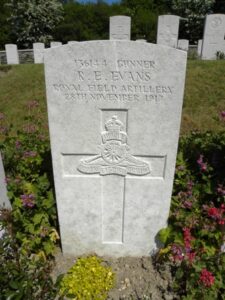
Thomas Evans, Lance Corporal, S/444, Queen’s Royal West Surrey Regiment. Thomas was born at Haverfordwest, the son of Thomas and Martha Evans, later of 66, Howbury Road, Nunhead. London. He enlisted at Camberwell into the 7th Battalion, Queen’s (Royal West Surrey) Regiment, which was attached to 55 Brigade, 18th (Eastern) Division. On 25 May 1915 the Division landed in Boulogne, and didn’t see its first major action until July 1916 when it took part in the Battle of Albert. Thomas was killed less than a week into the Battle, on 13 July 1916. He was 33 years old and has no known grave, and is commemorated on the Thiepval Memorial, France. Thomas is not commemorated on the Withybush Memorial.
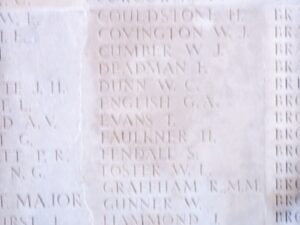
Thomas Hubert Davey Evans, Sergeant, 345003, London Regiment. Thomas was born at Haverfordwest, but resided at Muswell Hill, London prior to the war. He enlisted at Harringay into the 5th Battalion, London Regiment, with the Regimental Number 4942, but later transferred into the 6th Battalion (Rifles), attached to 140 Brigade, 47th (2nd London) Division. The Division moved to France during March 1915, and fought at Aubers, and Festubert during May 1915 and in September fought at the Battle of Loos, and subsequent Action of Hohenzollern Redoubt. They were north of Arras when the Germans attacked Vimy Ridge, and then moved south to the Somme, where they fought at the Battle of Flers-Courcelette, and then at the Battle of Le Transloy, where the Division captured Eaucourt l’Abbe, and took part in Attacks on the Butte de Warlencourt. Early in 1917 the Division moved north to Belgium, and took part in the Battle of Messines, before moving to the Cambrai area. Thomas was killed in action soon after this move south, on 19 July 1917, aged 30. He is buried at Metz-en-Couture Communal Cemetery, British Extension, France. Thomas is not commemorated on the Withybush Memorial.
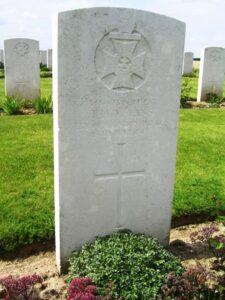
John Lloyd Farrow, Private, 408, Welsh Regiment. John was the son of John and Susannah Agnis Farrow, of 8, Old Bridge, Haverfordwest, and he enlisted there into the 1/4th Battalion, the Welsh Regiment. The Battalion was attached to 159 Brigade, 53rd (Welsh) Division, which moved to the Mediterranean, sailing from Devonport in July 1915 and arriving at Mudros by 5 August 1915. From here they moved to Gallipoli, landing on 8 August 1915. Here they immediately faced the chaotic leadership that was to lead to the ultimate failure of the campaign, and spent the next few days in isolated pockets, fighting against a Turkish counter-attack. The Division remained here throughout the coming months, and suffered severe losses in manpower strength during the great November 1915 blizzard on Gallipoli, when its total strength was reduced to less than that of a full-strength Brigade. John was killed in action during this terrible period, on 26 November 1915. He was 30 years old, and is buried at Lala Baba Cemetery, Gallipoli.
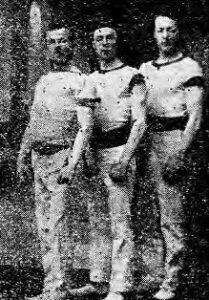
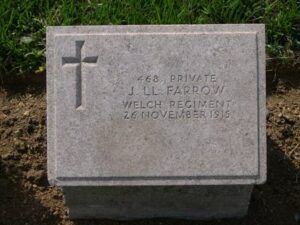
George Fowler, MM, Bombardier, 73984, Royal Field Artillery. George had resided at Tower Hill, New Quay for several years prior to moving to Haverfordwest with his wife Catherine. He enlisted there into the Royal Artillery, and was posted to France on 29 July 1915, attached to D Battery, 235th Brigade, Royal Field Artillery, which was attached to the 47th (2nd London) Division. The Division fought at the Battle of Aubers, and the Battle of Festubert during May 1915 and in September fought at the Battle of Loos. They were north of Arras when the Germans attacked Vimy Ridge, and then moved south, taking part in the Battle of the Somme. Early in 1917 the Division moved north to Belgium, and took part in the Battle of Messines, and then in November 1917 fought at the Battle of Cambrai. In March 1918 the Division were situated near St. Quentin, and faced the German Spring Offensive here on 21 March, fighting at the Battle of St Quentin. George was killed in action during terrible fighting on 27 March 1918, aged 28, and he is commemorated on the Arras Memorial, France. George was awarded the Military Medal during his time at war. George is not commemorated on the Withybush Memorial.
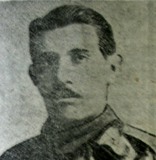
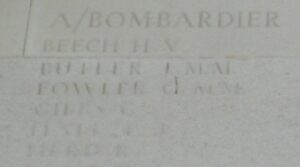
Robert Lewis Francis, Corporal, 2335, Welsh Regiment. Robert was born at Haverfordwest on 20 November 1870, the son of James and Hannah Francis and the family moved to Sketty, Swansea soon afterwards. Robert moved to 43, Kings Road, Canton, Cardiff after marrying Annie Ethel Davies, of Llantwit Major, and worked as a motor tramway conductor. Robert was an army reservist and had served in the South African Campaign. He re-joined the colours at Cardiff at the outbreak of war, and was posted to the 2nd Battalion, Welsh Regiment, which was in France attached to 3 Brigade, 1st Division. Robert served with the 2nd Welsh in France from 29 November 1914, and would have fought at First Ypres upon joining the battalion on the Menin Road. He was probably with the battalion in 1915 during the Second Battle of Ypres, and was wounded and invalided home. Upon recovering he was posted to Kinmel Park with the 3rd Welsh. He was knocked down and killed alongside another recuperating soldier, Private Frank Thomas of Neath, by a motor bus near Kinmel Park on 24 March 1916. The bodies of both men were returned to south Wales. Robert, who was 45 years old, was buried in Cardiff (Cathays) Cemetery, while Frank was buried in Neath. Robert is not commemorated on the Withybush Memorial.
John Henry Gambold, Private, 16586, North Staffordshire Regiment. John was born on 14 November 1894, the son of John and Mary Ann Gambold, of Colby Scott, Prendergast, Haverfordwest. He enlisted there into the Welsh Regiment, with the Regimental Number 11828, but was transferred into the 7th Battalion, North Staffordshire Regiment, which was attached to 39 Brigade, 13th (Western) Division. Towards the end of February the entire Division concentrated at Blackdown in Hampshire. On 7 June 1915, orders were received to prepare to move to the Mediterranean. On 13 June 1915 the Division left port, and moved to Alexandria. By 4 July, all units had moved to Mudros, preparatory for landing on Gallipoli. Between 6 and 16 July, 1915 the Division landed on Cape Helles and relieved the 29th Division. They left and returned to Mudros at the end of the month, and the entire Division landed at ANZAC Cove between 3 and 5 August 1915, taking part in the Battle of Sari Bair, where John was killed in action on 6 August 1915 aged just 21. He has no known grave, and is commemorated on the Helles Memorial, Gallipoli.
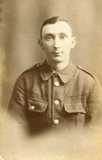
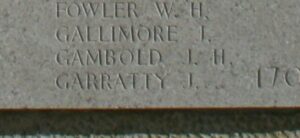
Alban Henry Gaunt, Private, CMT/377, Army Service Corps. Henry was the son of George and Harriet Gaunt, of Burton Joyce, Nottinghamshire. He had resided at Haverfordwest prior to 1907, and married Jessie Evelina John in 1907. The couple then spent periods living at Skewen, Coedfranc and at Swansea and Llanelli prior to the outbreak of war, with Henry working as a Driver for Buckleys Breweries. When war erupted, Henry enlisted at Llanelli as a Driver with the Base M.T. Depot, Army Service Corps. Jessie by now had moved with their children to The Bull Inn, Prendergast, Haverfordwest, to be back with her family. Henry moved to France with the BEF at the outbreak of war, and was wounded by shell fragments at the Battle of Mons. He died of wounds on 24 August 1914, aged 28. Henry has no known grave, and is commemorated on the La Ferte-Sous-Joarre Memorial, France. Henry is not commemorated on the Withybush Memorial. Jessie remarried twice afterwards, and died in Staffordshire in 1953.
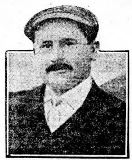
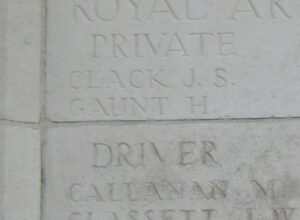
George Frederick Gibbon, Private, G/18198, Queen’s Own Royal West Kent Regiment. George was the son of Willie and Martha Gibbon of 2, Horns Lane Haverfordwest. He had enlisted on 15 November 1915 into the Royal Fusiliers, with the Regimental Number PS/9328, and served in France from 29 August 1916 until being wounded and returning home just over a month later. On 12 September 1917 he returned to France, and was posted to the 7th Battalion, Queens Own Royal West Kent Regiment. The Battalion was attached to 53 Brigade, 18th (Eastern) Division, and had been in France since 25 May 1915. George joined the battalion at Ypres, where they took part in the Battle of Pilckem, taking part in the capture of Westhoek. The division then fought at the Battle of Langemarck, and at the First Battle of Passchendaele, followed by the Second Battle of Passchendaele. In 1918 the Division were stationed south of the Somme, and were one of the Divisions hit there by the German Spring Offensive, which was launched on 21 March 1918. They fought at the Battle of St Quentin, and suffered terrible casualties, and then took part in the Battle of the Avre and the Actions of Villers-Bretonneux. George became ill and died in the field hospital at Cagny on 5 May 1918, aged 23. He is buried at Grand-Seraucourt British Cemetery, France.
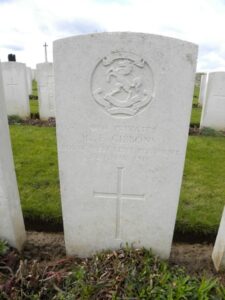
William Greaves, Private, 24378, South Wales Borderers. William was born at Canning Town, London, but worked at Haverfordwest prior to the war. He enlisted there into the Welsh Regiment, but was later posted to the 12th Battalion, South Wales Borderers, which was attached to 119 Brigade, 40th (Bantam) Division. This Division had formed towards the end of 1915, composed of bantam units, and moved to France during the first week of June 1916, taking up positions near Loos. Late in 1916 it moved south to the Somme, and fought at the Battle of the Ancre, and remained in the area over the winter. In March 1917 the Germans withdrew to the Hindenburg Line, and the 40th Division was one of the Divisions that followed the withdrawal. Later in the year it took part in the Battle of Cambrai, playing an important role in the attack on Bourlon Wood. William was killed in action at Cambrai on 25 November 1917. He is buried in Hermies Hill British Cemetery, France. William is not commemorated locally.
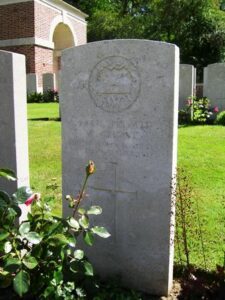
Cyril Norman Green, Driver, 122243, Royal Field Artillery. Cyril was born at Pembroke Dock in 1896, the son of John and Bessie Rundle Green. Cyril had moved around West Wales, living at Tenby, Brecon, and at 7, Bridge Street, Haverfordwest, which is where he enlisted into the Royal Field Artillery, serving with the 55th Division Ammunition Column, attached to the 55th (West Lancashire) Division. The complete Division was reformed in France during January 1916, and relieved the French 88th Division south of Arras, by 16 February. Trench warfare commenced, with many raids and minor operations. Relieved by the 11th (Northern) Division on 25 July, the Division moved south and took up a place in the front line opposite the village of Guillemont. Here they fought at the Battle of Guillemont and the Battle of Ginchy. There was a short period of rest at Ribemont from 12 to 17 September, and then the Division fought at the Battle of Flers-Courcelette and the Battle of Morval. Relieved by 41st Division on 28 September, the Division withdrew to the area of Buire and Ribemont, before relieving the 29th Division in the Ypres salient in October 1916. It was destined to remain in this area for almost a year, stationed near Railway Wood. Cyril was wounded at Railway Wood, and evacuated to the Base Hospital at Boulogne, where he died of wounds on 11 March 1917. He was just 21 years old, and is buried at Boulogne Eastern Cemetery, France.
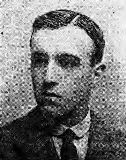
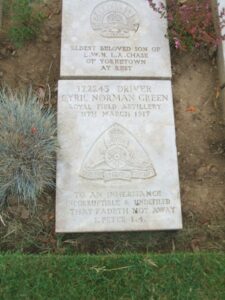
Archie Griffiths, Private, G/5868, Royal Sussex Regiment. Archie was the son of William and Maria Griffiths, of 44, Dew Street, Haverfordwest. He enlisted in September, 1914 into the 2nd Battalion, Royal Sussex Regiment, which was attached to 2 Brigade, 1st Division. The Division had been one of the first to arrive in France, fighting at the Battle of Mons, and taking part in the retreat to the Marne, where the Germans were stopped. They then fought at the Aisne, and at Chivy, before being moved North to Ypres. Here they fought at the First Battle of Ypres, where they again stopped the German Offensive, before wintering in Flanders. The following year saw them in action again at the Battle of Aubers, before moving South to Loos, where they fought during the Battle of Loos, and the action at the Hohenzollern Redoubt. Archie was killed in action whilst the Division was near Arras, on 30 June, 1916, just prior to their move to the Somme. He was just 20 years old, and is commemorated on the Arras Memorial, France. His brother Walter James Griffiths also fell.
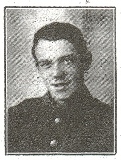
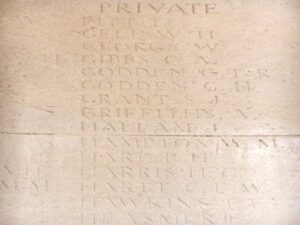
Frederick Griffiths, Private, 111677, Tank Corps. Frederick was born at St. Davids in 1892, the son of Thomas and Elizabeth Griffiths. By 1901 the family was residing at 6, North Gate, Haverfordwest. Frederick and enlisted at Haverfordwest into the Royal Field Artillery, with the Regimental Number 263376. He was transferred into the Tank Corp sometime after 1916, and served with the 11th Battalion, Tank Corps. Frederick was killed in action during the period of the offensive against the mighty Hindenburg Line, on 27 September 1918, aged 26. He is buried at Gouzeaucourt New British Cemetery, France. His brother Ivor also fell.
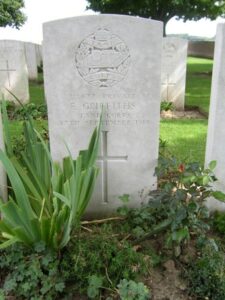
Ivor Griffiths, Private, 445, Welsh Regiment. Ivor was born at St. Davids, the son of Thomas and Elizabeth Griffiths. The family later resided at 6, North Gate, Haverfordwest. Ivor enlisted at Haverfordwest into the 1/4th Battalion, Welsh Regiment. The Battalion was formed at Carmarthen during August 1914 and was attached to 159 Brigade, 53rd (Welsh) Division. The 53rd Division moved to the Mediterranean, sailing from Devonport in July 1915 arriving at Mudros by 5 August 1915. From here they moved to Gallipoli, landing on 8 August. Here they immediately faced the chaotic leadership that was to lead to the ultimate failure of the campaign, and spent the next few days in isolated pockets, and fought at the Battle of Sari Bair, where Ivor was wounded. He was evacuated from Gallipoli, and brought to Gibraltar for treatment, but sadly died at sea of his wounds on 4 September 1915, aged 19. Ivor was buried ashore, at Gibraltar (North Front) Cemetery. His brother Frederick also fell.
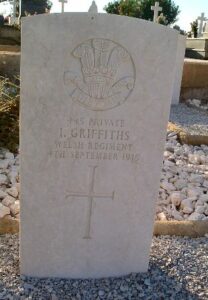
Philip Griffiths, Private, 200115, Welsh Regiment. Philip was born at Haverfordwest and enlisted there the 1/4th Battalion, Welsh Regiment, which was the local Territorial Battalion, attached to 159 Brigade, 53rd (Welsh) Division. The Division landed at Cape Helles, Gallipoli, on 9 August 1915, and was immediately thrown into action, spending the next few days in isolated pockets, fighting against a Turkish counter-attack during the Battle of Sari Bair, and then at the Attack on Scimitar Hill. The Division remained here throughout the coming months, and suffered severe losses in manpower strength during the great November 1915 blizzard on Gallipoli, when its total strength was reduced to less than that of a full-strength Brigade. On 11 December 1915 the Division was evacuated to Mudros, and by 23 December 1915 were moved to Egypt. They remained on the Suez Canal Defences for the next twelve months, where it took part in operations against the Sultan of Darfur, and in March 1917 took part in the advance into Palestine, fighting at the Battles of Gaza, and successfully capturing Jerusalem. Philip was killed during the First Battle of Gaza, on 26 March 1917. He has no known grave and is commemorated on the Jerusalem Memorial, Israel.
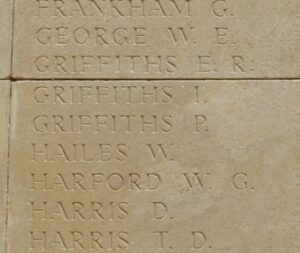
Walter James Griffiths, Lance Corporal, 302, Welsh Regiment. Walter was the son of William and Maria Griffiths, of 44, Dew Street, Haverfordwest. He enlisted at Bridgend into the 1/4th Battalion, Welsh Regiment, which was formed at Carmarthen during August 1914 and was attached to 159 Brigade, 53rd (Welsh) Division. The 53rd Division moved to the Mediterranean, sailing from Devonport in July 1915 arriving at Mudros by 5 August 1915. From here they moved to Gallipoli, landing on 8 August. Here they immediately faced the chaotic leadership that was to lead to the ultimate failure of the campaign, and spent the next few days in isolated pockets, and fought at the Battle of Sari Bair, where Walter was one of many men of the Battalion killed on 10 August 1915. He was just 21 years old, and is commemorated on the Helles Memorial, Gallipoli. His brother Archie also fell.
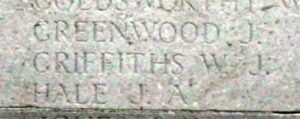
William Henry Guarneri, Private, 200064, Welsh Regiment. William was born at Haverfordwest in 1896, the son of John and Elizabeth Guarneri. The family later resided at Picton Ferry, St. Clears. He enlisted at Haverfordwest into the 1/4th Battalion, the Welsh Regiment, which formed part of 159 Brigade, 53rd (Welsh) Division. On 9 August 1915 the Division landed at Gallipoli at Suvla Bay, and they fought there until mid December, when they were evacuated to Egypt. They fought in the Palestinian Campaign, where William was wounded during the First Battle of Gaza. William Died of Wounds on 29 March 1917, aged only 20, and is buried at Deir El Belah War Cemetery, Egypt. William is not commemorated on the Withybush Memorial.
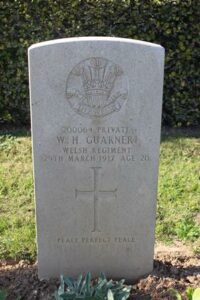
Frederick Hardaker, Private, 57424, Suffolk Regiment. Frederick was the son of Frederick and Frances Hardaker, of 135, Prendergast, Haverfordwest. He had enlisted at Haverfordwest into the Lancashire Fusiliers, with the Regimental Number 50879, but had been transferred into the 12th Battalion, Suffolk Regiment, which was attached to 43 Brigade, 14th (Light) Division. The Division had been in France since early in 1915, and had fought there throughout the war, seeing terrible fighting on the Somme in 1916, at Passchendaele and Cambrai in 1917, and throughout 1918. It’s final actions were during the advance to victory in Flanders during the end of the year. Frederick died of sickness (probably influenza) at home on 3 May 1919. He was just 19 years old, and is buried at Prendergast Cemetery, Haverfordwest.
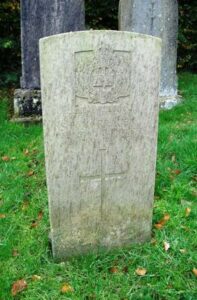
James George Harding, Guardsman, 17010, Grenadier Guards. James was born at Prendergast in 1893, the son of Alice Harding. His mother had remarried by 1901, and James was brought up with his brothers and sisters at their stepfather, John Beet’s home at Merlins Hill. James was a pre-war regular, having enlisted prior to 1911 into the South Wales Borderers. During the Great War James served with the 4th Battalion, Grenadier Guards. The battalion was attached to the 3rd Guards Brigade, Guards Division, which had been formed in France in August 1915, by various Guards units that had been with other Divisions. It remained on the Western Front throughout the war and saw its first major action during the Battle of Loos on 25 September 1915, remaining in the area during the coming months, where they also fought in the subsequent Action of Hohenzollern Redoubt. In July 1916 the Division moved to the Somme, where they fought at the Battle of Flers-Courcelette, and then at the Battle of Morval, capturing Lesboeufs Village. They remained here for the winter, and in March 1917 took part in the advance caused by the German Retreat to the Hindenburg Line. Later that year they moved north to Ypres, where they trained and made ready for their part in the Battle of Third Ypres. James was killed here on 8 July 1917, aged 23. He is buried at Canada Farm Cemetery, Belgium. James is not commemorated locally.
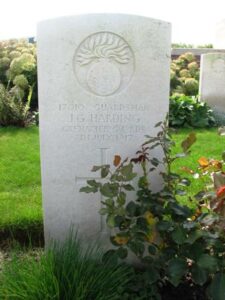
Francis Alexander Blair Harper, Deck Hand, 3925DA, Royal Naval Reserve. Francis was born in Aberdeen on 16 August 1884 and was a fisherman. After the outbreak of war he served with the Royal Naval Reserve, aboard HM Trawler, Ocean Angler. Francis’ wife Isabella died on 18 January 1917 leaving him with three daughters to look after, so Francis moved his three daughters, Mary, Frances and Mabel, to Haverfordwest, close to his base at Milford Haven. Soon after this he married Alice Warlow in Haverfordwest, and the couple had a son, Frank Harper. Sadly not long afterwards, Francis died in hospital in Ireland, on 8 February 1919, aged 34. He was brought home for burial at St. Martin’s Cemetery, Haverfordwest. Many thanks to Mr. Alex Buchan for sending in additional information about Francis.
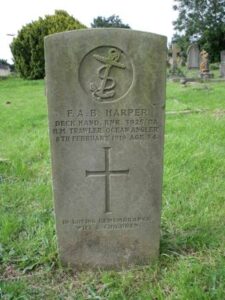
J. Harries, Private, North Staffordshire Regiment. Cannot positively be identified, but is one of these two men below, as no men named Harries served with the North Staffs.
John Harries, Private, 203540, Welsh Regiment. John was born in Haverfordwest in 1887, and resided at 5, Lower March, Haverfordwest. He enlisted there into the 4th Battalion, Welsh Regiment, and was posted to France, joining the 9th Battalion, which was attached to 58 Brigade, 19th (Western) Division. The Division assembled around Bulford during September 1914. Divisional training was completed near Tidworth, from March 1915, and the Division crossed to France during July 1915, moving to positions near Loos. The Division fought during the opening attack of the Battle of Loos, and then moved to the Somme, where they took part in the second wave of the attack on Ovillers-La Boiselle on 1 July 1916, capturing the village at heavy cost, and fought through the Somme Battles of Pozieres and the Ancre in 1916. They then moved North to Ypres, taking part in the Battle of Messines, then fought during the Third Battle of Ypres. In 1918 they were caught up in the German Spring Offensive near St. Quentin, where they suffered terrible casualties, and fought at the Battle of Bapaume. They moved to Ypres, but were caught up in the German attack at Messines. After suffering terribly again, they moved South to the quieter French sector to rebuild, but were caught up in the German offensive on the Aisne, and saw heavy fighting yet again. John must have been wounded during the early part of the year, during the German Offensive. He was evacuated home for treatment, but sadly died of wounds at the Queens Hospital Chislehurst, Kent on 6 August 1918, aged 31. He is buried at St. Thomas A Becket Churchyard, Haverfordwest.
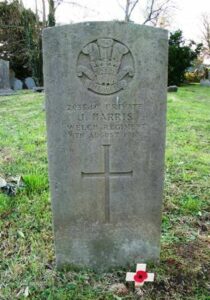
John Henry Harries, Private, 1444, Welsh Regiment. John was born on 28 May 1896, the son of James Henry Harries and Elizabeth Harries, of 14, Prospect Place, Haverfordwest. He served with the 1st Battalion, Welsh Regiment, which was attached to 84 Brigade, 28th Division. The Division formed in England between December 1914 and January 1915 from regular units returning from India, Singapore and Egypt. During January 1915 it moved to France, landing at Le Havre and moved to the Western Front, where it saw its first major action during the Second Battle of Ypres. on 25 September 1915 the Division took part in the Battle of Loos. John was killed in action at Loos, on 2 October 1915, aged 19. John has no known grave, and is commemorated on the Loos Memorial, France.
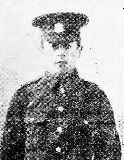
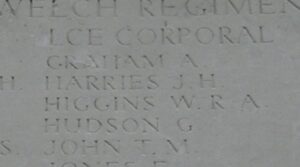
Seth John Harries, Private, 320015, Welsh Regiment. Seth was born at Haverfordwest in 1889, the son of John and Phoebe Harries. He enlisted there into the Pembroke Yeomanry, with the Regimental Number 251. The Pembroke Yeomanry was attached to the South Wales Mounted Brigade, and moved to Egypt in 1916 where it was dismounted, and used for duties on the Suez Canal defences. In early 1917 the Battalion was merged with the Glamorgan Yeomanry to form the 24th (Pembroke & Glamorgan Yeomanry) Battalion, Welsh Regiment, attached to 231 Brigade, 74th (Yeomanry) Division. The Division had formed in Egypt in January, 1917 and had fought through the Palestinian Campaign, at the Battles of Gaza and the Battle and capture of Jerusalem. Seth was killed during the Third Battle of Gaza, on 6 November 1917, aged 29. He is buried at Beersheba War Cemetery, Israel.
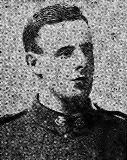
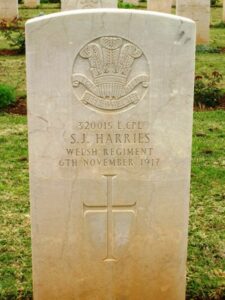
William Venning Harris, Private, 705, Welsh Regiment. William was the son of Thomas and Margaret Harris, of 22, Hilltop Road, Kilburn, London. He lived at Haverfordwest prior to the war, and served with the 1/4th Battalion, Welsh Regiment, which was the local Territorial Battalion, attached to 159 Brigade, 53rd (Welsh) Division. The Division landed at Cape Helles, Gallipoli, on 9 August 1915, and was immediately thrown into action, spending the next few days in isolated pockets, fighting against a Turkish counter-attack during the Battle of Sari Bair, and then at the Attack on Scimitar Hill. William was killed on 10 August 1915, aged 24. He has no known grave and is commemorated on the Helles Memorial, Gallipoli. William is not commemorated on the Withybush Memorial.
Robert Stanley Higgs, Private, 30805, Welsh Regiment. Stanley was the son of William and Maud Higgs, of Milford Haven (CWGC records state the son of Robert Stanley Higgs, but census records do not concur). In 1909 he married Christina Thomson, of High Road, Whetstone, London, and fathered two children with her. Stanley enlisted at Haverfordwest into the 1st Battalion, Welsh Regiment on 20 February 1900. The battalion was in India at the outbreak of war, and was recalled to Britain, where it joined 84 Brigade, 28th Division. The Division formed in England between December 1914 and January 1915 from regular units returning from India, Singapore and Egypt. During January 1915 it moved to France, landing at Le Havre and moved to the Western Front, where it saw its first major action during the Second Battle of Ypres. Stanley was wounded at Ypres, and died of wounds on 21 April 1915. He was 38 years old, and is buried at Bedford House Cemetery, Belgium.
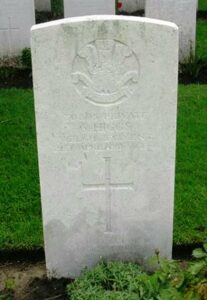
William Hooper, Private, 29137, Welsh Regiment. William was the son of George and Martha Hooper, of 20, Albert Street, Haverfordwest, and the husband of Mary Jane Hooper, of 60, Tirdu Road, Morriston, Swansea. He enlisted at Swansea into the 14th (Swansea Pals) Battalion, the Welsh Regiment, which was attached to 114 Brigade, 38th (Welsh) Division. The Division had landed in France during December 1915 and had spent their first winter in the trenches near Armentieres. In June they marched south to the Somme, where they were tasked with the capture of Mametz Wood. The attack on the wood began on 7 July 1916, but met with fierce resistance, and it wasn’t until 10 July that a fresh assault was launched, with the Swansea Pals in the heart of the fighting. William was killed in action at Mametz Wood on 12 July, 1916, aged 34. He has no known grave, and is commemorated on the Thiepval Memorial, France.
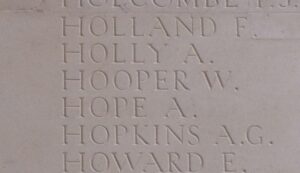
Alfred Heywood Howard, Captain, Welsh Regiment. Alfred was born at Heaton, Lancashire in 1869, the son of Joseph and Fanny Howard. He was a Bank Manager prior to the war, and resided at Bank House, Haverfordwest with his wife Elizabeth and their daughter Vera. Alfred was commissioned into the Welsh Regiment, and was attached to the 4th Battalion at the outbreak of war. The Battalion was the Carmarthenshire Territorial Battalion, and was formed at Carmarthen on 4 August 1914, attached to South Wales Brigade, Army Troops. In November 1914 the Brigade moved to Tunbridge Wells, and then in February 1915 to Scotland on Forth and Tay Defences. On 17 April 1915 the Battalion was posted to 159 Brigade, 53rd Division at Bedford, and on 19 July 1915 sailed from Devonport for Mudros, arriving on 5 August. From here the Division moved to Gallipoli, and on 8 August 1915 landed at Suvla Bay. Here they immediately faced the chaotic leadership that was to lead to the ultimate failure of the campaign, and spent the next few days in isolated pockets, fighting against a Turkish counter-attack during the Battle of Sari Bair, which is where Alfred was killed on 10 August 1915, aged 45. Alfred has no known grave, and is commemorated on the Helles Memorial, Gallipoli.
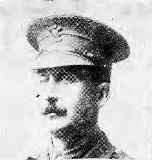
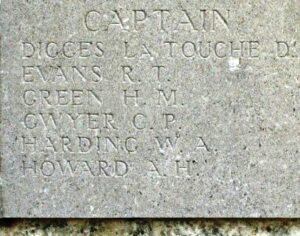
David Alfred Hughes, Private, 44743, Royal Welsh Fusiliers. David was the youngest son James and Ann Hughes, of 75, Dew Street, Haverfordwest. He enlisted at Haverfordwest on 1 March 1916 into the Welsh Regiment, and was posted to Kinmel Park, Rhyl, for training. Here David joined the 18th Battalion, Royal Welsh Fusiliers on 18 April, which was a Reserve Battalion. David’s service was not to last long however. He became ill weeks after arriving at Rhyl, and was hospitalised there, dying of cardiac asthma and cirrhosis of the liver on 7 May 1916. He was 29 years old, and was brought home to be buried at St. Mary Church Cemetery, Haverfordwest.
Frederick William Treweek Hughes, Gunner, 172330, Royal Garrison Artillery. Frederick was born at Haverfordwest in 1879, the son of John Richard Hughes and Margaret Ellen Hughes. His father was a Bank Manager, and the family moved around the country at regular intervals. Frederick married Mabel Bancroft Walker at Acton on 23 August 1904, and the couple resided at Ealing prior to the war. Frederick enlisted at St. Swithin’s Lane into the Royal Garrison Artillery. Very little else is known of Frederick, but he had served overseas, and died of wounds at Richmond, Surrey on 25 September 1918, aged 39. Frederick is buried at South Ealing Cemetery, Middlesex. He is not commemorated on the Withybush Memorial.
James Henry Hurlow, Private, 54160, Welsh Regiment. James was born at Prendergast in 1897, the son of Elizabeth Hurlow, of Stephens Yard Hill, Haverfordwest. He enlisted at Swansea into the 13th Battalion, Welsh Regiment. The battalion had been raised at Cardiff on 23 October 1914, and moved to Rhyl as part of 129 Brigade, 43rd Division. On 29 April 1915 the formation became 114 Brigade, 38th Division, and in August 1915 moved to Winchester. During December 1915 the Division landed at Havre, and spent their first winter in the trenches near Armentieres. In June they marched south to the Somme, where they famously captured Mametz Wood. The Division suffered terrible casualties at Mametz, and were taken out of the line, and moved to Ypres to rebuild. Here they fought at the Battle of Pilckem Ridge, which is where James was killed in action on 31 July 1917, aged 20. He is buried at No Man’s Cot Cemetery, Belgium.
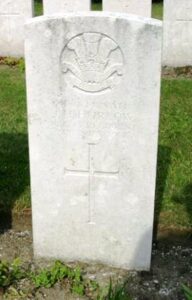
Charles Henry James, Private, 201562, Welsh Regiment. Charles was the son of Henry and Julia James, of 30, Prendergast Hill, Haverfordwest. He had served with the 1/4th Battalion, Welsh Regiment, which was the local Territorial Battalion, attached to 159 Brigade, 53rd (Welsh) Division. The Division had fought at Gallipoli in 1915, and on 11 December 1915 the Division was evacuated to Mudros, and by 23 December 1915 were moved to Egypt. They remained on the Suez Canal Defences for the next twelve months, where it took part in operations against the Sultan of Darfur, and in March 1917 took part in the advance into Palestine, where they remained for the duration of the war, fighting at the Battles of Gaza, and successfully capturing Jerusalem. Charles died at home as a result of his wartime service on 10 January 1919. He was 21 years old and is buried at Haverfordwest (Prendergast) Cemetery. Charles is not commemorated on the Withybush Memorial.
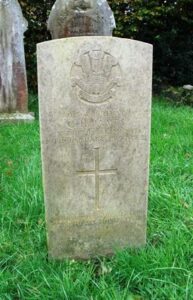
Edwin James, Private, 241468, Welsh Regiment. Edwin was the son of James Watkin James and Florence James, of 98, Prendergast, Haverfordwest. He enlisted at Mountain Ash into the 1/5th Battalion, Welsh Regiment. The Battalion formed on 4 August 1914 at Pontypridd, as part of South Wales Brigade, Army Troops. In November 1914 the Brigade moved to Tunbridge Wells, and in February 1915 to Scotland on Forth and Tay Defences. They joined 159 Brigade, 53rd Division at Bedford, and then on 19 July 1915 sailed from Devonport for Mudros, arriving on 5 August. From here the Division moved to Gallipoli, and on 8 August 1915 landed at Suvla Bay. Here they immediately faced the chaotic leadership that was to lead to the ultimate failure of the campaign, and spent the next few days in isolated pockets, fighting against a Turkish counter-attack during the Battle of Sari Bair, and then at the Attack on Scimitar Hill. The Division remained here throughout the coming months, and suffered severe losses in manpower strength during the great November 1915 blizzard on Gallipoli, when its total strength was reduced to less than that of a full-strength Brigade. On 11 December 1915 the Division was evacuated to Mudros, and by 23 December 1915 was moved to Egypt. They remained on the Suez Canal Defences for the next twelve months, and in early 1917 moved into Palestine, and saw their first action here at the Battle of Gaza. Edwin was killed in action here on 26 March 1917, aged just 21. He has no known grave, and so is commemorated on the Jerusalem Memorial, Israel.

George James, Private, 2722, Welsh Guards. George was born in 1895, the son of George and Ellen James, of 13, Prospect Place, Haverfordwest, and enlisted there into the 1st Battalion, Welsh Guards. The Battalion was attached to the 3rd Guards Brigade, Guards Division. This Division has the distinction of being formed in France in August 1915, of the various Guards units that had been with other Divisions. It remained on the Western Front throughout the war and saw its first major action during the Battle of Loos on 25 September 1915, remaining in the area during the coming months, where they also fought in the subsequent Action of Hohenzollern Redoubt. In July 1916 the Division moved to the Somme, where they fought at the Battle of Flers-Courcelette, and then at the Battle of Morval, capturing Lesboeufs Village. They remained here for the winter, and it was here that George was killed in action on 7 March 1917, aged 22. He is buried at Sailly-Saillisel British Cemetery, France.

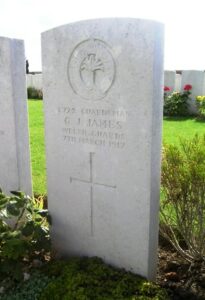
Gilbert George James, Private, 42577, Lincolnshire Regiment. Gilbert was born at Uzmaston in 1898, the son of Matthew and Martha James. He enlisted at Haverfordwest into the Liverpool Regiment, with the Regimental Number 64124. He later transferred into the 10th Battalion, Lincolnshire Regiment, which was attached to 197 Brigade, 66th (2nd East Lancs) Division. The Division concentrated on the Western Front by 16 March 1917 and moved to the Flanders Coast. At the end of September 1917 they moved to Ypres, and took part in the Battle of Poelcapelle. They then moved south to the Somme, and on 21 March 1918 were hit by the German Spring Offensive at the Battle of St Quentin, and moving back west fought at the Actions at the Somme Crossings, and the Battle of Rosieres. Gilbert was taken Prisoner by the Germans on 22 March 1918 during the ensuing mayhem, and he died of captivity on 29 August 1918, aged 19. For some reason Gilbert is commemorated on ‘Special P.O.W. Memorials’ at two cemeteries, at Valenciennes (St. Roch) Communal Cemetery, and at Le Quesnoy Communal Cemetery Extension, France.
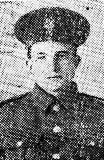
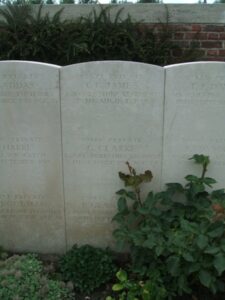
James George James, Lance Corporal, 1847, Welsh Guards. James was the son of Mary Ann James, of 37, Shilo Road, Cartlett, Haverfordwest. He enlisted at Haverfordwest into the 1st Battalion, Welsh Guards. They were attached to the 3rd Guards Brigade, Guards Division. The Battalion saw its first major action during the Battle of Loos on 25 September 1915, remaining in the area during the coming months. In July 1916 the Division moved to the Somme, where they fought at Flers-Courcelette, and at Morval, capturing Lesboeufs Village. They remained here for the winter, and in March 1917 took part in the advance caused by the German Retreat to the Hindenburg Line. Later that year they moved north to Ypres, where they fought at Pilkem Ridge, the Menin Road, Poelcapelle and Passchendaele. November saw them move south again, where they took part in the Battle of Cambrai. They remained in the area over the final winter of the war, and were stationed near Gouzeaucourt when the German Spring Offensive hit the area on 21 March 1918, and fought a bloody rearguard action over the coming days. After this, the German Offensive petered out on the Somme, and on 8 August 1918 a Battle around Villers Brettoneux dealt the Germans a deadly blow. On 21 August the British launched an attack on the Somme, and the Guards Division took part in the great offensive, pushing towards the Hindenburg Line. Once the Hindenburg Line had been broken, the Allies swept eastwards over territory that had been occupied by the Germans for four long years. The Guards fought at Cambrai, the Selle, and the Sambre towards the end of the war. James survived the war but sadly became one of the many casualties of the influenza epidemic that swept Europe at the end of the war. He died at Hospital on 13 December 1918, aged 26, and is buried at Ste. Marie Cemetery, Le Havre, France. James is not commemorated on the Withybush Memorial.
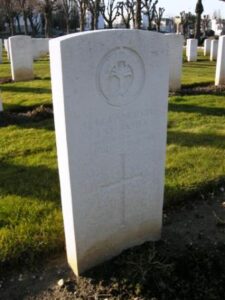
John Elliott James, Private, 31589, South Wales Borderers. John was born in 1899, the son of Thomas and Emily James, of Merlins Hill, Haverfordwest. He enlisted there into the 6th Battalion, South Wales Borderers, which was attached to the 25th Division as Pioneers. The Division landed in France on 26 September 1915, and was posted to the Vimy area, where they defended Vimy Ridge against a German attack in May 1916. They then moved to the Warloy area and attacked on the 3rd July near Thiepval. They fought throughout the Battle of the Somme, and then moved to Ploegsteert, where they held the line for the months leading up the Battle of Messines in June 1917. After fighting at Messines, the Division moved north, and fought at Pilckem, before moving south again, where they took up positions around Bullecourt in reserve. Here the Division was used to reinforce the badly depleted British units that were hit in the area by the German Spring Offensive. John was wounded here, and died of wounds on 28 March 1918, aged 19. He is buried at St. Hilaire Cemetery, Frevent, France.
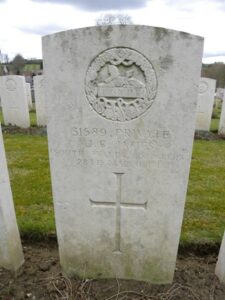
Sidney James, Private, 76210DA, Royal Welsh Fusiliers. Sidney was the son of James and Elizabeth James, of 46, City Road, Haverfordwest. Sidney served with the 4th Reserve Battalion, Royal Welsh Fusiliers, on home service. He died of pneumonia at Herne Bay Military Hospital, Kent on 18 December 1918, aged just 19. He is buried at St. Martin Cemetery, Haverfordwest.
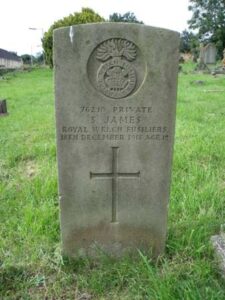
Thomas George James, Private, 200212, Welsh Regiment. Thomas was the son of William and Emily Ann James, of 65, Prendergast, Haverfordwest. It is thought that he lived in Clynderwen prior to the War, and enlisted back at Haverfordwest into the 1/4th Battalion, Welsh Regiment. They formed part of 159 Brigade, 53rd (Welsh) Division, and during July 1915 they sailed from Devonport for Egypt. They were then sent to Gallipoli, landing on 9 August 1915, and stayed on the Peninsula until the withdrawal in December that year, suffering heavy casualties. The Division were back in Egypt by 23 December 1915 and fought in the Palestinian Campaign against the Turkish Empire. It was during the First Battle of Gaza that Thomas was killed in action on 27 March 1917, aged 23. He is buried at Deir El Belah War Cemetery, Israel.
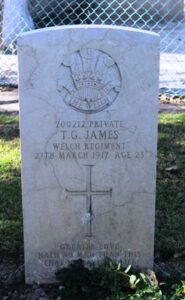
Thomas John James, Private, 1776, Welsh Regiment. Thomas was born in 1892, the son of John James, and the Brother of Richard Bonar James of Haverfordwest. He enlisted at Aberdare into the 1/5th Battalion, Welsh Regiment, which was attached to 159 Brigade, 53rd (Welsh) Division. The Division moved to the Mediterranean, sailing from Devonport in July, 1915 arriving at Mudros by 5 August 1915. From here they moved to Gallipoli, landing on 8 August 1915. Here they immediately faced the chaotic leadership that was to lead to the ultimate failure of the campaign, and spent the next few days in isolated pockets. Thomas was killed in action on 17 August 1915, aged 23. He has no known grave, and is commemorated on the Helles Memorial, Gallipoli.
William Hubert James, Private, 36053, Royal Warwickshire Regiment. William was the son of Richard and Mary James, of Barnsley, Redhill, Haverfordwest. He enlisted there into the Cheshire Regiment with the Regimental Number 4/9038, and later transferred into the 16th Battalion, Royal Warwickshire Regiment, which was attached to the 5th Division. The Division had been on the Western Front since the early days of the war, and had fought throughout most of the major Battles. On 14 August 1918, the Division was withdrawn for rest and placed in GHQ Reserve, after months of heavy fighting. Two weeks later it entered into what became a series of complex, endless, overlapping Allied attacks that forced the German Army into retreat. Fighting through Albert (back on the old and devastated Somme ground of 1916), the Division was in more or less continuous action until late October 1918, fighting at the Battle of Albert, the Battle of Bapaume, the Battle of Épehy, and the Battle of the Canal du Nord. William was killed in action during the Battle of the Selle, on 21 October 1918, aged 19. He has no known grave, and so is commemorated on the Vis-En-Artois Memorial, France.
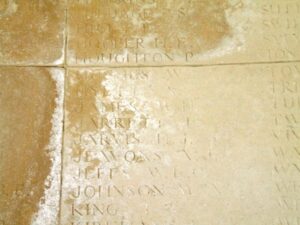
Albert Howell Jenkins, Private, 2012, Australian Imperial Force. Albert was the son of Thomas F. and Sarah Jenkins, of Uzmaston Farm, Haverfordwest. He had had served for five years with the 1st Welsh, before emigrating to Australia prior to the war, where he worked as a Draper. He enlisted at Townsville, Queensland on 21 December 1914, and embarked at Brisbane on 16 April 1915 aboard HMAT Kyarra with the 5th Reinforcements to the 15th Battalion, AIF. The ship took the men to Egypt, where the men joined their compatriots at Mena Camp, near Cairo. The main ANZAC force landed at Gallipoli on 25 April 1915, and managed to grab a foothold on the hostile shores. Albert joined his battalion on 6 June 1915 at Gallipoli, where it was attached to the 4th Brigade, 1st ANZAC Division. The battalion was stationed around Quinn’s Post, and it was here that Albert was taken prisoner by the Turks, during the Battle of Lone Pine, on 8 August 1915. He was one of several 15th Battalion men captured, and sent to Constantinople, where he died of pleurisy on 16 January 1916. Albert was 28 years old, and is buried at Haidar Pasha Cemetery, Gallipoli. Death notice Albert is not commemorated on the Withybush Memorial.
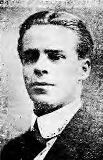
Charles Jenkins, Second Lieutenant, Royal Flying Corps. Charles was born on 2 January 1897, the second son of John Lewis and Bessie Jenkins, of Cleddau Lodge, Haverfordwest. Educated at Haverfordwest Grammar School, Charles then attended the London Wireless College, and from there he enlisted into the Signal Section of the Royal Engineers on 11 November 1914. Charles served on the Western Front from January, 1916 and returned to England in July 1917 to train at Winchester and Oxford. In November 1917 Charles was gazetted 2nd Lieutenant in the Royal Flying Corps, and gained his Wings in January 1918. Charles was sadly killed whilst flying at Upavon, Wiltshire on 21 March 1918. He was buried days later at St. Mary’s Church Cemetery, Haverfordwest. His Commanding Officer wrote in a letter to John and Bessie; ‘Your son was a fine and fearless Pilot, very popular, and we feel his loss keenly’.
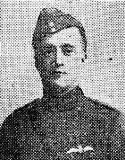
George Edward Jenkins, Private, 56521, Welsh Regiment. George was born in 1895, the son of William and Mary Ann Jenkins, of 20 Prospect Place, Haverfordwest. He enlisted at Haverfordwest on 23 February 1916 into the Welsh Regiment, and was initially posted to the 7th (Cyclist) Battalion, Welsh Regiment. On 26 July 1916 George landed in France, and was posted to the 16th (Cardiff) Battalion, Welsh Regiment, which was attached to 115 Brigade, 38th (Welsh) Division. The Division had just moved from the Somme, where it had taken a mauling during its famous capture of Mametz Wood. Within weeks the division moved to positions at Ypres, alongside the Yser Canal at Boesinghe. It remained here for over twelve months, and on 3 July 1917 fought at the Battle of Pilckem Ridge, and ensuing Battle of Langemarck. George was killed in action at Langemarck when the 16th Welsh were annihilated by an artillery bombardment on 27 August 1917. He was 23 years old, and is commemorated on the Tyne Cot Memorial, Belgium.
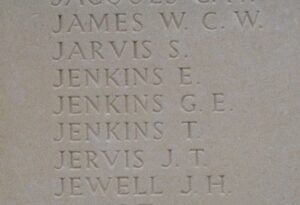
John Jenkins, Stoker, 341736, Royal Navy. John was born at Haverfordwest on 27 March 1877, the son of David and Sarah Jenkins. He had worked as a boilerman at Pontardulais prior to the war, and lived with his wife, Mary Jenkins, at Glanyrafon Road, Pontardulais. John served with the Royal Navy aboard H.M.S. Ariadne. HMS Ariadne was a ship of the Diadem-class of protected cruiser in the Royal Navy. She had been built by J&G Thompson of Clydebank and launched on 22 April 1898. In March 1913 she was converted to a stokers’ training ship and in 1917 was converted to a minelayer and assigned to the Nore Command. She was torpedoed and sunk off Beachy Head by UC-65 on 26 July 1917. John was one of the men killed when the Ariadne went down. He was 39 years old. His body was washed ashore, and so John was brought home to be buried at Rhydgoch Cemetery, Pembrokeshire.
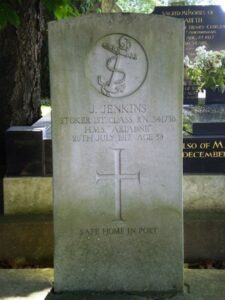
James Henry John, Rifleman, S/1027, Rifle Brigade. James was the son of James and Mary Ann John, of 1, Prospect Place, Haverfordwest. He enlisted at Barry on 4 September 1914 into the Rifle Brigade, and after raining at Winchester was posted to the 11th Battalion, Rifle Brigade, which was attached to 59 Brigade, 20th (Light) Division. On 26 July 1915 the Division completed concentration in the Saint-Omer area, all units having crossed to France during the preceding few days. Early trench familiarisation and training took place in the Fleurbaix area. When the Battle of Loos was launched on 25 September 1915 the Division fought a diversionary attack towards Fromelles. Later that year they moved north, and fought at the Battle of Mount Sorrel alongside the Canadian Corps. Over the winter of 1915/16, the Division remained in positions south of Ypres, and fought at the Battle of Mount Sorrel in June, alongside the Canadian Corps. They then fought through the Somme Offensive, at the Battles of Delville Wood, and Guillemont. John was killed during this period, on 27 August 1916. He was 25 years old, and is buried at Péronne Road Cemetery, Maricourt, France. Many thanks to Philip Slade for the photo of Jim.
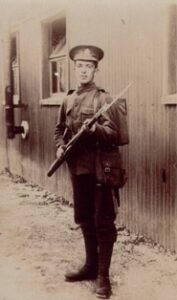
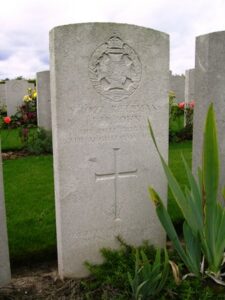
William Thomas John, Private, 54265, Welsh Regiment. William was the son of Thomas and Hester John, of 56, Portfield, Haverfordwest. He enlisted at Haverfordwest into the army, and was posted to the 9th Battalion, Welsh Regiment, which was attached to 58 Brigade, 19th (Western) Division. The Division assembled around Bulford during September 1914. Divisional training was completed near Tidworth, from March 1915, and the Division crossed to France during July 1915, and moved to positions near Loos. The Division fought during the opening attack of the Battle of Loos, and then moved to the Somme, where they took part in the second wave of the attack on Ovillers-La Boiselle on the 1st July, capturing the village at heavy cost, and fought through the Somme Battles of Pozieres and the Ancre in 1916. They then moved North to Ypres, taking part in the Battle of Messines, and then moved north to Ypres itself, where it fought on the Menin Road. William was killed in action here on 20 September 1917, aged only 19. He has no known grave, and so is commemorated on the Tyne Cot Memorial, Belgium.
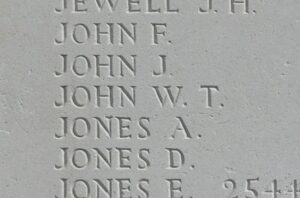
Arthur Hugh Johns, Lieutenant, Royal Sussex Regiment. Arthur was born at Haverfordwest in 1893, the son of the Rev. Roger Owen Johns and Jessie Marianne Johns. By the outbreak of war the family was residing at The Vicarage, Billingshurst, Sussex. Arthur had been commissioned into the Royal Sussex Regiment on 7 December 1914, and was posted to the 12th Battalion, which was attached to 116 Brigade, 39th Division. The Division moved to France at the end of February and early March 1916, and on 30 June 1916 it took part in an attack near Richebourg l’Avoue. The Sussex Battalions in particular suffered very heavy casualties. The Division moved to the Somme in August 1916, where it fought at the Battle of the Ancre Heights, where they captured the Schwaben Redoubt, and helped capture Regina Trench. They then fought at the Battle of the Ancre. Arthur was killed in action on 1 September 1916. He was 23 years old and is buried at Mailly-Maillet Communal Cemetery Extension, France. Arthur is not commemorated on the Withybush Memorial.
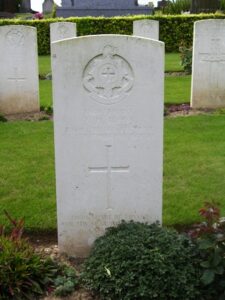
John William Haydn Johnson, Lance Corporal, 28974, Loyal North Lancashire Regiment. John was the son of John W Johnson and Lizzie Johnson, of 48, Tudor Road, Cardiff. He worked at Haverfordwest prior to the war and enlisted there into the Army Service Corps. He was later posted to the 2/4th Battalion, Loyal North Lancashire Regiment, which was attached to 170 Brigade, 57th (2nd West Lancs) Division. John was killed in action on 29 August 1917, aged 30. His battalion was at Ypres by then, so it is a mystery why John is commemorated on the Vis-En-Artois Memorial, which is a lot further south in France. John is not commemorated locally.
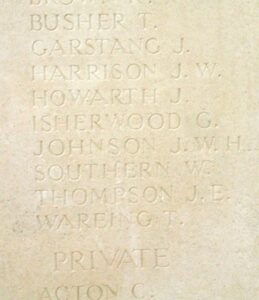
Clement Daniel Jones, Private, G/29321, Middlesex Regiment. Clement was born at Haverfordwest in 1887, the son of George and Mary Jones. He worked as a Draper prior to the war, for Messrs J. Barnes Co. Ltd, 191 and 217 Finchley Rd, Hampstead, and enlisted there into the 21st Battalion, Middlesex Regiment. The Battalion was raised in Islington by the Mayor and Borough on 18 May 1915, and in July 1915 joined 118 Brigade, 39th Division. Taken over by the War Office in August, they moved in October 1915 to Aldershot, then in February 1916 to Witley, where the Battalion moved to 121 Brigade, 40th (Bantam) Division. During June 1916 the Division landed in France, and moved to the front near Loos. Late in 1916 they moved south to the Somme, and fought at the Battle of the Ancre, and remained in the area over the winter. In March 1917 the Germans withdrew to their shortened line, called the Hindenburg Line, and the 40th Division was one of the Divisions that followed the withdrawal. Later in the year they took part in the Battle of Cambrai, playing an important role in the attack on Bourlon Wood. Clement was wounded at Cambrai, and died of wounds on 24 November 1917. He was buried on the battlefield, but his grave must have been lost over the coming few months of fighting in the area, as he is commemorated on the Cambrai Memorial, Louverval, France. His brothers, Peter McKenzie Jones and John Daniel Jones, also fell.
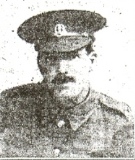
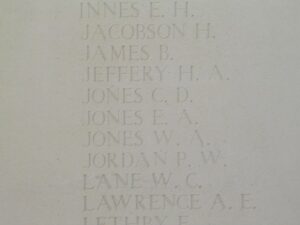
Charles Thomas Jones, Private, 34722, South Wales Borderers. Charles was born in Haverfordwest, and enlisted at Bristol into the 6th Battalion, South Wales Borderers. The battalion was attached to the 25th Division as Pioneers, and landed in France on 26 September 1915, moving to the Vimy area, where they defended Vimy Ridge against a German attack in May 1916. They then moved to the Somme area and attacked on 3 July 1916 near Thiepval. They fought throughout the Battle of the Somme, and then moved to Ploegsteert, where they held the line for the months leading up the Battle of Messines in June 1917. After fighting at Messines, the Division took part in the Battle of Passchendaele, before moving south again, where they took up positions around Bullecourt where it took part in the fighting which followed the German Spring Offensive. The division moved north to Flanders on the night of 30 March 1918, where they took up positions at Ploegsteert again, where they received reinforcements, and rebuilt. However, on 9 April the Germans launched an offensive on the Lys, and the Division was caught up in the terrible fighting here, taking heavy casualties over the coming weeks. On 9 May the Division moved to Fismes, 20 miles SE of Soissons in the Champagne, to give it a chance to rest and rebuild again. However, on 26 May they took up positions south of the Aisne, to guard against a predicted German Offensive, which hit them the following day, virtually wiping out the division. By 9 June the Division returned to England to rebuild, and returned to the front in September 1918, moving at first to St Riquier near Abbeville. Late in the month, it entrained for Fourth Army, coming under XIII Corps which was by now involved in the great offensive across Picardy, at Cambrai, the Selle, and Sambre. Charles died during the last week of the war, on 5 November 1918. He is buried at Pont-De-Nieppe Communal Cemetery, France.
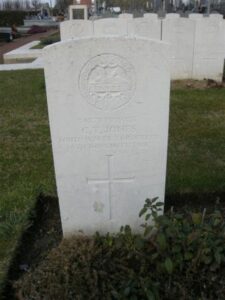
D E Jones, Lance Corporal, Welsh Regiment. This man cannot presently be identified.
George Frederick Jones, Private, 1140, Welsh Guards. George was the eldest son of Henry and Mary Jane Jones, of Haverfordwest. He enlisted at Llanelli into the 1st Battalion, Welsh Guards. The Regiment was raised by Royal Warrant of 26 February 1915, at White City, before landing at Le Havre on 18 August 1915, becoming attached to 3rd Guards Brigade, Guards Division. The Division saw its first major action during the Battle of Loos on 25 September 1915, remaining in the area during the coming months, where they also fought in the subsequent Action of Hohenzollern Redoubt. After a brief rest period, the Division moved for Ypres for a short spell in what was, at that time, a quiet sector. George was killed in action at Ypres on 29 April 1916, aged 23. He is buried at Potijze Burial Ground Cemetery, Belgium.
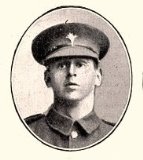
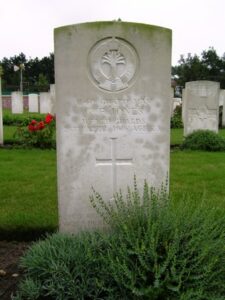
John Daniel Jones, Lieutenant, Royal Field Artillery. John was born in 1871, the son of George and Mary Jones, of Haverfordwest. His wife, Mrs A. M. Jones, resided at 53, Charlton Road, Blackheath, Kent. John was a long serving soldier, and had completed 28 years service by the time war erupted, and landed in France on 19 August 1914 as a Battery Sergeant Major with the 28th Brigade, Royal Field Artillery. John would have taken part in the epic retreat from Mons to the Marne, and on 3 November 1914 was commissioned as a Lieutenant. He served on the Western Front throughout several major battles thereafter, taking part in First and Second Ypres. John was wounded at the beginning of 1916, and evacuated to the Base Hospital at Le Havre, where he sadly died of his wounds on 21 February 1916, aged 45. John is buried there, at Ste. Marie Cemetery, Le Havre, France. His brothers, Peter McKenzie Jones and Clement Daniel Jones, also fell.
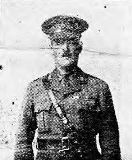
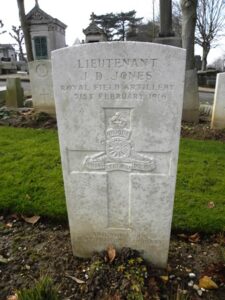
Peter McKenzie Jones, Private, 122194, Machine Gun Corps. Peter was the son of George and Mary Jones. He was a native of Haverfordwest, but the family had moved to London prior to the war, living at Paddington. Peter enlisted at Woolwich into the Army Ordnance Corps, with the Regimental Number 029162, but was later transferred into the 35th Battalion, Machine Gun Corps, which was attached to the 35th Division. The Division had moved to France in late January and early February 1916. It saw it’s first major action during the Battle of the Somme, at the Battle of Albert. After a spell out of the line, rebuilding, the Division followed the German Retreat to the Hindenburg Line in March 1917. Later in the year they moved north to Ypres, and fought at the Second Battle of Passchendaele. By Spring of 1918 they were back on the Somme, and fought at the First Battle of Bapaume, during the German Offensive. They were then moved back north, and fought later in the year at the Battle of Ypres, and then the Battle of Courtrai, and the subsequent Action of Tieghem. Peter was wounded during Fourth Ypres, and sadly died of his wounds at the Casualty Clearing Station west of Ypres, known as Remy Sidings, on 16 October 1918. He was 30 years old, and is buried there, at Lijssenthoek Military Cemetery, Belgium. Peter is shown as Welsh Regiment on the Memorial. His brothers John Daniel Jones and Clement Daniel Jones also fell.
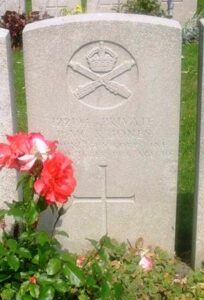
Thomas Jones, Private, 1756, Welsh Guards. Thomas was the son of Stephen and Sarah Jones, of Merlin’s Bridge, Haverfordwest. He married Ada Augustus Bennett at Narberth on 14 October 1913, and they lived at Lower House, South Dairy, Clarbeston Road. The couple had two young girls. Thomas enlisted at Haverfordwest on 30 June 1915 into the 1st Battalion, Welsh Guards. The Welsh Guards was raised on 26 February 1915 by order of King George V, in order to complete the national complement of regiments of Foot Guards, and became part of 3 Guards Brigade, Guards Division. On 17 August 1915 the 1st Battalion sailed for France, and took up position in the line at Loos. They fought with great distinction at Loos through the remainder of the year, and in summer of 1916 moved to the Somme, where they fought at the Battle of Flers-Courcelette, and then at the Battle of Morval, capturing Lesboeufs Village. Thomas joined the Welsh Guards on the Somme on 31 August 1916. Sadly he was killed here on 26 September 1916, aged 26. He had no known grave, and is commemorated on the Thiepval Memorial, France.
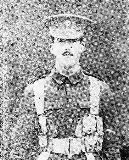
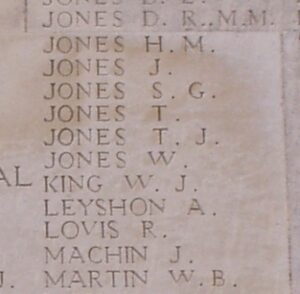
Thomas Evan Jones, Sergeant, 200005, Welsh Regiment. Thomas was born in 1886, the son of James and Ellen Jones, of New Street, Haverfordwest. He was a coach builder prior to the war, and resided with his wife Kate Jones and their children at 82, Dew Street, Haverfordwest. Thomas served with the 1/4th Battalion, Welsh Regiment. The Battalion had served at Gallipoli during 1915 attached to 159 Brigade, 53rd (Welsh) Division, and by 23 December 1915 were moved to Egypt. They remained on the Suez Canal Defences for the next twelve months, and in early 1917 moved into Palestine, where they remained for the duration of the war, fighting at the Battles of Gaza, and successfully capturing Jerusalem. Thomas was killed in action during the First Battle of Gaza, on 26 March 1917, aged 30. He has no known grave, and is commemorated on the Jerusalem Memorial, Israel.
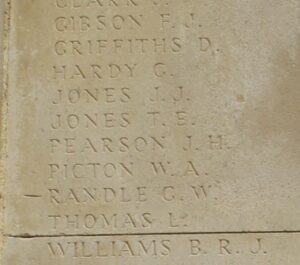
William Ellis Jones, Private, 54167, Welsh Regiment. William was born in Haverfordwest in 1879, and was a printer prior to the war, residing with his wife Edith Ann Jones at 170, Cardigan Road, Haverfordwest. He enlisted at Haverfordwest into the army, and was posted to France sometime in 1917, where he joined the 13th Battalion, Welsh Regiment, which had been on the Western Front since December 1915, attached to 114 Brigade, 38th (Welsh) Division. The Division had captured Mametz Wood during July 1916, and had moved via Hebuterne to Boesinghe, to rebuild in a quieter sector. William was killed here during the build up the Battle of Pilckem Ridge, on 21 July 1917, aged 38. He is buried at Bard Cottage Cemetery, Belgium. William is not commemorated on the Withybush Memorial.
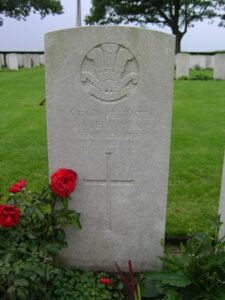
Ivor Norman Jones-Parry, Lieutenant, Royal Garrison Artillery. Ivor was the son of Thomas and Selina Alfreda Jones-Parry, of 5, Hillcrest Rd., Acton, London. His parents were formerly of Bank House, Amlwch, Anglesey, and the National Provincial Bank, Haverfordwest, Pembrokeshire. Ivor was educated at Llandovery College from 1906 until 1909, and at the outbreak of war he was a Second Lieutenant in No. 2 Company, Pembrokeshire Territorial’s. He was commissioned into the Royal Garrison Artillery on 12 August 1915, and moved to France late in 1916, serving with the 171st Siege Battery. Ivor was killed in action during the Battle of Arras, on 12 May 1917. He was 24 years old, and is buried at Mory Abbey Military Cemetery, France.
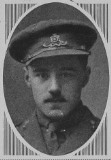
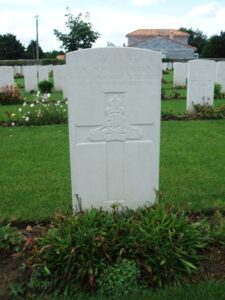
Stuart Leslie Keppel-Palmer, MC, Captain, Tank Corps. Stuart was the fourth son of Llewellin Keppel-Palmer, of Haverfordwest and Geneva, and of Johnston Hall. Born in 1894, he was educated at Bromsgrove and Winchester, and after unsuccessfully applying to join the Royal Navy, became a Pupil at the Lancaster and Yorkshire Locomotive Works at Horwich. He enlisted into the Royal Engineers in August 1914 and was commissioned in October that year. Stuart was transferred into the Tank Corps at its formation in 1916, and joined the 3rd Light Battalion. After surviving the inaugural use of the tank on the Somme in 1916, and the abortive attempt to use tanks in the sodden battlefields of Passchendaele in 1917, Stuart was wounded at their next major offensive at the Battle of Cambrai. Sadly Stuart was killed within weeks of the end of the war, on 3 October 1918, when his tank was hit twice by German shells. He was 24 years old, and is buried at Prospect Hill Cemetery, Gouy, France.

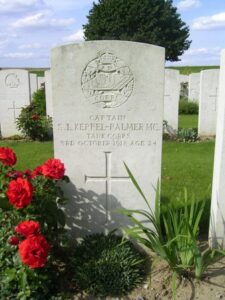
Evan James Knight, Private, 49234, South Wales Borderers. Evan was born at Haverfordwest, the son of John and Elizabeth Knight. The family moved to Arthur’s Court, Cardigan after John retired from the army. Evan married Caroline Humphreys, of 21, Mwldan, Cardigan in 1918, just after enlisting at Carmarthen into the army. He was posted to France to join the 10th Battalion, South Wales Borderers, which was attached to 115 Brigade, 38th (Welsh) Division. The 38th Division was in positions north of Albert, where it remained until launching its attack across the River Ancre on 21 August 1918. The Welshmen drove the Germans from Thiepval Ridge and Pozières, and began their offensive towards the mighty Hindenburg Line. Evan was killed at Épehy on 20 September 1918. He was just 19 years old, and is commemorated on the Vis-En-Artois Memorial, France. His widow later remarried, becoming Caroline Davies, of 1, Parade Road, Carmarthen. Evan is not commemorated on the Withybush Memorial.
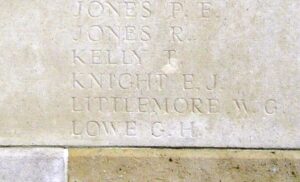
Mark Ernest Knighton, Private, 19747, Loyal North Lancashire Regiment. Mark was the son of Henry and Phoebe Knighton, of Rose Villa, Whittingham Road, Mapperley, Nottingham. He worked at Haverfordwest prior to the war and enlisted there into the 9th Battalion, Welsh Regiment. Mark was later posted to the 6th Battalion, Loyal North Lancashire Regiment, which was attached to 38 Brigade, 13th (Western) Division. On 13 June 1915 the Division sailed for Alexandria, and moved to Mudros before being landed at Cape Helles, Gallipoli from 6 July 1915, relieving the 29th Division. They left and returned to Mudros at the end of the month, and the entire Division landed at ANZAC Cove between 3 and 5 August 1915, taking part in heavy fighting over the coming days. Mark was killed in action at Gallipoli on 9 August 1915, aged 21. He is commemorated on the Helles Memorial, Gallipoli. Mark is not commemorated locally.
Alfred John Knights, Private, 16393, Norfolk Regiment. Alfred was the son of Arthur Benjamin and Emma Jane Knights, of 6, Cozens Road, Norwich. He worked at Haverfordwest prior to the war and enlisted there into the army. He landed in France on 4 October 1915 with the 9th Battalion, Norfolk Regiment, which joined 71 Brigade, 6th Division. Alfred was killed in action just before the division moved to the Somme, on 2 June 1916, aged 22. He is buried in Essex Farm Cemetery, Belgium. Alfred is not commemorated locally.
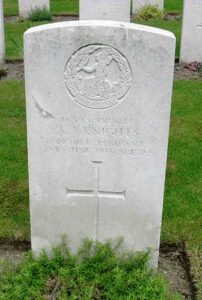
Harry Leigh, Driver, T3/027825, Royal Army Service Corps. Harry was the son of Reuben and Annie Leigh, of Hanley, and the brother of Reuben Leigh, of 28, Grange Street, Cobridge, Stoke-on-Trent. He worked as a teamster at Haverfordwest prior to the war and enlisted there on 9 November 1914 into the Army Service Corps as a driver. He landed in France on 24 September 1915, and was posted to the 200th Company, Army Service Corps, before being attached to the 75th Brigade HQ (25th Division). Harry died of broncho-pneumonia at 37 Casualty Clearing Station on 4 October 1918, aged 29, and is buried in Bronfay Farm Military Cemetery, Bray Sur Somme, France. Harry is not commemorated locally.
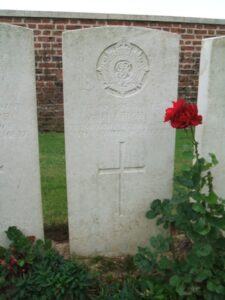
Montague William Leman, Private, 201914, Welsh Regiment. Montague was Born at Uppingham, Rutland in 1883, the son of William and Gertrude Leman, later of Great Yarmouth, and the husband of Ethel Maude Leman, of Uzmaston, Haverfordwest. He enlisted at Haverfordwest into the army, and was posted to the 15th (Carmarthen Pals) Battalion, Welsh Regiment, which was attached to 114 Brigade, 38th (Welsh) Division. The Division had landed in France during December 1915 and had spent their first winter in the trenches near Armentieres. In June they marched south to the Somme, where they famously captured Mametz Wood. The Division suffered terrible casualties at Mametz, and were taken out of the line, and moved to Ypres to rebuild. Here they fought at the Battle of Pilckem Ridge, and the Battle of Langemarck. They then moved to Armentieres, where they remained from September 1917 until March, 1918 when the German Spring Offensive was launched. The British had been over-run on the Somme, and so in April the Division was moved South, taking up positions North of Albert, from where they weathered the storm of the coming months, until launching their attack across the River Ancre on 21 August 1918, when the 15th Welsh assaulted and captured Thiepval Ridge and Pozieres. The Division then pushed eastwards, towards the mighty Hindenburg Line, and the Division fought at the Battle of Havrincourt, and the Battle of Epehy. A short rest period ensued, during which time the Canal du Nord was breached, so opening a passage through the Hindenburg Line. The Division then fought at the Battle of Beaurevoir, and moved up towards Cambrai, where they fought at the Battle of Cambrai. Montague was killed in action here on 8 October 1918. He was 35 years old, and is buried at Moulin-De-Pierre British Cemetery, France. Montague is listed on the Memorial as Royal Army Medical Corps.
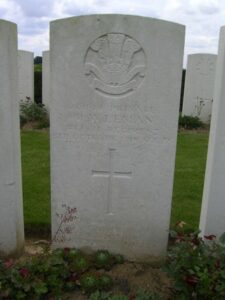
David Rees Lewis, Private, 53981, Welsh Regiment. David was the son of John Lewis, of 60, City Road, Haverfordwest. He married Sarah Alice Owens in 1912, of 137, Back Lane, Prendergast, Haverfordwest. David enlisted at Haverfordwest into the Welsh Regiment, and was posted to the 15th Battalion, Welsh Regiment, which was the Carmarthen Pals battalion, attached to 114 Brigade, 38th (Welsh) Division. The Division had landed in France during December 1915 and had spent their first winter in the trenches near Armentieres. In June they marched south to the Somme, where they took part in the famous capture of Mametz Wood. David probably joined the battalion after it had moved to Boesinghe, north of Ypres, in August 1916. Here they fought at the Battle of Pilckem Ridge, and the Battle of Langemarck. They then moved to Armentieres, where they remained from September 1917 until March 1918 when the German Spring Offensive was launched. The British had been over-run on the Somme, and so in April the Division was moved South, taking up positions North of Albert, from where they weathered the storm of the coming months. On 10 May 1918 the 15th Welsh were ordered to assault the German lines inside Aveluy Wood, and were to be supported by a creeping artillery barrage. Sadly, due to an error in range calculations, the shellfire fell short, and created havoc amongst the 15th Welsh. David was one of many men killed that day. He was 24 years old and is buried at Martinsart British Cemetery, France.
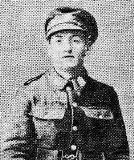
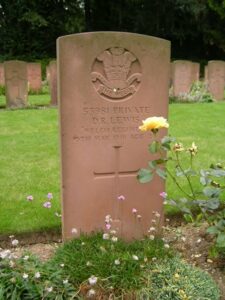
Thomas Henry Lewis, Private, 27474, Kings Shropshire Light Infantry. Thomas was the husband of Martha Jane Lewis, of 1, Queen’s Square, Haverfordwest. He enlisted there into the Welsh regiment, with the Regimental Number 3657, but later transferred into the 1st Battalion, Kings Shropshire Light Infantry, which was attached to 16 Brigade, 6th Division. On 10 September 1914 the Division landed at St Nazaire and proceeded to the Western Front, and arrived in time to reinforce the hard-pressed BEF on the Aisne, before the whole army was moved north into Flanders. Here they took part in the Action of Hooge during June 1915, and in 1916 took part in the Battles of the Somme. The following year saw them at Arras, where they fought at the Battle of Hill 70, and then during the Battle of Cambrai later in the year. In the spring of 1918 the Division was one of those hit by the German Offensive on the Somme, which had been launched on 21 March 1918, and the Division took part in the Battle of St Quentin. They were moved from the line, and went to Flanders to rest, but the following month the Germans launched another offensive on the Lys, and the Division fought during the Battle of Bailleul, the First Battle of Kemmel, and the Second Battle of Kemmel. During August 1918 the Allies had recovered sufficiently to be able to launch their own attacks on the Germans, and after a brilliant victory at Villers Brettoneux on 8 August, attacks were launched at Albert. The Division took part in the Advance in Flanders, before moving south, where they took part in the advance on the Hindenburg Line, during the Battle of Épehy. Thomas was killed in action here on 24 September 1918. He was 35 years old, and is buried at Trefcon British Cemetery, Caulaincourt, France.
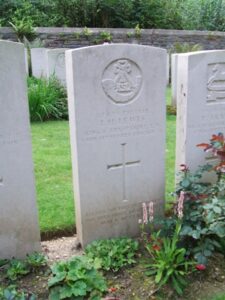
William Benjamin Lewis, Sergeant, G/25075, Middlesex Regiment. William was born in 1880, the son of George and Mary Lewis, of Prospect Place, Letterston. He enlisted at Letterston into the 13th Battalion, Duke of Cambridge’s Own Middlesex Regiment, which formed part of 73 Brigade, 24th Division. The Division was in the St. Quentin sector when the German Offensive (Kaiserschlacht) began on 21 March 1918. The British and Allied Armies mounted a desperate defensive action over the whole of the Western Front, with many units being totally annihilated by the German Stormtroopers. The first few weeks of the offensive were total chaos for the British, and William was Killed in Action on 28 March 1918, aged 37. His body was lost on the battlefield, and so William is commemorated on the Pozières Memorial, France.
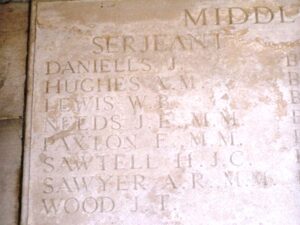
William George D. Lewis, Corporal, 92572, Royal Field Artillery. William was born at Haverfordwest in 1884, the son of Richard and Mary Lewis. The family later resided at 31, Mardy Road, Mardy, Glamorgan. He enlisted at Newport into the Royal Field Artillery, and served with ‘A’ Battery, 55th Brigade, attached to the 13th (Western) Division. Towards the end of February the Division concentrated at Blackdown in Hampshire, and on 13 June 1915 began to embark for Alexandria. By 4 July, all units had moved to Mudros, and from 6 July 1915, landed on Cape Helles, relieving the 29th Division. They left and returned to Mudros at the end of the month, and the entire Division landed at ANZAC Cove from 3 August 1915, taking part in the Battles of Sari Bair, Russell’s Top, and Hill 60. Soon afterwards the Division was transferred from ANZAC to Suvla Bay, and it was evacuated from Suvla on 19 December 1915, whereupon the infantry moved after a weeks rest to the Helles bridgehead, where they faced the last Turkish attacks at Helles. On 8 January 1916, the Division was evacuated from Helles, and by the 31st January was concentrated at Port Said, where they held forward posts in the Suez Canal defences. On 12 February 1916 the Division began to move to Mesopotamia, to strengthen the force being assembled for the relief of the besieged garrison at Kut al Amara. By 27 March, the Division had assembled near Sheikh Saad and came under orders of the Tigris Corps, and then took part in the attempts to relieve Kut. However, after these efforts failed and Kut fell, the British force in the theatre was built up and reorganised. William died here on 19 July 1916. He was 31 years old and is commemorated on the Basra Memorial, Iraq. William is not commemorated on the Withybush Memorial.
William Livermore, Private, 30968, Welsh Regiment. William was born in St. James, London in 1893. He worked at Portfield Gate as a Waggoner prior to the war, and enlisted at Carmarthen on 18 November 1914 into the Pembroke Yeomanry. William was discharged on 19 February 1915 after being deemed unfit to become an efficient soldier, but re-enlisted at Pembroke, and was posted to the 1st Battalion, Welsh Regiment, which was attached to 84 Brigade, 28th Division. The Division formed in England between December 1914 and January 1915 from regular units returning from India, Singapore and Egypt. During January 1915 it moved to France, landing at Le Havre and moved to the Western Front, where it saw its first major action during the Second Battle of Ypres. Following serious casualties at Ypres, a Composite Brigade was formed, composing of the 2nd Battalion, the Buffs, 2nd Battalion, the Cheshires, 1st Battalion, the Welsh, and 1st Battalion, the York and Lancaster. It was dissolved on 19 May 1915, and the formation assumed its normal configuration, taking part in the Battle of Loos. William was killed here on 2 October 1915, aged 22. He has no known grave and is commemorated on the Loos Memorial, France. William is not commemorated on the Withybush Memorial.
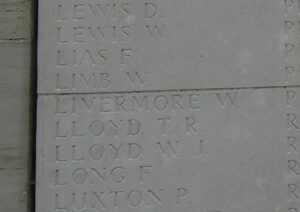
James Llewellyn, Fireman and Trimmer, Mercantile Marine. James was the son of Thomas and Elizabeth Llewellyn, of 133, Back Lane, Prendergast, Haverfordwest. He served in the Mercantile Marine aboard the SS Algiers, a defensively-armed Merchant ship, which had been built in 1882. On 26 February 1917, Algiers was three miles south of Owers Light Vessel, in the English Channel, when she was torpedoed without warning and sunk by the German submarine UC-65 whilst on a voyage from Calais to Barry Roads in ballast. Eight men died in the sinking, including James. He was 40 years old, and is commemorated alongside his crewmates on the Tower Hill Memorial, London. James is not commemorated on the Withybush Memorial.
William Alfred Peter Llewellyn, Rifleman, 1950, London Regiment. William was the son of John and Alice Llewellyn, of Haverfordwest. He was a schoolteacher in London prior to the war, and married Amy Elizabeth Treadgold in 1910. The couple resided at 6, Hillmarton Road, Holloway, London. William enlisted at London into the 1/5th Battalion (London Rifle Brigade), London Regiment, which was attached to 169 Brigade, 56th (London) Division. The Division fought its first major action at the diversionary attack on Gommecourt, on the opening day of the Battle of the Somme, on 1 July 1916. William was killed in action this day. He was 39 years old, and is commemorated on the Thiepval Memorial, France. William is not commemorated on the Withybush Memorial.
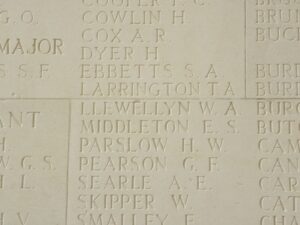
Ernest Lungley, Private, 2722, Welsh Regiment. Ernest was the son of William Frank Shaw Lungley and Lydia Eliza Lungley, of 9, Oxford Road, Angel Lane, Stratford, London. He resided at Haverfordwest prior to the war and enlisted there into the Welsh Regiment. He was posted to France during 1916-17, joining the 9th Battalion, Welsh Regiment, which was attached to 58 Brigade, 19th (Western) Division. Ernest was badly wounded during the Battle of Passchendaele, and died on 9 October 1917, aged 21. He is buried in Spoilbank Cemetery, Belgium. Ernest is not commemorated locally.
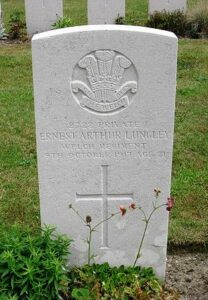
Joseph Edward Martin, Private, 1804, Welsh Regiment. Joseph was born at Flookburgh, Lancashire in 1894. He worked as a farm hand at Burton prior to the war, and enlisted at Haverfordwest into the 1st Battalion, Welsh Regiment, attached to the 84th Brigade, 28th Division. The Division formed in England between December 1914 and January 1915 from regular units returning from India, Singapore and Egypt. During January 1915 it moved to France, landing at Le Havre and moved to the Western Front, where it saw its first major action during the Second Battle of Ypres. Following serious casualties at Ypres, a Composite Brigade was formed, composing of the 2nd Battalion, the Buffs, 2nd Battalion, the Cheshires, 1st Battalion, the Welsh, and 1st Battalion, the York and Lancaster. It was dissolved on 19 May 1915, and the formation assumed its normal configuration. Joseph was wounded in Flanders, and evacuated to the French Hospital at Bailleul, where he died of wounds on 29 August 1915, aged 21. He is buried at Bailleul Communal Cemetery Extension, France. Joseph is not commemorated on the Withybush Memorial, although he is named on the County Memorial.
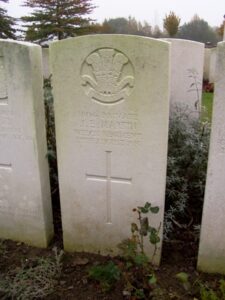
William Howard Martin, Second Lieutenant, Royal Welsh Fusiliers. William was the son of Thomas Henry and Martha Martin, of 14, Kensington Terrace, Barn Street, Haverfordwest. He was commissioned from the Artists Rifles into the Royal Welsh Fusiliers on 8 September 1916, and was attached to their 2nd Battalion. The Battalion had been on the Western Front since the outbreak of war, and by early 1916 was attached to 19 Brigade, 33rd Division. The Division moved to positions on the Southern end of the Somme sector, and fought through the Battles of the Somme, from July 1916 onwards. They then fought at Arras, at the Battle of the Scarpe and at Bullecourt, before heading to Ypres, and fighting at the Menin Road and at Polygon Wood. William was killed in action at Ypres on 31 July 1917, aged 29. He has no known grave, and is commemorated on the Ypres (Menin Gate) Memorial, Belgium.
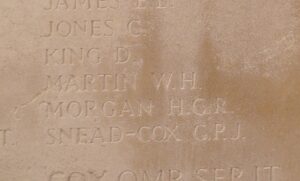
Charles Mathias, Driver, T4/069665, Royal Army Service Corps. Charles was the son of Charles Mathias, of St. Martin’s, Haverfordwest. He was the husband of Margaret Harriet Mathias, and the couple lived at Ferndale prior to the war. Charles enlisted there into the Welsh Regiment, with the Regimental Number 26908. Charles later transferred into the Army Service Corps, and served with the 43rd Divisional Train. The 43rd Division was a Territorial unit, and on 24 September 1914, accepted overseas service in India in order to relieve regular units required for active service. Divisional and Brigade HQs, both artillery and infantry, did not embark for India. The other units of the Division sailed on 9 October 1914 and moved to India where they remained throughout the Great War. Charles must have taken ill before embarking for India, as he died at Bangor on 15 June 1915. He was 36 years old and is buried at Rhondda (Ferndale) Cemetery. Charles is not commemorated on the Withybush Memorial.
Thomas Morgan Mathias, Company Sergeant Major, 2, Welsh Regiment. Morgan was the husband of Edith Alice Mathias, of 14, North Crescent, Haverfordwest. He had served in the South African Campaign, and was recalled to the colours at the outbreak of war, becoming a Company Sergeant Major in the 1/4th Battalion, Welsh Regiment, at Carmarthen. Morgan was issued the Regimental Number 2. The Battalion became attached to 159 Brigade, 53rd (Welsh) Division some months later, and moved to the Mediterranean, sailing from Devonport in July, 1915, and arrived at Mudros by 5 August 1915. From here they moved to Gallipoli, landing on 8 August 1915. Here they immediately faced the chaotic leadership that was to lead to the ultimate failure of the campaign, and spent the next few days in isolated pockets, fighting against a Turkish counter-attack during the Battle of Sari Bair, and then at the Attack on Scimitar Hill. Morgan was killed in action on his second day at Gallipoli, on 10 August 1915. He was 39 years old, and having no known grave, is commemorated on the Helles Memorial, Gallipoli.
Lawrence McNamee, Private, 18121, South Wales Borderers. Lawrence was from Aidenderry, Kingscourt, Ireland. He resided at Haverfordwest prior to the war and enlisted there into the 5th Battalion, South Wales Borderers, which was attached to 58 Brigade, 19th (Western) Division. He landed in France with the division on 17 July 1915, and moved with it to positions north of Loos. The division took part in the opening attack of the Battle of Loos on 25 September 1915. The following year the Division moved to the Somme, where it took part in the second wave of the attack on Ovillers-La Boiselle on 1 July, capturing the village at heavy cost. It then fought through the Somme Battles of Pozières and the Ancre in 1916. In 1917 the Division moved north to Ypres, taking part in the Battle of Messines, and the Battle of Passchendaele. On 21 March 1918 the division was caught up in the German Spring Offensive near St. Quentin, and suffered terrible casualties over the coming days. Lawrence was killed in action here on 25 March 1918. He has no known grave and is commemorated on the Arras Memorial, France. Lawrence is not commemorated locally.
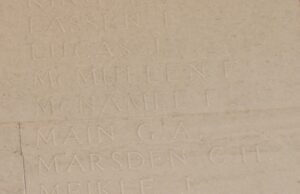
John Harold Merriman, Private, 200089, Welsh Regiment. John was born in Haverfordwest on 30 November 1897, the son of William and Jane Merriman, of 42, Prendergast Hill. He had worked at the GWR Station at Whitland prior to the war, and enlisted back at Haverfordwest into the 1/4th Battalion, Welsh Regiment. The Battalion was attached to 159 Brigade, 53rd (Welsh) Division, and moved to the Mediterranean, sailing from Devonport in July 1915, and arrived at Mudros by 5 August 1915. From here they moved to Gallipoli, landing on 8 August 1915. Here they immediately faced the chaotic leadership that was to lead to the ultimate failure of the campaign, and spent the next few days in isolated pockets, fighting against a Turkish counter-attack during the Battle of Sari Bair, and then at the Attack on Scimitar Hill. John was killed in action on his second day at Gallipoli, on 10 August 1915, aged 17. He has no known grave, and is commemorated on the Helles Memorial, Gallipoli.
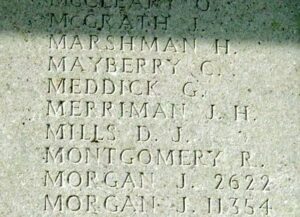
Charles Henry Morgan, Private, 126129, Machine Gun Corps. Charles was the son of Thomas Henry and Janet Morgan, of 34, Dew Street, Haverfordwest. He enlisted there into the Welsh Regiment, with the Regimental Number 203538, and after training as a Lewis Gun Specialist, was transferred into the 38th Battalion, Machine Gun Corps, attached to the 38th (Welsh) Division. The Division had landed in France during December 1915 and had spent their first winter in the trenches near Armentieres. In June they marched south to the Somme, where they were tasked with the capture of Mametz Wood. The attack on the wood began on 7 July, but met with fierce resistance, and it took until 14 July to clear the wood. The Division suffered terrible casualties at Mametz, and were taken out of the line, and moved to Ypres to rebuild. Here they fought at the Battle of Pilckem Ridge, and the Battle of Langemarck. They then moved to Armentieres, where they remained from September 1917 until March, 1918 when the German Spring Offensive was launched. The British had been over-run on the Somme, and so in April the Division was moved south, taking up positions North of Albert, from where they weathered the storm of the coming months, until the war turned during the Battle of Amiens, on 8 August, 1918. The Germans had now lost the upper hand, and the British regained the lost ground on the Somme after an attack which began on 21 August, with the 38th Welsh in the midst of the attack during the Battle of Albert, and then moving east, where they fought at the Battle of Bapaume. Charles was wounded during the Battle of Albert, and died on 24 August 1918. He is buried at Daours Communal Cemetery Extension, France. His brother Frederick was killed at Gallipoli in November 1915. For some reason Charles is not commemorated on the Withybush Memorial, but his brother Frederick, who fell at Gallipoli, is.
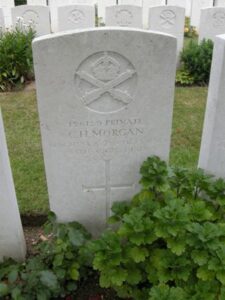
Edwin Morgan, Able Seaman, 184874, Royal Navy. Edwin was born on 29 August 1877, the son of Henry and Ann Morgan, of 78, City Road, Haverfordwest. On his 18th birthday, on 29 August 1895, he enlisted into the Royal Navy for 12 years, and was posted to HMS Northampton. Over the following years he served aboard a multitude of ships, including HMS Revenge, Britannia, Majestic, Caesar and Minotaur, before completing his service on 29 August 1907. Edwin must have enjoyed life at sea, as he remained in the Royal Navy, and by the outbreak of war was back serving aboard HMS Britannia. He served at sea for a further two years during the war, but was discharged on 13 June 1916 after becoming ill, and was diagnosed with Pulmonary Tuberculosis. He died at Haverfordwest on 5 June 1917, aged 39, and was buried in St. Martin’s Cemetery, Haverfordwest. Edwin’s case was passed to the CWGC in August 2014, and he has been accepted for commemoration on Saturday 31 January 2015. His name will be added to the United Kingdom Book of Remembrance until the location of his grave has been verified by the CWGC.
Frederick Morgan, Private, 390, Welsh Regiment. Frederick was the son of Thomas Henry and Janet Morgan, of 34, Dew Street, Haverfordwest. Frederick was one of the many young men of Haverfordwest who joined the local Battalion, the 1/4th Battalion, Welsh Regiment, which was attached to 159 Brigade, 53rd (Welsh) Division. The Division moved to the Mediterranean, sailing from Devonport in July 1915 arriving at Mudros by 5 August 1915. From here they moved to Gallipoli, landing on 8 August. Here they immediately faced the chaotic leadership that was to lead to the ultimate failure of the campaign, and spent the next few days in isolated pockets, fighting against a Turkish counter-attack during the Battle of Sari Bair, and then at the Attack on Scimitar Hill. The Division remained here throughout the coming months, and suffered severe losses in manpower strength during the great November 1915 blizzard on Gallipoli, when its total strength was reduced to less than that of a full-strength Brigade. By now Frederick had been evacuated to Malta, where he died of sickness on 5 November 1915, aged 20. Frederick is buried at Pieta Military Cemetery, Malta. His brother Charles also fell.
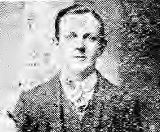
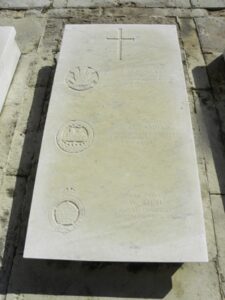
James Morgan, Private, 201447, Welsh Regiment. James was the son of William and Maria Morgan, of 128, Prendergast, Haverfordwest. He was another of the many young men of Haverfordwest who joined the local Battalion, the 1/4th Battalion, Welsh Regiment, which was attached to 159 Brigade, 53rd (Welsh) Division. The 53rd Division moved to the Mediterranean, sailing from Devonport in July 1915 arriving at Mudros by 5 August 1915. From here they moved to Gallipoli, landing on 8 August 1915. Here they immediately faced the chaotic leadership that was to lead to the ultimate failure of the campaign, and spent the next few days in isolated pockets, fighting against a Turkish counter-attack during the Battle of Sari Bair, and then at the Attack on Scimitar Hill. The Division remained here throughout the coming months, and suffered severe losses in manpower strength during the great November 1915 blizzard on Gallipoli, when its total strength was reduced to less than that of a full-strength Brigade. On 11 December 1915 the Division was evacuated to Mudros, and by 23 December 1915 were moved to Egypt. They remained on the Suez Canal Defences for the next twelve months, and in early 1917 moved into Palestine, where they remained for the duration of the war, fighting at the Battles of Gaza, and successfully capturing Jerusalem. James was killed in action during the First Battle of Gaza, on 26 March 1917, aged 36. He has no known grave, and is commemorated on the Jerusalem Memorial, Israel.
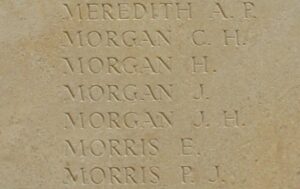
James Henry Morgan, Driver, 38442, Royal Engineers. James was born in Pembroke, the son of James and Martha Morgan, later of 3, North Gate, Haverfordwest. He enlisted at Haverfordwest into the Royal Welsh Fusiliers, but was later transferred to the Royal Engineers. He was posted to their 127th Field Company, attached to the 22nd Division. The Division crossed to France in early September 1915, with all units being concentrated near Flesselles by the 9th of the month. However, it’s stay in France was to be very short, as on 27 October, 1915 the Division, having been moved by train to Marseilles, began to embark for Salonika. It completed concentration there in November, although the final artillery units were still coming in as late as the 13th December 1915. It remained in the theatre for the rest of the war, taking part in the Retreat from Serbia during December, 1915. Between 10 to 18 August 1916 they fought at the battle of Horseshoe Hill, and around this time, James took ill and was hospitalised. He died on 22 August 1916, aged 21, and is buried at Salonika (Lembet Road) Military Cemetery, Greece.
John Randall Morgan, Private, 54455, Welsh Regiment. John was the son of Mrs. Sarah Gertrude Evans, of 37, Cartlett, Haverfordwest. He enlisted at Port Talbot into the 14th (Swansea City) Battalion, the Welsh Regiment, which was attached to 114 Brigade, 38th (Welsh) Division. The Division had landed in France during December 1915 and had spent their first winter in the trenches near Armentieres. In June they marched south to the Somme, where they were tasked with the capture of Mametz Wood. The attack on the wood began on the 7th July, but met with fierce resistance, and it took until the 14th July to clear the wood. The Division suffered terrible casualties at Mametz, and were taken out of the line, and moved to Ypres to rebuild. Here they fought at the Battle of Pilckem Ridge, and the Battle of Langemarck. John was killed at Langemarck on 5 August 1917, aged only 19. He has no known grave, and is commemorated on the Ypres (Menin Gate) Memorial, Belgium.
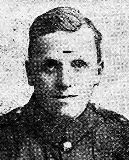
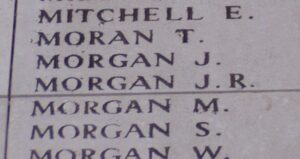
James Oliver, Private, 200189, Welsh Regiment. James was born on 1 March 1889, the son of John and Margaret Oliver, of 18, Spring Gardens, Haverfordwest. James was educated at Haverfordwest, and worked there as a Compositor prior to the war. When war was declared in August 1914 James enlisted at Haverfordwest into the 1/4th Battalion, Welsh Regiment, which was attached to 159 Brigade, 53rd (Welsh) Division. Just after enlisting, James married Frances Charlotte Hale Davies, daughter of Richard Davies, of 26, Prendergast Hill, Haverfordwest. The Division then moved to the Mediterranean, sailing from Devonport in July 1915 and arriving at Mudros by 5 August 1915. From here they moved to Gallipoli, landing on 9 August. Here they immediately faced the chaotic leadership that was to lead to the ultimate failure of the campaign, and spent the next few days in isolated pockets, fighting against a Turkish counter-attack. The Division remained here throughout the coming months, and suffered severe losses in manpower strength during the great November 1915 blizzard on Gallipoli, when its total strength was reduced to less than that of a full-strength Brigade. On 11 December 1915 the Division was evacuated to Mudros, and by the 23rd December 1915 were moved to Egypt. They remained on the Suez Canal Defences for the next twelve months, and in early 1917 moved into Palestine, where they remained for the duration of the war, fighting at the Battles of Gaza, and successfully capturing Jerusalem. James was wounded during Operations in the Jordan Valley, and died on 10 March 1918. He was 28 years old, and is buried at Jerusalem War Cemetery, Israel.
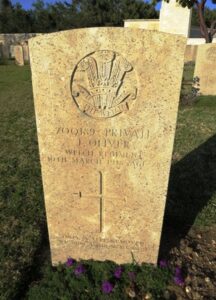
John O’Shea, Private, 61620, Welsh Regiment. John was born at Haverfordwest in 1893, the son of Michael and Mary O’Shea. The family resided at Cardiff prior to the war, and John enlisted at Maesteg on 17 January 1914 into the 3rd Battalion, Welsh Regiment. John was sent to France with the 2nd Welsh at the outbreak of war, and was wounded by gunshot in the chest at Ypres on 12 November 1914. After recovering, he served with the 6th Welsh, until being posted to the 24th Battalion, Welsh Regiment during July 1917, which was in Palestine, attached to 231 Brigade, 74th (Yeomanry) Division. They took part in the Third Battle of Gaza, and captured Jerusalem in December 1917. During May 1918 the Division was transferred to France, and moved to positions on the Lys. They then moved to the Somme, and fought at the Second Battle of Bapaume during the great offensive, before suffering heavily at the Battle of Épehy, as part of the offensive towards the Hindenburg Line. John was wounded in the advance towards the Epehy Sector, and died at the 231st Field Ambulance on 8 September 1918, aged 25. He is buried at Tincourt New British Cemetery, France. John is not commemorated on the Withybush Memorial.
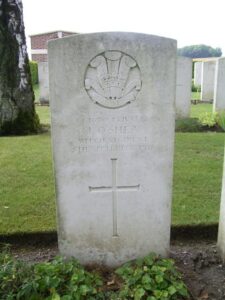
Francis Leonard Owen, Private, 10021, Royal Fusiliers. Francis was the son of William Henry and Eliza Owen, of 3, Gloucester Terrace, Haverfordwest. He enlisted there into the 12th Battalion, Royal Fusiliers, which was attached to 17 Brigade, 24th Division. They moved to France during August, 1915 and marched to positions near Loos, where they took up reserve positions for the main Battle of Loos. The Division were sent into battle on 26 September 1915 at Loos and suffered terrible casualties due to not being properly trained for battle, and were pulled from the line until the following year. In 1916 they took part in the Battle of the Somme, and fought at Delville Wood and Guillemont, before moving north of Arras in early 1917. Francis was killed here, in French Flanders, on 26 January 1917. He was 22 years old, and is buried at Philosophe British Cemetery, Mazingarbe.
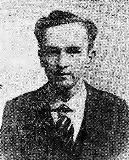
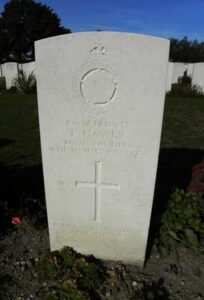
John Owen, Private, 39429, South Wales Borderers. John was the son of George and Martha Owen, of Clayford, South Dairy, Clarbeston Road, Pembrokeshire. He enlisted at Haverfordwest into the Monmouthshire Regiment, with the Regimental Number 4667, but later transferred into the 5th Battalion, South Wales Borderers. The Battalion was attached to 58 Brigade, 19th (Western) Division. The Division assembled around Bulford during September 1914. Divisional training was completed near Tidworth, from March 1915, and the Division crossed to France during July 1915, moving to positions near Loos. The Division fought during the opening attack of the Battle of Loos, and then moved to the Somme, where they took part in the second wave of the attack on Ovillers-La Boiselle on the 1st July, capturing the village at heavy cost, and fought through the Somme Battles of Pozieres and the Ancre in 1916. They then moved North to Ypres, taking part in the Battle of Messines, and fought on the Menin Road and at Polygon Wood, before moving up to Broodseinde, Poelcappelle and Passchendaele Village itself. In 1918 they were caught up in the German Spring Offensive near St. Quentin, where they suffered terrible casualties, and fought at the Battle of Bapaume. They moved to Ypres, but were caught up in the German attack at Messines, and at Bailleul, and Kemmel. John was killed here on 8 May 1918. He was just 20 years old, and is buried at Nine Elms British Cemetery, Belgium.
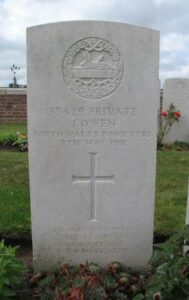
Levi George Owen, Private, 464, Welsh Regiment. Levi was the son of Benjamin and Sarah Owen, of 14, Stepney Terrace, Prendergast, Haverfordwest. He enlisted there into the 1/4th Battalion, Welsh Regiment, which was attached to 159 Brigade, 53rd (Welsh) Division. The 53rd Division moved to the Mediterranean, sailing from Devonport in July 1915 arriving at Mudros by 5 August 1915. From here they moved to Gallipoli, landing on 9 August. Here they immediately faced the chaos that was to lead to the ultimate failure of the campaign, and spent the next few days in isolated pockets, fighting against a Turkish counter-attack during the Battle of Sari Bair, and then at the Attack on Scimitar Hill. Levi was killed two weeks later, on 22 August 1915, aged 21. He is commemorated on the Helles Memorial, Gallipoli.
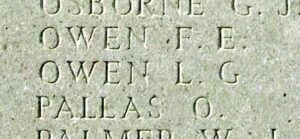
Benjamin Thomas Owens, Company Sergeant Major, 15151, Royal Welsh Fusiliers. Benjamin was born at St. Martin’s, Haverfordwest in 1874. He was a regular soldier, and had enlisted at Colwyn Bay into the Royal Welsh Fusiliers. After the outbreak of war Benjamin joined the 11th Battalion, Royal Welsh Fusiliers, which was attached to 67 Brigade, 22nd Division. The Division crossed to France in early September 1915, but its stay in France was short, as on 27 October 1915 the Division began to embark for Salonika, completing concentration there in November 1915. It remained in the theatre for the rest of the war, taking part in the Retreat from Serbia during December 1915. During August 1916 it took part in the battle of Horseshoe Hill, and during September 1916 at the battle of Machukovo. Between April and May 1917 the Division fought at the battle of Doiran, and then on 18 September 1918 at the Second Battle of Doiran. Benjamin was killed during the Battle, on 18 September 1918, aged 44. He is buried at Doiran Military Cemetery, Salonika. Benjamin is not commemorated on the Withybush Memorial.
Charles Picton Owens, Engineman, 4846ES, Royal Naval Reserve. Charles was born on 1 March 1890, the son of Thomas and Anne Owens, of 40 Prendergast, Haverfordwest. He was an engineer at Milford Haven prior to the war, and resided with his wife Lilian Owens, at 12 City Road, Haverfordwest. Charles served in the Royal Naval Reserve, aboard H.M. Drifter Active III. Charles died when she was lost at sea on 15 October 1917. He was 27 years old, and is commemorated on the Plymouth Naval Memorial, Devon.
James Page, Private, 282103, Lancashire Fusiliers. James was born at Haverfordwest in 1885, the son of William and Ann Page. He resided at 14, Elm Street, Cardiff prior to the war, working in a flour mill, and enlisted at Cardiff into the army. He was posted to the 2/7th Battalion, Lancashire Fusiliers, which was attached to 197 Brigade, 66th (2nd East Lancs) Division. The Division concentrated on the Western Front by 16 March 1917 and moved to the Flanders Coast. At the end of September 1917 they moved to Ypres, and took part in the Battle of Poelcapelle. James was killed in action here on 9 October 1917, aged 32. He has no known grave and is commemorated on the Tyne Cot Memorial, Belgium. James is not commemorated on the Withybush Memorial.
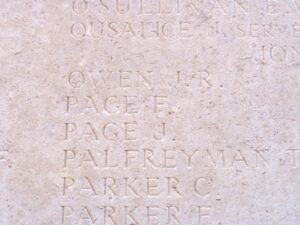
William John Peterson, Lance Corporal, 50289, Machine Gun Corps. William was originally born as William John Jones, and was the son of Florence Mary Jones. She later married Mr G. Peterson, of 63, Merlins Hill, Haverfordwest. William had served during the Great War as a Machine Gunner, but was possibly wounded towards the end of the war, as he died in hospital at Cardiff on 19 February 1919, aged 22. William is buried at St. Martin’s Cemetery, Haverfordwest. William is commemorated at St. Thomas Church, and not on the Withybush Memorial.
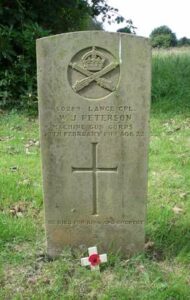
Charles Frederick Phillips, Private, 51557, Lincolnshire Regiment. Charles was born at Haverfordwest in 1895. He lived at Ellesmere Port prior to the war, and enlisted into the Liverpool Regiment, with the Regimental Number 22809. At some stage Charles transferred into the 5th Battalion, Lincolnshire Regiment, which was attached to 138 Brigade, 46th (North Midland) Division. The Division moved to France during February 1915, and saw its first action at the Hohenzollern Redoubt near Loos. The Division suffered large numbers of casualties during the attack, which was its first large-scale action. On 23 December 1915 the Division was ordered to proceed to Egypt, however on 21 January 1916 the move was countermanded and the units returned to France. Here the Division took part in the Attack on the Gommecourt Salient, which was a diversionary attack on 1 July 1916 intended to draw attention away from the main attack on the Somme, but the Division again suffered large numbers of casualties during the attack. They rested for several months at Arras, and at the end of 1916 took part in Operations on the Ancre. During March 1917 the Division followed the German Retreat to the Hindenburg Line, and then fought in the Battle of Arras, taking part in the Battle of Hill 70. In 1918 the Division saw action during the German Offensive on the Lys, and it was here that Charles was killed, on 15 April 1918, aged 22. He has no known grave, and is commemorated on the Ploegsteert Memorial, Belgium. Charles is not commemorated on the Withybush Memorial.
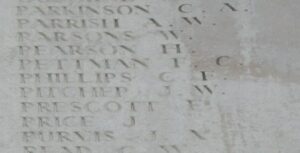
George Edward Phillips, Corporal, 27262, Welsh Regiment. George was the son of John and Maria Phillips, of Rose Cottage, Prendergast, Haverfordwest. He enlisted at Neath into the Welsh Regiment, and served with the 8th Battalion, attached to 40 Brigade, 13th (Western) Division. Towards the end of February the entire Division concentrated at Blackdown in Hampshire. On 7 June 1915 orders were received to prepare to move to the Mediterranean. On 13 June 1915 the first transports carrying the Division left port, and moved to Alexandria. By 4 July, all units had moved to Mudros, preparatory for landing on Gallipoli. Between 6 and 16 July 1915 the Division landed on Cape Helles and relieved the 29th Division. They left and returned to Mudros at the end of the month, and the entire Division landed at ANZAC Cove between 3 and 5 August 1915, taking part in the Battle of Sari Bair, and the Battle of Russell’s Top. George was killed in action here on 8 August 1915, aged 23. He is commemorated on the Helles Memorial, Gallipoli.
Ivor Lewis Phillips, Private, 728, Welsh Regiment. Ivor was born in 1899, the son of Joseph and Amelia Phillips, of 13, Cartlett, Haverfordwest. He enlisted at Carmarthen into the 1/4th Battalion, Welsh Regiment, which was formed there on 4 August 1914, as part of South Wales Brigade, Army Troops. In November 1914 they moved to Tunbridge Wells, and then in February 1915 to Scotland on Forth and Tay Defences. On 17 April 1915 they joined 159 Brigade, 53rd Division at Bedford. Ivor took ill about this time, and was hospitalised. He died on 12 May 1915, aged just 16, and was buried at St. Thomas A’Beckett Churchyard, Haverfordwest.
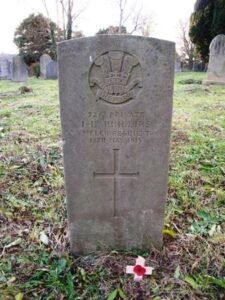
William Phillips, Private, 45761, Welsh Regiment. William was born at Llawhaden in 1881, the son of William and Hannah Phillips. By 1911 the family had moved to 26, City Road, Haverfordwest. William enlisted at Haverfordwest into the army, and was posted to the 16th (Cardiff) Battalion, Welsh Regiment, which was attached to 115 Brigade, 38th (Welsh) Division. The Division had landed in France during December 1915 and had spent their first winter in the trenches near Armentieres. In June they marched south to the Somme, where they famously captured Mametz Wood. The Division suffered terrible casualties at Mametz, and were taken out of the line, and moved to Ypres to rebuild. Here they fought at the Battle of Pilckem Ridge, and the Battle of Langemarck. William was killed in action here on 4 August 1917, aged 36. He has no known grave, and is commemorated on the Ypres (Menin Gate) Memorial, Belgium.
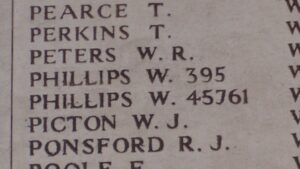
William George Phillips, Private, 54385, Welsh Regiment. William was born at Pembroke in 1891, the son of John and Martha Phillips. Prior to the war he worked as a farm labourer at Haverfordwest He had originally enlisted into the Pembroke Yeomanry, before being posted to the 16th Battalion, Welsh Regiment, which was in France attached to 115 Brigade, 38th (Welsh) Division. William probably joined the Division after its battle at Mametz Wood in July 1916. The Division lost a huge amount of men at Mametz, and moved to positions north of Ypres, at Boesinghe, to rebuild after its ordeal. William was wounded during a trench raid at Boesinghe. He died of his wounds on 23 May 1917, aged 25, and is buried at Ferme-Olivier Cemetery, Belgium.
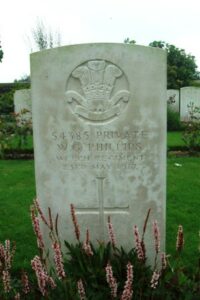
William Thomas Phillips, Private, 54384, Welsh Regiment. William was born in Haverfordwest, and enlisted there into the Pembroke Yeomanry. He was posted to the 16th Battalion, Welsh Regiment, which was attached to 115 Brigade, 38th (Welsh) Division. The Division had landed in France during December 1915 and had spent their first winter in the trenches near Armentieres. In June they marched south to the Somme, where they famously captured Mametz Wood. The Division suffered terrible casualties at Mametz, and were taken out of the line, and moved to Ypres to rebuild. Here they fought at the Battle of Pilckem Ridge, and the Battle of Langemarck. William was killed in action here on 27 August 1917. He has no known grave, and is commemorated on the Tyne Cot Memorial, Belgium.
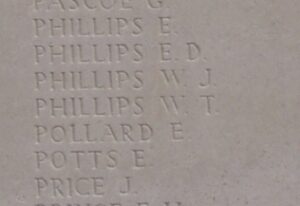
Griffith Philpin, Lance Corporal, 19779, Welsh Regiment. Griffith was born in Haverfordwest in 1878, the son of Griffith and Jane Philpin. The family later resided at Aberaman. Griffith was the husband of Margaret Philpin, of 59, Brynmair Road, Cwmaman, Aberdare. He enlisted at Aberdare into the 2nd Battalion, Welsh Regiment, which was attached to 3 Brigade, 1st Division. The Division had been one of the first to arrive in France, fighting at the Battle of Mons, and taking part in the retreat to the Marne, where the Germans were stopped. They then fought at the Aisne, and at Chivy, before being moved North to Ypres. Here they fought at the First Battle of Ypres, where they again stopped the German Offensive, before wintering in Flanders. The following year saw them in action again at the Battle of Aubers, before moving South to Loos, where they fought during the Battle of Loos, and the action at the Hohenzollern Redoubt. Again they were required for a major offensive, moving South to the Somme, where they fought during the opening of the Somme Offensive at the Battle of Albert, then at Bazentin, Pozieres, Flers-Courcelette and Morval. Griffith was wounded on the Somme, and died as a result on 14 September 1916. He was 38 years old and is buried at Millencourt Communal Cemetery Extension, France. Griffith is not commemorated on the Withybush Memorial.
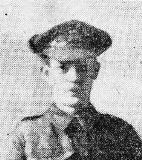
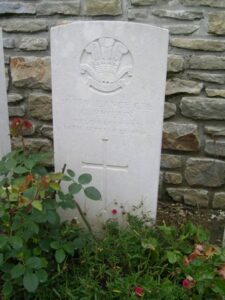
John James Rees, Private, CMT/373, Royal Army Service Corps. John was born in Haverfordwest in 1891, and prior to the war resided with his wife, Emily Mary Rees, at 70, Marble Hall Road, Llanelli. He enlisted at Llanelli into the Army Service Corps, and served with the 40th Division Salvage Company, attached to the 40th (Bantam) Division. This Division was formed between September and December 1915, and moved to France during June 1916, moving to the front near Loos. Late in 1916 they moved south to the Somme, and fought at the Battle of the Ancre, and remained in the area over the winter. In March 1917 the Germans withdrew to their shortened line, called the Hindenburg Line, and the Division was one of the Divisions that followed the withdrawal. Later in the year they took part in the Battle of Cambrai, playing an important role in the attack on Bourlon Wood. They remained in the area over the coming months, but were caught here by the German Spring Offensive of 21 March 1918, and fought there at the Battle of St Quentin and retreating back westwards fought at the First Battle of Bapaume. Due to the terrible casualties suffered by the Division here they were sent north to Flanders to rest and rebuild, but in April the Germans launched an offensive in Flanders, and the 40th Division were caught up in the thick of it again, fighting at the Battle of Estaires, and then at the Battle of Hazebrouck. John was killed after this period, on 27 May 1918, aged 26. John is buried at Warlincourt Halte British Cemetery, Saulty, France. John is not commemorated on the Withybush Memorial.
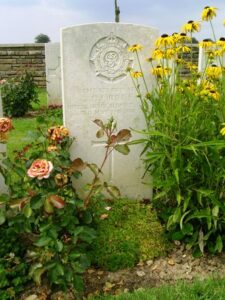
William Rees, Private, 26740, Wiltshire Regiment. William was born at Haverfordwest, and moved to Crewkerne, Somerset prior to the war. He was the Father of Donald D. Rees, of Queen’s Hotel, Crewkerne, Somerset. William enlisted into the Dorsetshire Regiment, with the Regimental Number 18255, and later transferred into the 2nd Battalion, Wiltshire Regiment, which was attached to 21 Brigade, 30th Division. The Division moved to France in November 1915, and took part in its first major action during the Somme Offensive, at the Battle of Albert, where they captured Montauban. They then fought during the latter stages of the offensive, during the Battle of Le Transloy, before wintering on the Somme. In March 1917 the Division followed the German Retreat to the Hindenburg Line, and in April took part in the First Battle of the Scarpe, and then at the later Second Battle of the Scarpe. William was killed in action at Arras on 9 April 1917. He has no known grave, and is commemorated on the Arras Memorial, France. William is not commemorated on the Withybush Memorial.
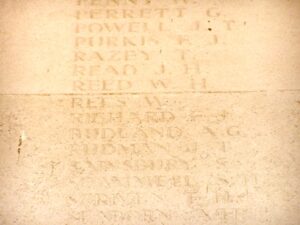
Daniel Hugh Reynish, Private, 5217, London Regiment. Daniel was the son of James and Elizabeth J. Reynish, of 60, Barn Street, Haverfordwest. He lived at Battersea prior to the war, and enlisted there into the 23rd Battalion, London Regiment. The Battalion formed at St. John’s Hill, London during August 1914 and became attached to 142 Brigade, 47th (2nd London) Division. The Division moved to France during March, 1915, and served with distinction on the Western Front throughout the war. The new designation of the Division, its Brigades and other constituent units changed from the 2nd London to 47th in mid May 1915. The Division fought at the Battle of Aubers, and the Battle of Festubert during May, 1915 and in September fought at the Battle of Loos, and subsequent Action of Hohenzollern Redoubt. They were north of Arras when the Germans attacked Vimy Ridge, and then moved south to the Somme, where they fought at the Battle of Flers-Courcelette, and then at the Battle of Le Transloy, where the Division captured Eaucourt l’Abbe, and took part in Attacks on the Butte de Warlencourt. They then moved north to Flanders, and it was there that Daniel was wounded soon after arriving there. He was taken to the Casualty Clearing Station at Remy Sidings for treatment, but died of his wounds there on 27 November 1916. Daniel was 35 years old, and is buried at Lijssenthoek Military Cemetery, Belgium.
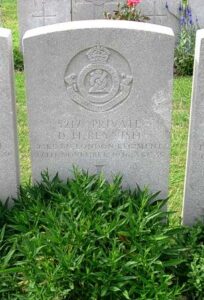
Edward Henry Richards, Private, 21678, Worcestershire Regiment. Edward was the son of Thomas Richards, of Haverfordwest. He lived with his wife, Mary Richards, at 19, Francis Street, Belle Green Lane, Higher Ince, Wigan, where he worked as a railway signalman. Henry enlisted at Bolton into the Worcestershire Regiment, and joined the 4th Battalion, attached to 88 Brigade, 29th Division. The Division moved to Gallipoli via Egypt, landing on 25 April 1915. They remained here until evacuation to Egypt on 11 January 1916, fighting throughout all of the main battles on the Peninsula, and it was during one of these, the Battle of Sari Bair, that Edward was killed, on 6 August 1915. He has no known grave and is commemorated on the Helles Memorial, Gallipoli. Edward is not commemorated on the Withybush Memorial.
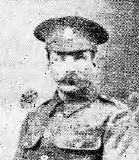
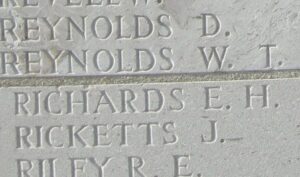
James Richards, Private, 41052, Hampshire Regiment. James was born in Haverfordwest on 6 July 1895. Sometime between 1915 and 1916, he married a Laugharne woman, my great grandmother, Mary Ann Brown, daughter of David and Elizabeth Brown of Frog Street, Laugharne, who was working as a farm servant outside Haverfordwest. James enlisted into the army, and was posted to the 2/5th Battalion, Hampshire Regiment. The 2/5th Battalion, a territorial Battalion, formed at Salisbury Plain in September 1914, becoming part of 2/1st Hampshire Brigade, 2nd Wessex Division. On 13 December 1914 they sailed for India, and on 29 April 1917 left for Egypt, arriving at Ismailia on 5 April 1917, where they became attached to 232 Brigade, 75th Division. The 75th Division Formed in Egypt in March and April 1917, and under special instruction included units of the Indian Army. The assembly of the various units required was slow and the Division did not take final shape until August 1918. Artillery was difficult to provide, and the Division included a brigade supplied by South Africa. The Division served in Egypt and Palestine, taking part in the Third Battle of Gaza during October/November 1917, then the Capture of Junction Station, the Battle of Nabi Samweill and the capture of Jerusalem. At some stage around the time of the Battle of Nabi Samweill, James fell ill, and was hospitalised at Alexandria. He passed away on 9 December 1917, aged 22. His bereaved widow, Mary Ann had already suffered the heartbreak of the death of their twenty one month old daughter Florence Martha Richards who had passed away during September 1917 without James ever having the chance to see his daughter. James was buried in Alexandria (Hadra) War Memorial Cemetery. He was just 22 years old. Mary remarried after the war and died in 1976 in Laugharne.
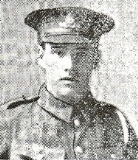
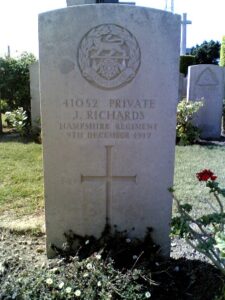
James Bowen Richards, Private, 53642, Cheshire Regiment. James was born in 1899, the son of John and Margaret Richards, of 21, Portfield, Haverfordwest. He enlisted at Haverfordwest into the Army on 14 September 1916, and was mobilised on 20 September 1917. On 8 April 1918 James was posted to the 1st Battalion, Cheshire Regiment, which was attached to 15 Brigade, 5th Division. The Division had fought on the Western Front since the beginning of the war, and had seen action in almost every major offensive of the war. On 2 August 1918, James was wounded, after being shot in the chest. He was taken prisoner by the Germans, and died of his wounds on 1 December 1918, aged 19. James is buried in Germany at Cologne Southern Cemetery.
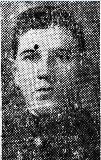
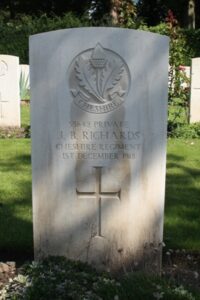
William Roach, Gunner, 46857, Royal Garrison Artillery. William was the son of William and Elizabeth Roach of Poyston Cross, Rudbaxton. He worked as a farm labourer prior to the war and enlisted at Haverfordwest into the Royal Garrison Artillery. William served with the 68th Siege Battery on the Western Front, and was wounded whilst the Battery was on the Somme in August 1916. He was evacuated to the Base Hospital at Abbeville, where he sadly died of his wounds on 19 August 1916, aged 21. William is buried at Abbeville Communal Cemetery, France. William is commemorated at St. David’s Church, Haverfordwest, but not at Withybush.
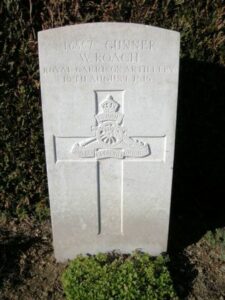
Arthur Roberts, Lance Corporal, 39965, Welsh Regiment. Arthur was the son of Arthur and Elizabeth Roberts, of Rhos Common, Four Crosses, Montgomeryshire. He resided at Haverfordwest prior to the war and enlisted there into the army. He was posted to France during 1916, joining the 2nd Battalion, Welsh Regiment, which was attached to 3 Brigade, 1st Division. Arthur served with the battalion during the Battle of Passchendaele, and was killed in action during the latter stages of the offensive, on 9 November 1917, aged 24. He is buried in Tyne Cot Military Cemetery, Belgium. Arthur is not commemorated locally.
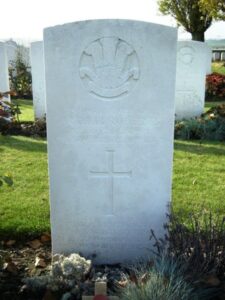
Thomas Walter Roberts, Corporal, 63268, Royal Garrison Artillery. Thomas was born at Haverfordwest in 1891, the son of William and Mary Ann Roberts. The family later resided at 17 Glaneynon Terrace, Aberaman, Aberdare, and on 31 July 1912, Thomas married Lilian May Roberts, of 7, York Street, Godreaman, Aberdare. Thomas enlisted there on 3 November 1915 into the Royal Garrison Artillery, and sailed for France with the 160th Heavy Battery, Royal Garrison Artillery on 30 July 1916. Thomas was transferred to the 117th Siege Battery on the Western Front within days of landing. Thomas was wounded at Ypres in October 1917, but rejoined his unit on 13 February 1918. He was killed in action during the Offensive in Flanders on 8 August 1918, aged 27. Thomas is buried at Merville Communal Cemetery Extension, France. Thomas is not commemorated on the Withybush Memorial.
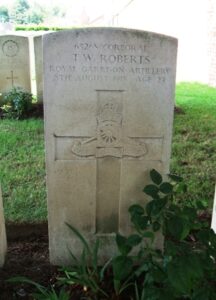
George Garnet Robinson, Private, 306050, London Rifle Brigade. George was the son of George and Rachael Robinson, of 61, Worthing St., Beverley Road, Hull. He served with the London Regiment, in the 5th Battalion (London Rifle Brigade). The Battalion had been in France since 5 November 1914, and joined 11 Brigade, 4th Division at Bailleul, and took part in the famous Christmas Truce. George would have joined the battalion at sometime in 1918 as part of a draft. The Division was in the Arras sector when the German Spring Offensive was launched on 21 March, 1918 and fought at the resulting Battle of Arras. George was killed just prior to the Battle of Albert, on 12 August 1918. He was just 18 years old, and is buried at Pernois British Cemetery, Halloy-Les-Pernois, France. His links to Haverfordwest are unclear, but he is the only man matching the details on the memorial.
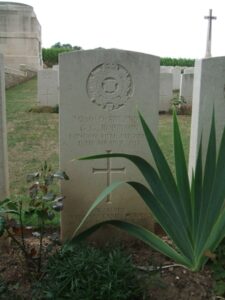
Benjamin James Rodney, Gunner, 30002, Royal Field Artillery. Benjamin was born in 1894, the son of Thomas and Ann Rodney, of Mill Cottage, Prendergast. He worked in the Great Western Railway Station at Llanybydder, and enlisted at Preston into the Royal Field Artillery, being posted to their ‘A’ Battery, 77th Brigade, and landed in France on 21 July 1915. The Brigade was attached to the 16th (Irish) Division, and took part in the famous Battle of Messines, where the Irish and Australians took the Ridge from the Germans. Benjamin died of wounds on 29 July 1917, aged 23, and is buried in Mendinghem Military Cemetery, Belgium. His brother, George Stanley Rodney, also fell.
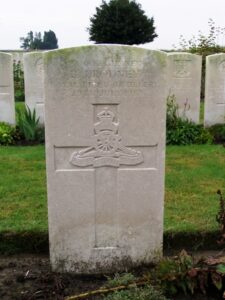
George Stanley Rodney, Gunner, 120940, Royal Field Artillery. George was the son of Thomas and Ann Rodney, of 30 Mill Cottage, Haverfordwest. He enlisted there into the Royal Field Artillery, and served with ‘A’ Battery, 251st Brigade, which was attached to the 50th (Northumbrian) Division. George probably joined his unit on the Somme in 1916, where they fought at the Battle of Flers-Courcelette, the Battle of Morval and the Battle of Le Transloy. After spending a winter on the Somme, they moved north to Arras, where they took part in the Arras Offensive of April, 1917, and fought at the First Battle of the Scarpe, capturing the Wancourt Ridge. They then fought at the Second Battle of the Scarpe, before being sent north again to Ypres. Here they fought at the Second Battle of Passchendaele, and remained here for the winter. During March 1918 they were stationed near St. Quentin, and were hit here by the German Spring Offensive of 21 March 1918 during the Battle of St Quentin. They took part in a gallant rearguard action during the Actions at the Somme Crossings, and then at the Battle of Rosieres. After suffering terrible casualties, the Division moved north to Flanders to rest and rebuild, but in April the Germans launched an attack in Flanders, around the Lys, and the Division took part in the Battle of Estaires, and the Battle of Hazebrouck. Following a most trying time on the Somme and Lys battlefields, the Division was withdrawn and sent to IX Corps, then on the Aisne, believed to be a much quieter area. This was unfortunately not the case, as the Division was hit hard by a surprise enemy attack, and fought at the Battle of the Aisne, 1918. George was killed in action during the Battle of the Aisne, on 27 May 1918. He was 27 years old, and is commemorated on the Soissons Memorial, France. His brother, Benjamin James Rodney, also fell.
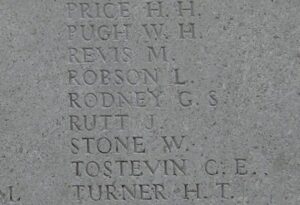
Charles Allen Rogers, Private, 57225, Welsh Regiment. Charles was born in 1887, the son of Henry James Rogers and Sarah Ann Rogers (nee Davies), of Mariner’s Square, Haverfordwest. He married Rose Harries in 1910, and the couple resided at 18, Bush Row, Haverfordwest. Charles enlisted at Swansea into the 7th (Cyclist) Battalion, Welsh Regiment on 18 March 1915, and on 26 July 1916 landed in France, where he was posted to the 13th Battalion, Welsh Regiment which was attached to 114 Brigade, 38th (Welsh) Division. The Division had landed in France during December 1915 and had spent their first winter in the trenches near Armentieres. In June they marched south to the Somme, and famously captured Mametz Wood. Charles was part of a draft of reinforcements which helped rebuild the strength of the decimated battalion after it had been pulled from the Somme, and moved to Ypres to rebuild. Here they fought at the Battle of Pilckem Ridge, and the Battle of Langemarck, which is where Charles was killed in action on 21 August 1917, aged 30. He has no known grave, and so is commemorated on the Tyne Cot Memorial, Belgium.
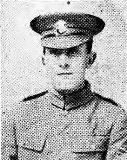
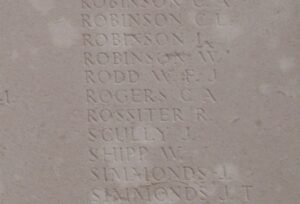
Morton Rogers, Private, G9384, Queen’s Own Royal West Kent Regiment. Morton was born at St. Martin’s, Haverfordwest, the son of George Roberts, cork cutter. He enlisted there into the Army, and was posted to the 10th Battalion, Queen’s Own Royal West Kent Regiment, which was attached to 123 Brigade, 41st Division. This Division was formed in September 1915, and moved to France by 6 May 1916, concentrating near Steenwerck, where they began familiarisation with trench warfare in the areas of Ploegsteert and the Douve valley, south of Ypres. They remained here until August 1916, when they moved to the Somme, and took part in the Battle of Flers-Courcelette and the Battle of Le Transloy, before moving to positions south of Ypres in 1917. Here they took part in the Battle of Messines, before moving further north, where they fought at the Battle of Pilckem, and the Battle of the Menin Road, as part of the Third Battle of Ypres. The Division was selected as one of five British Divisions to be moved to Italy, as part of a reinforcement action taken by the Allies following a disastrous defeat of the Italian Army at Caporetto. The Company arrived at Mantua on 17 November 1917, where they held a part of the line on the River Piave, however, the crisis had passed and the Division was hurried back to the Western Front in early March 1918. They then faced the German Spring Offensive of 21 March 1918, and fought at the Battle of St Quentin, and retreated westwards, fighting at the First Battle of Bapaume. Morton was killed on the third day of the German Offensive, on 23 March 1918, aged 26. He has no known grave and is commemorated on the Arras Memorial, France. Morton is not commemorated on the Withybush Memorial.
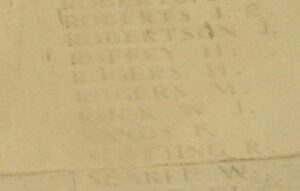
William Alban Rogers, Rifleman, 653437, London Regiment. William was the son of Richard and Mary Anne Rogers, of Broad Haven, and the husband of Nellie Rogers, of 9, Cintra Park, Upper Norwood, London. He enlisted at Camberwell into the London Regiment, and served with the 21st Battalion (1st Surrey Rifles), which was attached to 142 Brigade, 47th (2nd London) Division. The Division moved to France between 9 and 22 March, 1915, and served with distinction on the Western Front throughout the war. The new designation of the Division, its Brigades and other constituent units changed from the 2nd London to 47th in mid May 1915. The Division fought at the Battle of Aubers, and the Battle of Festubert during May 1915 and in September fought at the Battle of Loos, and subsequent Action of Hohenzollern Redoubt. They were north of Arras when the Germans attacked Vimy Ridge, and then moved south to the Somme, where they fought at the Battle of Flers-Courcelette, and then at the Battle of Le Transloy, where the Division captured Eaucourt l’Abbe, and took part in Attacks on the Butte de Warlencourt. Early in 1917 the Division moved north to Belgium, and took part in the Battle of Messines, which is where William was killed on 7 June 1917. He was 35 years old, and is commemorated on the Ypres (Menin Gate) Memorial, Belgium.
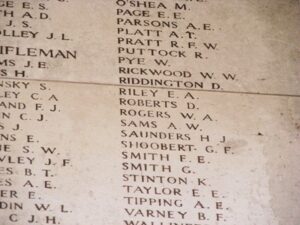
James Gwynne Vaughan Rowlands, Rifleman, 393080, London Regiment. James was the son of William Gwynne Rowlands and Mary Rowlands, of 1, Castle Terrace, Haverfordwest. He enlisted at London into the 28th Battalion (Artists Rifles), London Regiment, and transferred into the 9th Battalion (Queen Victoria’s Rifles), which was attached to 169 Brigade, 56th (London) Division. The Division fought during the Battle of the Somme, at the diversionary attack on Gommecourt, then at Ginchy, Flers and Morval, where they captured Combles. They wintered on the Somme, and followed the German retreat to the Hindenburg Line in March, 1917 before fighting in the Battle of Arras. They then moved to Ypres, where they fought at the Battle of Langemarck. The Battalion was still at Ypres when James was killed in action on 27 September 1917, aged 22. He has no known grave, and so is commemorated on the Tyne Cot Memorial, Belgium.
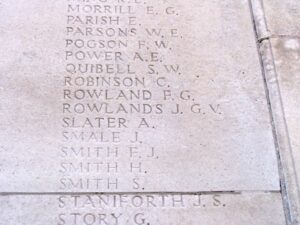
Thomas Henry Saies, Private, 335, Welsh Regiment. Thomas was the son of John Arthur Saies and Jane Elizabeth Saies, of 109, Cowley Cottages, Portfield, Haverfordwest. He had enlisted at Haverfordwest into the Welsh Regiment at the outbreak of war, and was posted to the 1/4th Battalion, which had been formed at Carmarthen during August, 1914. The Battalion became attached to 159 Brigade, 53rd (Welsh) Division. The 53rd Division moved to the Mediterranean, sailing from Devonport in July, 1915 arriving at Mudros by the 5th August, 1915. From here they moved to Gallipoli, landing on 9 August. Here they immediately faced the chaos that was to lead to the ultimate failure of the campaign, and spent the next few days in isolated pockets, fighting against a Turkish counter-attack. Thomas was wounded during his first days on Gallipoli, and was evacuated via Hospital Ship to the Base Hospital at Lemnos. Sadly, Thomas died of wounds there on 1 September 1915, aged 19. He was buried at Portianos Military Cemetery, Lemnos, Greece.
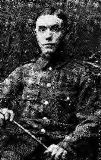
James David Simpson, Private, 15060, South Wales Borderers. James was born at Haverfordwest in 1895, the son of James and Jessie Simpson. The family moved around the country, following work, but by the time of the war resided at 55, Old Castle Road, Llanelli. James enlisted at Llanelli into the 7th Battalion, South Wales Borderers, which was attached to 67 Brigade, 22nd Division. The Division crossed to France in early September 1915, but its stay in France was short, as on 27 October 1915 the Division, having been moved by train to Marseilles, began to embark for Salonika, completing concentration there in November 1915. It remained in the theatre for the rest of the war, taking part in the Retreat from Serbia during December 1915. During August 1916 they fought at the battle of Horseshoe Hill, then in September 1916 at the battle of Machukovo. Between April and May 1917 the Division fought at the battle of Doiran. James was killed in action during the Second Battle of Doiran, on 25 September 1918, aged 23. He is commemorated on the Doiran Memorial, Salonika. James is not commemorated on the Withybush Memorial.
James Dudley Sinnett, Private, 94670, Royal Army Medical Corps. James was the son of Councillor Richard and Martha Sinnett, of 25, Portland Terrace, Haverfordwest. He was working as a nurse at Marylebone, London prior to the war, and enlisted there on 27 January 1916 into the Royal Army Medical Corps. He worked at the 2nd Northern General Hospital at Leeds, before being posted to the 35th Company, RAMC. James died of pneumonia at Queen Alexandra’s Military Hospital, Millbank on 13 January 1918, aged 27. He was buried at St. Martin Cemetery, Haverfordwest.
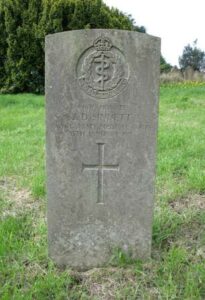
Frank Slate, Trimmer, Mercantile Marine. Frank was born at Haverfordwest in 1866, and was the husband of Ellen Slate of 28, Church Street, Haverfordwest. He served in the Mercantile Marine, as Trimmer aboard the Steam Trawler Victoria, which was registered at Fleetwood. Frank was killed when the Victoria was shelled and sunk by a German U-Boat on 1 June 1915. He was 48 years old and is commemorated on the Tower Hill Memorial, London. Frank is not commemorated on the Withybush Memorial.
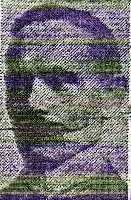
Charles George Smith, Deck Hand, 511DA, Royal Naval Reserve. Charles was born on 29 June 1883, the son of George and Priscilla Smith, of Gt. Yarmouth, Norfolk. He resided with his wife, Beatrice L. Smith, at 21, North Street, Haverfordwest, and served with the Royal Naval Reserve aboard HM Trawler Cantatrice. She was a hired trawler, which was used for minesweeping in the North Sea. Charles was killed when Cantatrice struck a mine on 5 November 1916. He was 33 years old, and is commemorated on the Chatham Naval Memorial, Kent. Charles is not commemorated on the Withybush Memorial.
Arthur Llewellyn Thomas, Sapper, 43178, Royal Engineers. Arthur was the only son of William and Martha Thomas, of 26, Dew Street, Haverfordwest. He enlisted there into the Royal Engineers, and was posted to the 75th Field Company, which was attached to the Guards Division. This Division has the distinction of being formed in France in August 1915, from the various Guards units that had been with other Divisions. It remained on the Western Front throughout the war and saw its first major action during the Battle of Loos on 25 September 1915, remaining in the area during the coming months, where they also fought in the subsequent Action of Hohenzollern Redoubt. In July, 1916 the Division moved to the Somme, where they fought at the Battle of Flers-Courcelette, and then at the Battle of Morval, capturing Lesboeufs Village. They remained here for the winter, and in March, 1917 took part in the advance caused by the German Retreat to the Hindenburg Line. Later that year they moved north to Ypres, taking up positions north of Boesinghe, on the Yser Canal. Arthur was killed during a trench raid on 3 July 1917, aged 23. He is commemorated on the Ypres (Menin Gate) Memorial, Belgium.
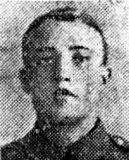
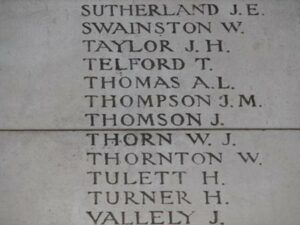
Edwin Thomas, Lance Corporal, 6194, Kings Shropshire Light Infantry. Edwin was the son of George and Hannah Thomas, of Haverfordwest. He was a reservist at the outbreak of war, and re-enlisted at Pontypridd into the King’s Shropshire Light Infantry. Edwin served in France with one of the regular battalions of the KSLI from 6 December 1914. He was transferred to the 7th Battalion, KSLI at some time after it moved to France on 28 September 1915. The Battalion landed at Boulogne, and transferred to the 3rd Division. The Division was at Ypres, and fought at the Actions of the Bluff, and at the St Eloi Craters. In the summer of 1916 the division took part in the Somme offensive, before wintering in the Somme sector. In May 1917 the Division fought in the Battle of Arras, before moving north to Ypres, where it fought in the Third Battle of Ypres. In November the Division moved south again, where they fought at the Battle of Cambrai, and they were in the area during March, 1918 when the German Spring Offensive swept through the British lines, at the Battle of St Quentin and the First Battle of Bapaume. They then fought at the First Battle of Arras, 1918 before being moved to Flanders to rebuild. However the Germans switched the focus of their offensive to Flanders, and the Division were caught up in the worst of the fighting there, at the Battle of Estaires, and then at the Battles of Hazebrouck and Bethune. By now the German offensive had stalled, and the Division were moved south to take part in the great British offensive, and on 21 August 1918 fought at the Battle of Albert. Edwin was killed on the first day of the Battle, on 21 August 1918, aged 25. He has no known grave, and is commemorated on the Vis-En-Artois Memorial, France. He is listed on the Memorial as Welsh Regiment.

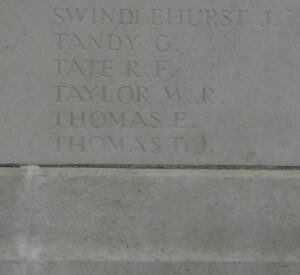
Frederick Spriggs Thomas, Captain, Welsh Regiment. Frederick was the son of the late Mr. and Mrs. James Spriggs Thomas, of Haverfordwest. He taught at King Charles I School, Kidderminster prior to the war. Frederick was commissioned into the 1/4th Battalion, Welsh Regiment on 9 November 1914. The battalion was a Territorial battalion, attached to 159 Brigade, 53rd (Welsh) Division. The 53rd Division moved to the Mediterranean, sailing from Devonport in July 1915 arriving at Mudros by 5 August 1915. From here they moved to Gallipoli, landing on 8 August 1915. Here they immediately faced the chaotic leadership that was to lead to the ultimate failure of the campaign, and spent the next few days in isolated pockets, fighting against a Turkish counter-attack during the Battle of Sari Bair, and then at the Attack on Scimitar Hill. The Division remained here throughout the coming months, and suffered severe losses in manpower strength during the great November 1915 blizzard on Gallipoli, when its total strength was reduced to less than that of a full-strength Brigade. On 11 December 1915 the Division was evacuated to Mudros, and by 23 December 1915 were moved to Egypt. They remained on the Suez Canal Defences for the next twelve months, and in early 1917 moved into Palestine, where they remained for the duration of the war, fighting at the Battles of Gaza, and successfully capturing Jerusalem. Frederick was wounded during the move into Palestine, and died at the 54th Casualty Clearing Station on 21 April 1917, aged 25. He is buried at Deir El Belah War Cemetery, Israel.
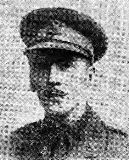
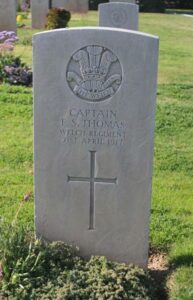
George Warren Thomas, MM, Private, 10086, Welsh Regiment. George was born at Dew Street, Haverfordwest in 1890, the son of William Thomas and Elizabeth Thomas (nee Warren), and was the Grandson of George Thomas, of Portfield, Haverfordwest. He was a pre war regular, after having enlisted at Cardiff into the 2nd Battalion, Welsh Regiment, and had served in India. At the outbreak of war, the 2nd Welsh was attached to 3 Brigade, 1st Division. The Division had been one of the first to arrive in France, fighting at the Battle of Mons, and the retreat to the Marne, where the Germans were stopped. They then fought at the Aisne, and at Chivy, before being moved north to Ypres. Here they fought at the First Battle of Ypres, before wintering in Flanders. The following year saw them in action again at the Battle of Aubers, before moving South to Loos, where they fought during the Battle of Loos, and the action at the Hohenzollern redoubt. Again they were required for a major offensive, moving south to the Somme, where they fought throughout the Somme Offensive. They followed the German retreat to the Hindenburg Line in early 1917, and were then briefed for an operation on the Flanders Coast, and moved there during the summer of 1917. While training on the coast, the Battle of Third Ypres had stalled in the mire, and the Division were recalled to Ypres, where they fought at the Second Battle of Passchendaele. After spending another winter in Flanders, they were near Estaires when the German Spring Offensive caught them, and they took part in heavy fighting before being moved South again to Arras. George was wounded at Arras, and died as a result on 6 June 1918, aged 27. He is buried at Pernes British Cemetery, Pernes-en-Artois, France. He had been awarded the Military Medal twice for Bravery in the Field during the war. George is not commemorated on the Withybush Memorial.
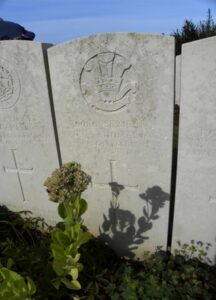
George Henry Thomas, Assistant Officer’s Steward, Mercantile Marine. George was the son of George Henry and Jessie Lavinia Thomas, of St. Thomas Green, Haverfordwest. By 1911 the family had moved to 35, Peter Road, Walton, Liverpool. George worked as an Officer’s Steward for the White Star Line, aboard the passenger liner S.S. Lusitania. On Saturday 1 May 1915 sailed from New York aboard the steamship S.S. Lusitania, which was bound for Liverpool. On 7 May 1915, Lusitania was sailing past the Old Head of Kinsale, off Ireland, when she was hit by a torpedo from the German submarine U-20, and sank with the loss of 1,198 lives. George was 21 years old when he died that day, and is commemorated on the Tower Hill Memorial, London. George is not commemorated on the Withybush Memorial.
Henry Thomas, Private, 6284, Royal Welsh Fusiliers. Henry was born at Haverfordwest in 1875, and had served during the Boer War with the South African Light Horse. He was an army reservist at the outbreak of war, and re-enlisted at Aberavon into the 1st Battalion, Royal Welsh Fusiliers on 6 October 1914. At the outbreak of war the cadre of the battalion was in Malta, and was rushed back to Britain where it joined 22 Brigade, 7th Division. The Division was formed during September 1914 and landed at Zeebrugge on 6 October 1914. The City was already falling however, and so the Division was moved to Ypres, where they became the first British Division to hold the city. They fought during the First Battle of Ypres, and helped stop the German advance through Belgium, and in March 1915 fought at the Battle of Neuve Chappelle. During May they fought at the Battle of Aubers Ridge, and at Festubert, where Henry was killed in action on 16 May 1915, aged 39. He has no known grave, and is commemorated on the Le Touret Memorial, Richebourg-L’Avoue, France.
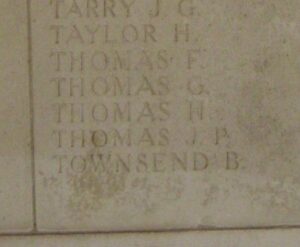
John Arloe Edward Thomas, Leading Carpenter, 345555, Royal Navy. John was the son of Charles and Martha Thomas, and was born on 27 August 1880 at Horsepool Farm, Laugharne. When Charles retired from farming at Horsepool, the family moved to number 17, St. Thomas’ Green, Haverfordwest. John would have already been in the Royal Navy at the outbreak of the Great War. He was a Leading Carpenter, with the service number 345555, aboard HMS Hawke. Here he served with another local man, Engineering Lieutenant Commander Thomas Morgan David, of Laugharne. HMS Hawke was an Edgar Class Cruiser, which saw service in the war as a converted depot ship for destroyers and submarines. She was torpedoed and sank by the German submarine U-9 on 15 October 1914, with the loss of 500 men. Only 70 survived. John was lost in the sinking of the Hawke, along with his fellow Laugharne man Thomas Morgan David. He was 34 years old, and is commemorated on the Chatham Naval Memorial, Kent.
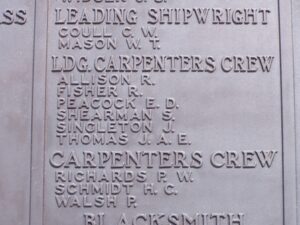
Mawbrey Charles Thomas, Private, M2/079602, Royal Army Service Corps. Mawbrey was born in Haverfordwest in 1875, the son of Caroline Thomas. By 1904 his father had died, and Caroline had married Henry Lloyd, of Garage House, Prospect Place, Llanelli. Mawbrey enlisted at Swansea into the Royal Army Service Corps, and served with the 593rd Company. Mawbrey was then attached to the XIV Corps Heavy Artillery. He was at Ypres during the spring of 1916 when he took ill and died on 23 June 1916, aged 40. Mawbrey was buried at Vlamertinghe Military Cemetery, Belgium. He is not commemorated on the Withybush Memorial.
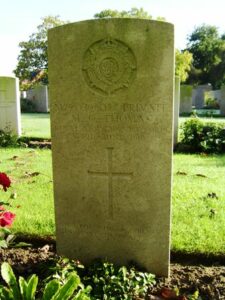
Thomas Thomas, Private, 2989, Australian Infantry. Thomas was born at Haverfordwest, and was the Brother of David Thomas, Grocer, of Fishguard, and of Benjamin George Thomas, of Gabriel Farm, Portfield Gate, Haverfordwest. Thomas had served for eight years with the 6th Dragoon Guards before emigrating to Australia prior to the war. When war broke out, he enlisted at Goulborn, NSW into the 55th Battalion, AIF. On 25 October 1916 Thomas embarked at Sydney aboard HMAT Ascanius, and disembarked at Devonport on 28 December 1916. He was almost immediately admitted to Hospital at Bulford suffering from VD, and didn’t join his Training Battalion until 20 April 1917. On 23 August 1917 Thomas embarked to France to join the 36th Battalion. The Battalion was attached to the 9th Australian Brigade, 3rd Australian Division. The Division moved to Ypres later in the year, and took part in the Battle of Messines. They then joined the veteran 1st and 2nd Australian Divisions at Ypres, and fought at the Battle of Broodseinde. They then fought at Passchendaele, and it was here that Thomas was killed on 3 October 1917. He was 37 years old and has no known grave, and so is commemorated on the Ypres (Menin Gate) Memorial, Belgium. Thomas is not commemorated on the Withybush Memorial.
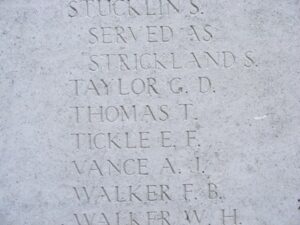
William James Thomas, Private, 202218, Welsh Regiment. William was born at Haverfordwest in 1883, the son of Enos and Mary Ann Thomas. The family had moved to 1, Glandwr Terrace, Penygraig prior to the war. William enlisted at Tonypandy into the 17th Battalion, Welsh Regiment. The Battalion was attached to 119 Brigade, 40th (Bantam) Division. This Division was formed between September and December 1915, composed of bantam units and others which had a mixture of regulation-height and shorter men, and moved to France during June 1916, taking up the front near Loos. Late in 1916 they moved south to the Somme, and fought at the Battle of the Ancre, and remained in the area over the winter. In March 1917 the Germans withdrew to their shortened line, called the Hindenburg Line, and the 40th Division were one of the Divisions that followed the withdrawal. Later in the year they took part in the Battle of Cambrai, playing an important role in the attack on Bourlon Wood. William was wounded here, and evacuated through the network of Casualty Clearing Stations, back to England for treatment, but died of his wounds on 12 December 1917, aged 34. William is buried at Rhondda (Trealaw) Cemetery. He is not commemorated on the Withybush Memorial.
Harold John Thompson, Stoker 1st Class, Royal Navy. Harold was born on 4 May 1896, the son of William Henry and Ann Thompson, of Haverfordwest. He joined the Royal Navy in May 1915, and first served aboard HMS Dartmouth. On 15 May 1917 Dartmouth was damaged by a torpedo, but managed to limp back to port for repairs. Harold then served aboard the Avon Class Destroyer, HMS Bittern. On 4 April 1918, Bittern was involved in a collision with SS Kenilworth off the Isle of Portland in thick fog. The destroyer was overwhelmed and sank quickly with the loss of all hands. Harold was 21 years old, and is commemorated on the Plymouth Naval Memorial, Devon. Harold is not commemorated on the Withybush Memorial.
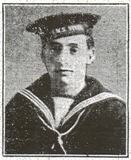
William Voss, Private, 36060, Welsh Regiment. William was born at Llanbetty, Radnorshire. He resided at Haverfordwest prior to the war and enlisted there into the 3rd Battalion, South Wales Borderere. He was posted to France on 5 May 1915, joining the 1st Battalion, Welsh Regiment, which was attached to 84 Brigade, 28th Division. The battalion was at Loos when William joined its ranks. He was killed in action there on 1 October 1915, and is commemorated on the Loos Memorial, France. William is not commemorated locally.
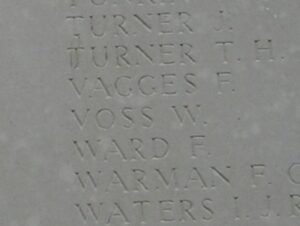
Arthur Follett Walker, Private, 43143, Cameronians (Scottish Rifles). Arthur was born at Haverfordwest in 1895, the son of William and Emily Walker. He resided at Dunoon prior to the war, and enlisted at Greenock into the King’s Own Scottish Borderers, with the Regimental Number 22296. Arthur then transferred into the 1st Battalion, Cameronians, which had been in France since August 1914, and had seen action at Ypres and Loos. On 25 November 1915 they joined 19 Brigade, 33rd Division. The Division moved to France during November 1915, and saw its first major action during the Battles of the Somme, from July 1916 onwards. Arthur was killed in action during the latter stages of the Battle, on 29 October 1916, aged 21. He is buried at Caterpillar Valley Cemetery, Longueval, France. Arthur is not commemorated on the Withybush Memorial.
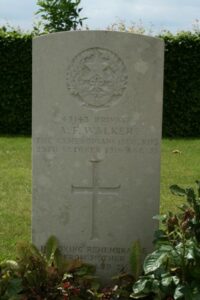
Charles Waller, Private, 14054, Welsh Regiment. Charles was born at Battersea in 1894, the son of Margaret Waller. He enlisted at Haverfordwest into the 9th Battalion, Welsh Regiment, which was attached to 58 Brigade, 19th (Western) Division. The Division assembled around Bulford during September 1914. Divisional training was completed near Tidworth, from March 1915, and the Division crossed to France during July 1915, moving to positions near Loos. The Division fought during the opening attack of the Battle of Loos. Charles was killed a week before the initial assault, on 16 September 1915. He was 21 years old, and is buried at Brown’s Road Military Cemetery, Festubert, France. Charles is not commemorated on the Withybush Memorial, although he is named on the County Memorial.
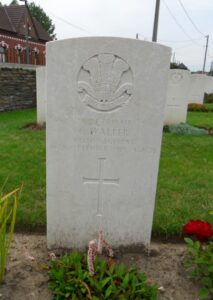
Thomas George Walters, Trimmer, 276/TS, Royal Naval Reserve. Thomas was born at Portfield, Haverfordwest on 18 January 1891, the son of John Walters and Anna Maria Walters (nee Couzens). The family later lived at 224, Neath Road, Landore, Swansea. Thomas was educated at the Cardiff Board School before training as an engineer and served as a 2nd Engineer with the Milford trawler fleet prior to the war. He was a member of the Royal Naval Reserve and was posted aboard HM Trawler Edward VII soon after the outbreak of war. Thomas was killed when Edward VII struck a mine whilst on patrol off the Thames Estuary on 8 September 1915, being flung overboard and drowned. His body later washed ashore, and the 24-year old was buried in Tollesbury (St. Mary) Churchyard, Essex. He is not commemorated in Haverfordwest.
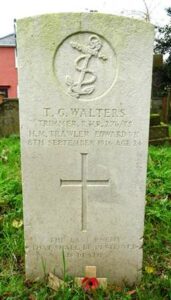
Hugh Ince Webb-Bowen, Captain, Royal Welsh Fusiliers. Hugh was born on 12 February 1878, the eldest son of Thomas Ince Webb-Bowen, late Chief Constable of Pembrokeshire, and Ellen Webb-Bowen (nee Brenchley), of Tenby. He was educated at Haverfordwest Grammar School, before studying law and was admitted to the Bar in 1889. Hugh played rugby for London Welsh as a young man, before enlisting into the army, gaining a commission as Second Lieutenant into the Royal Welch Fusiliers and was drafted to South Africa in 1900 to join the 1st Battalion, Royal Welch Fusiliers, taking part in the Anglo-Boer War, where he gained a reputation for his gallantry. Hugh remained in the army after the war, but was seconded to the South African Constabulary for three years before re-joining his regiment in India. Soon after his arrival he was made Adjutant. He was then transferred to the Head Quarter’s Staff of the Egyptian Army and was stationed at Khartoum, but in July 1914 returned to England and married Evelyn Flora Abercromby McDougal in Kensington on 18 July 1914. The couple were still on honeymoon when war broke out and Hugh was recalled to Khartoum. Evelyn joined him there soon afterwards, but by then the war on the Western Front had stagnated into static trench warfare, so the Allies, at the behest of Winston Churchill, came up with the idea of opening another front in an attempt to take Turkey out of the war. The initial plan was to force the Dardanelles Straits by use of a combined Anglo-French fleet, but severe losses were suffered from mines, so on 25 April 1915 the Allied landed on the Gallipoli Peninsula, intending on crossing over the land and capturing Constantinople. As part of the build up to this invasion, Hugh was despatched to the Mediterranean to join the Head Quarters Staff, landing after the initial infantry assault. He was sadly wounded on Gallipoli during the early stages of the campaign there, and died of wounds on 24 May 1915. The 37-year-old is buried in Lancashire Landing Cemetery, Gallipoli.
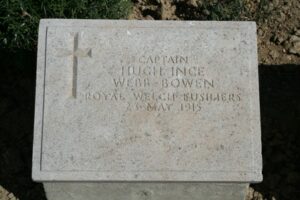
Joseph Gilbert Webb, MC, Lieutenant, Royal Welsh Fusiliers. Joseph was from Burton, and was the Husband of Elizabeth Webb, of Bulmer House, Haverfordwest. He had been commissioned into the Royal Welsh Fusiliers, and served with the 14th Battalion, attached to 113 Brigade, 38th (Welsh) Division. The Division had landed in France during December 1915 and had spent their first winter in the trenches near Armentieres. In June they marched south to the Somme, where they famously captured Mametz Wood. The Division suffered terrible casualties at Mametz, and were taken out of the line, and moved to Ypres to rebuild. Here they fought at the Battle of Pilckem Ridge, and the Battle of Langemarck. They then moved to Armentieres, where they remained from September 1917 until March, 1918 when the German Spring Offensive was launched. The British had been over-run on the Somme, and so in April the Division was moved south, taking up positions North of Albert, from where they weathered the storm of the coming months. Joseph was wounded at some stage in early 1918, and evacuated to a Hospital in Britain for treatment, but sadly died of wounds on 9 May 1918. He is buried at St. Thomas A Beckett Churchyard, Haverfordwest. Joseph was the holder of the Military Cross, for gallantry. Joseph is commemorated at St. Thomas Church, but is not on the Withybush Memorial.
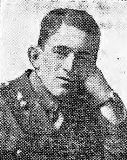
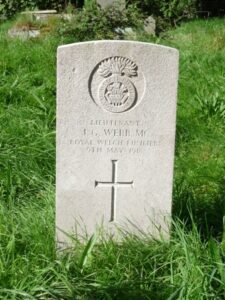
Timothy Whelton, Private, 24410, Welsh Regiment. Timothy was the son of Bartholomew and Mary Whelton of 109, Albert Row, Haverfordwest, and the husband of Mary Jane Whelton, of 43, Heol y Varteg Road, Ystalyfera, Swansea. He enlisted at Cwmgors into the 17th Battalion, Welsh Regiment, which was attached to 119 Brigade, 40th (Bantam) Division. This Division was formed between September and December 1915, and moved to France between 1 and 9 June 1916, moving to the front near Loos. Late in 1916 they moved south to the Somme, and fought at the Battle of the Ancre, and remained in the area over the winter. In March, 1917 the Germans withdrew to their shortened line, called the Hindenburg Line, and the 40th Division was one of the Divisions that followed the withdrawal. Later in the year they took part in the Battle of Cambrai, playing an important role in the attack on Bourlon Wood. Timothy was killed during the Battle of Cambrai, on 25 November 1917, aged 29. He is commemorated on the Cambrai Memorial, Louverval, France.
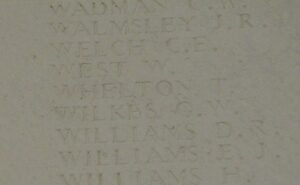
Harry Reginald Williams, Private, 3862, Royal Warwickshire Regiment. Harry was the son of Henry Williams, of 2, St. James Place, Bright Street, Aston, Birmingham. He was the Grandson of William Cook, of Haverfordwest. His father had worked at Haverfordwest, prior to moving to Birmingham. Harry enlisted at Birmingham into the 1/8th Battalion, Royal Warwickshire Regiment, which was attached to 143 Brigade, 48th (South Midland) Division. The Division moved to France between 22 March and 1 April 1915, and moved to positions near Gommecourt. Harry was killed here on 13 April 1916. He was 18 years old, and is buried at Foncquevillers Military Cemetery, France. Harry is not commemorated on the Withybush Memorial.
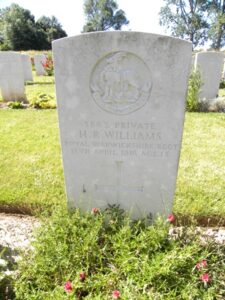
John Williams, Private, 228269, Monmouthshire Regiment. John was the son of Thomas and Martha Jane Williams, of 19, Market Street, Haverfordwest. He was a fish and chip merchant prior to the war, and enlisted at Haverfordwest into the Monmouthshire Regiment in December 1915. John was posted to France on 30 May 1917, and within days was transferred to the 11th Battalion, South Wales Borderers, which was attached to 115 Brigade, 38th (Welsh) Division. He joined the battalion at Boesinghe, where it had held the line since being withdrawn from the Somme in 1916. Here they fought at the Battle of Pilckem Ridge, which is where John was killed on 31 July 1917. He was 22 years old, and is buried at Artillery Wood Cemetery, Belgium. John is commemorated at St. Thomas Church, but is not named on the Withybush Memorial.
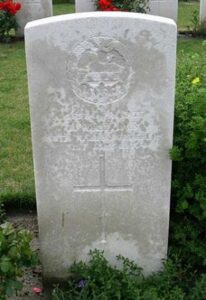
John Lloyd Williams, Private, 2841, Kings Liverpool Regiment. John was born at Haverfordwest, the son of George and Jane Williams, of 2, Castle Square, Haverfordwest. He trained as a school teacher at Carmarthen, and worked at Liverpool Sailors Orphanage prior to the war. John enlisted there into the 6th Battalion, Kings Liverpool Regiment on 9 November 1914. The battalion landed in France on 25 February 1915, and joined 15 Brigade, 5th Division at Bailleul. On 18 November 1915 the Battalion moved to Third Army Troops, and on 26 January 1916 moved to 165 Brigade, 55th (West Lancashire) Division. The Division relieved the French 88th Division south of Arras, where it took part in many raids and minor operations. Relieved by the 11th (Northern) Division on 25 July, the Division moved south and took up a place in the front line opposite the village of Guillemont. Here they fought at the Battle of Guillemont and the Battle of Ginchy. John was wounded here, and died on 9 August 1916, aged 27. He is buried at Guillemont Road Cemetery, Guillemont, France.
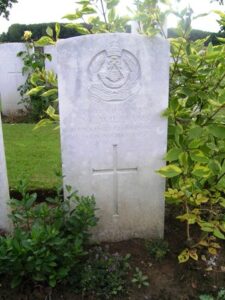
Thomas William Williams, Private, 57188, Royal Fusiliers. Thomas was the son of Martha S. Griffiths, of 1, Commercial Row, Pembroke Dock. He resided at Haverfordwest prior to the war, and enlisted into the 11th Battalion, Royal Fusiliers, which was attached to 54 Brigade, 18th (Eastern) Division. On 25 May 1915 the Division landed in Boulogne, and didn’t see it’s first major action until July 1916 when it took part in the Battle of the Somme. In October they took part in the Battle of the Ancre Heights, and captured Schwaben Redoubt, and helped capture Regina Trench. They then fought at the Battle of the Ancre, and during the subsequent Operations on the Ancre, before spending the winter on the Somme. In March 1917 they followed the German Retreat to the Hindenburg Line, and in May took part in the Third Battle of the Scarpe, which was part of the Arras Offensive. July 1917 saw the Division at Ypres, where they took part in the Battle of Pilckem, where they helped capture Westhoek, and then they fought at the Battle of Langemarck. Thomas was killed here on 10 August 1917, aged 21. He is buried at New Irish Farm Cemetery, Belgium. Thomas is commemorated at St. Thomas Church, but is not named on the Withybush Memorial.
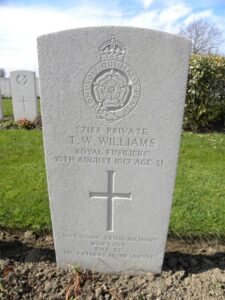
Douglas Jonathan Rogers Wilson, Second Lieutenant, Welsh Regiment. Douglas was born in 1893, the son of James and Constance Ann Wilson, of 36, High Street, Haverfordwest. He was commissioned into the Welsh Regiment, and was posted to the 9th Battalion, which was attached to 58 Brigade, 19th (Western) Division. The Division assembled around Bulford during September 1914. Divisional training was completed near Tidworth, from March 1915, and the Division crossed to France during July 1915, moving to positions near Loos. The Division fought during the opening attack of the Battle of Loos, which is where Douglas was killed on 25 September 1915, aged 22. He has no known grave, and so is commemorated on the Loos Memorial, France.
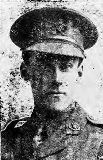
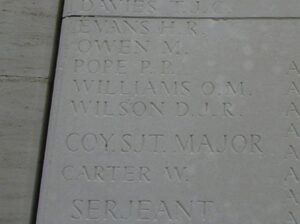
George Edwin Wilson, Private, 51152, Cheshire Regiment. George was born at Kempsey, Worcester in 1895, the son of Charles and Elizabeth Wilson. By 1911 his family had moved to Withybush, and George was residing at Park House, Haverfordwest, working as an agricultural labourer. He enlisted at Swansea on 14 June 1915 into the Army Service Corps, and on 19 May 1916 landed in France with 302 M.T. Company. On 24 September 1917, George was transferred to the 1/6th Battalion, Cheshire Regiment, which was attached to 118 Brigade, 39th Division. The Division had been in France since early March 1916, and had taken part in the Battle of the Somme in the summer of 1916. George joined the battalion at Ypres, and fought during the Battle of Passchendaele. During the beginning of 1918 the division was stationed near St. Quentin, and was one of the Divisions to be hit hard here by the German Offensive which was launched on 21 March 1918. It fought here at the Battle of St Quentin, and took part in desperate fighting on the Somme Crossings and the Battle of Rosieres. George was killed in action during this traumatic period, on 30 March 1918, aged 22. He has no known grave, and is commemorated on the Pozières Memorial, France.
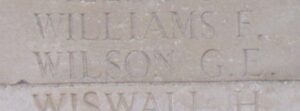
Charles Rupert Woolcock, Private, 200131, Welsh Regiment. Charles was the son of James and Elizabeth Woolcock, of 2, Dark Street, Haverfordwest. He served with the 1/4th Battalion, Welsh Regiment, which had formed at Carmarthen during August 1914 and had become attached to 159 Brigade, 53rd (Welsh) Division. The Division moved to the Mediterranean, sailing from Devonport in July 1915 arriving at Mudros by 5 August 1915. From here they moved to Gallipoli, landing on 8 August 1915. Here they immediately faced the chaotic leadership that was to lead to the ultimate failure of the campaign, and spent the next few days in isolated pockets, fighting against a Turkish counter-attack. The Division remained here throughout the coming months, and suffered severe losses in manpower strength during the great November 1915 blizzard on Gallipoli, when its total strength was reduced to less than that of a full-strength Brigade. On 11 December 1915 the Division was evacuated to Mudros, and by 23 December 1915 were moved to Egypt. They remained on the Suez Canal Defences for the next twelve months, and in early 1917 moved into Palestine, where they remained for the duration of the war, fighting at the Battles of Gaza, and successfully capturing Jerusalem. Charles was killed in action during the Third Battle of Gaza, on 4 November 1917. He was 21 years old, and is buried at Beersheba War Cemetery, Israel.
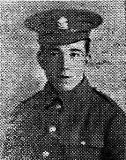
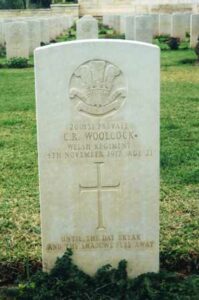
Charles Wren, Company Sergeant Major, 9242, Welsh Regiment. Charles was born at Tottenham. He married Lilian Mary Stephens at Haverfordwest in January 1913, probably whilst based at Llanion Barracks with the Welsh Regiment. Charles served with the 1st Battalion, Welsh Regiment. The Battalion was in India at the outbreak of war, and was recalled to Britain where it joined 84 Brigade, 28th Division. The Division formed in England between December 1914 and January 1915 from regular units returning from India, Singapore and Egypt. During January 1915 it moved to France, landing at Le Havre and moved to the Western Front, where it saw its first major action during the Second Battle of Ypres. Following serious casualties at Ypres, a Composite Brigade was formed, composing of the 2nd Battalion, the Buffs, 2nd Battalion, the Cheshires, 1st Battalion, the Welsh, and 1st Battalion, the York and Lancaster. Charles was one of the many casualties suffered at Second Ypres, on 24 April 1915, aged 26. He has no known grave, and so is commemorated on the Ypres (Menin Gate) Memorial, Belgium.
